Australian
and international
exploratory
performance and
media arts
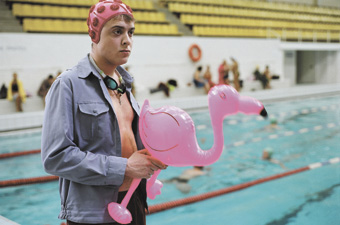
Yuri Chursin, Playing the Victim
RUSSIANS SEE THINGS A LITTLE DIFFERENTLY FROM WESTERNERS. TO THEM, LIFE IS BLEAKER, STUPIDER, DEEPER, FUNNIER AND ALWAYS MORE ‘HUMAN.’ THEIR FILMS REFLECT THIS PERSPECTIVE. THERE IS ALWAYS AN AUDACITY IN RUSSIAN CINEMA. EVERYTHING SEEMS TO BE HANGING, TENUOUSLY ABOVE AN OCEAN OF CHAOS. IN AUSTRALIA, WHERE LIFE IS TOO SAFE AND EASY, IT’S LIBERATING TO OBSERVE SUCH ARTISTIC RECKLESSNESS. RUSSIAN FILMS CAN SHAKE OUR BENEVOLENT PLATITUDES, REAWAKENING OUR SENSE OF COLD, INVIGORATING REALITY. FORTUNATELY, THE 2007 ADELAIDE FILM FESTIVAL WILL BE SHOWCASING SIX DIVERSE EXAMPLES OF NEW RUSSIAN FILMMAKING TO REMIND US OF THE POWER OF THIS INIMITABLE NATIONAL CINEMA.
At the top of the list in this year’s season is Alexander Sokurov’s The Sun (2004). For the uninitiated, Sokurov is the most accomplished filmmaker working in Russia today, largely known in Australia for his single-shot historical panorama Russian Ark (2002). The Sun presents the third instalment in his Men of Power series. Following depictions of Hitler in Moloch (1999) and Lenin in Taurus (2001), The Sun focuses on the life of Japanese Emperor Hirohito in the days leading up to his capitulation to the US led invasion in 1945. A biography of sorts, it follows Hirohito (Issei Ogata) through the twisted layers of his character, through its defects and peculiarities, towards the moment when he will renounce his sanctified divinity as a sun god for the sake of international peace and personal happiness.
A controversial work, Sokurov’s film has generated considerable hostility in many countries, particularly in China where its sympathetic depiction of Hirohito has been received as an insult to the victims of Japanese atrocities. Indeed, as historical record, The Sun is at best problematic. But history is not the film’s real interest. What Sokurov captures is not the life of a man as normally understood, but rather the bare emotional imprint of a life, of a human animal clothed in an illusion of ritualised power and sickness. The style reflects this concern. Green-brown sepia images and warped, fluctuating proportions conjure disease or hallucination. Hirohito himself notes an ever-present “bad smell and bad taste”, sensations exacerbated by the score’s remarkable arrangement of music and noise into a low intestinal drone. Like the best of 19th century Russian literature, Sokurov reveals the aura or tone of each scene, isolating the human experiences within it. Perhaps the film’s greatest asset is the actor Ogata. His performance as Hirohito is quite unlike any I have ever witnessed, not so much that of a psychology as of a soul: anguished, silent and invisible. These qualities give The Sun an artistic value rarely matched in contemporary filmmaking.
Pavel Lunguin’s The Island (2006) belongs to the same school of Russian filmmaking (one traceable to the influence of celebrated director Andrei Tarkovsky). A less complex film than The Sun, The Island is a character centred study of sin and redemption. Having washed up on the shores of a remote monastery, Father Anatoly (Petr Mamonov) spends his life segregated from the rest of the order as an eccentric prankster and mystic. He administers to the sick, plays tricks on other priests and makes a general mockery of Orthodox ritual, all to encapsulate a genuine example of Christian faith: devotion to God and nothing else. But the pain of his past sins will not go away. Impressively shot on a lavish budget, The Island is propelled by a wonderful performance from Mamonov, whose Anatoly humanises the script’s religious concerns with compassion and warmth. It’s a serious film, but accessible.
In a totally different realm is Kirill Serebrennikov’s black and dry comedy, Playing the Victim (2006), recently voted Best Film at the Rome Film Festival. Previously anonymous as a filmmaker, Serebrennikov has experienced considerable success over the past ten years as a theatre director of contemporary and usually scandalous Russian plays. His new film sees him bringing one such work to the screen, Playing the Victim by brothers Vladimir and Oleg Presnyakov. It begins unabashedly: “Russian cinema is in big shit. Only Fedya Bondarchuk is a cool guy. Fedya is cool. His father got an Oscar. And he’ll get one. He’ll get stronger and get one for sure.”
To those in the know the message is clear. This is anti-Tarkovsky, a film concerned only with this life. It is the story of Valya, a near thirty-year-old boy, university graduate and emblem of a new way. Valya works for the police. His job is to stand in for the dead during re-enactments of homicides. It’s cushy work and pays enough for his new toys and clothes. But Valya’s real interest is in revenge: on his mother and uncle who now share his dead father’s bed, and on an entire generation of Russians busy reacquainting themselves with national arrogance. He endorses something else entirely, the cultural ambivalence of anything and everything. Valya practices his gangsta moves, eats blackberries with chopsticks and embraces suicide chic with the best of them. To generations X and Y his stance will be a familiar one. “Ideals don’t exist”, the film’s director has claimed, “and it would be good to have a great deal more common sense…I don’t think we have our own special path or destiny” (The Moscow Times, June 9, 2006). The Russian cultural elite will be rolling in their graves.
Everyone knows that Slavs are the best at being seriously idiotic and First on the Moon (2005) proves it in spades. A mockumentary by Alexei Fedorchencko, it lets us in on a big secret. While many of us are aware that Neil Armstrong’s famous giant leap was filmed in a television studio, few of us have known the whole truth until now. The real, bona fide Moon landing was an unadulterated Stalinist invention. Encased within a prototype interstellar projectile, a small handpicked elite of heroic workers, athletic beauties and limber midgets shot to the Moon on March 16th 1938, returning to Earth one week later as a meteor that landed in a remote alpine region of Chile. The crew survived, its superhuman leader Ivan Kharamalov evading Soviet authorities by assuming multiple identities. He eventually became star of a popular regional circus troupe in a vibrant retelling of Alexander Nevsky. If you don’t believe me go and see First on the Moon yourself. This is a brilliant and hilarious film with fantastic black & white imagery. It won best documentary at the 2005 Venice Film Festival.
At the other end of the truth spectrum is Sergei Loznitsa’s documentary Blockade (2005). Winner of 6 international prizes, Blockade comprises newsreel footage from the 900-day siege of Leningrad (1941-44) during which up to 800,000 Russians died. Choosing to let the footage speak for itself, Loznitsa couples the images only with a minimal soundtrack of effects. For 52 minutes we watch silently on the domestic consequences of war. It is a harrowing and starkly pertinent experience for anyone still unsure about the viability of military invasions.
Finally, Andrei Kravchuk’s The Italian (2005) fulfils an all too often neglected role in festival programs. It’s a children’s film, most suitable for 12-15 year olds. It tells the story of Vanya, a five-year-old living in a dilapidated Russian orphanage. Vanya is lucky. From the dozens of boys surrounding him he has been chosen for adoption by a childless Italian couple. In only a month it’ll be beaches and gelato. But Vanya doesn’t feel lucky. He wants what is his. With a gritty resolve and a knack for language he escapes the orphanage and embarks on a journey to find his real mother. Like the best children’s films, The Italian layers its adventure story with a sophisticated social analysis, presenting a cross-section of Russia’s past and present through the lens of Vanya’s unclouded eyes. It won Best Children’s Film at the 2006 Berlin International Film Festival.
Adelaide Film Festival, Feb 22-March 4,
www.adelaidefilmfestival.org
RealTime issue #77 Feb-March 2007 pg. 19
© Tom Redwood; for permission to reproduce apply to realtime@realtimearts.net
THE ADELAIDE-BASED ZEPHYR QUARTET IS CARVING A NAME FOR ITSELF WITH AN AMBITIOUS PROGRAM OF PERFORMANCES THAT INCLUDES A FEW STAPLES OF THE STANDARD REPERTOIRE, A LOT OF NEW MUSIC MORE OR LESS TRADITIONALLY CONCEIVED FOR QUARTET, AND WORKS INVOLVING ELECTRONICS (RANGING FROM TECHNO TO EXPERIMENTAL), IMPROVISATION AND FORAYS INTO VARIOUS ETHNIC AND POPULAR GENRES.
<img src="http://www.realtime.org.au/wp-content/uploads/art/3/304_whittington_zephyr.jpg" alt=" Belinda Gehlert, Emily Tulloch,
Anna Webb and Hilary Kleinig, Zephyr Quartet”>
Belinda Gehlert, Emily Tulloch,
Anna Webb and Hilary Kleinig, Zephyr Quartet
photo Steven Donovan
Belinda Gehlert, Emily Tulloch,
Anna Webb and Hilary Kleinig, Zephyr Quartet
In the world of classical music the string quartet has accumulated more intellectual prestige than any other genre. Invented by Haydn and perfected by Mozart, its primal form was the perfect musical embodiment of Enlightenment ideals. Abandoning Baroque rhetoric of public address, the quartet became the intimate conversation of equals in which rational argument and wit were the principal virtues. The equality of the four instruments accorded with the emerging ideals of liberal democracy, representing a condition that all might aspire to, given the appropriate education—that of the cultivated, enlightened individual, engaged in harmonious social intercourse with like-minded equals.
The 19th century hijacked this ideal in the name of Romantic individualism, giving it an altogether more emotional hue. The Romantic cult of Beethoven did much to place the string quartet at the pinnacle of the musical pantheon. Beethoven’s late quartets became a cornerstone of the myth of the heroic, misunderstood artist that Beethoven personified. And the quartet has remained, essentially unchallenged, at that pinnacle ever since. In Australia, the string quartet has flourished under the patronage of Musica Viva, an organisation largely founded by post-War refugees from central Europe, with a subscriber base drawn from the professions, the educated middle classes and a wealthy elite. Most quartets touring the country under the Musica Viva banner are imported; Australia has rarely, if ever, managed to support more than two full-time, professional quartets at any given time. Even now, following the Byzantine intrigues that have led to the former Australian String Quartet becoming the Grainger Quartet and the former Tankstream Quartet becoming the Australian String Quartet, it is by no means certain that both ensembles will survive for the long haul.
Traditional classical ensembles of all kinds from the orchestra down face a struggle for survival, and are trying in many cases desperately to re-invent themselves for a cultural landscape that has radically changed in the past couple of decades. A significant broadening of the repertoire—some would call it dilution—including a rapprochement with popular music, has been the most popular survival strategy. Australia’s newly privatised symphony orchestras provide good examples of this process at work.
Zephyr Quartet consists of Belinda Gehlert and Emily Tulloch (who rotate as first and second violins), Anna Webb (viola) and Hilary Kleinig (cello). At least two of the players (Gehlert and Kleinig) have also composed for the ensemble. In the course of 2006, the Quartet has shown itself to be as inventive with its venues as it has with its programs, appearing at a commercial art gallery, an inner-suburban pub, a city club, a bar in Adelaide’s sin strip and the rehearsal studio of a contemporary dance company.
The biggest challenge facing classical ensembles who want to embark on this sort of path is that nothing in their training has really prepared them for it. The road to becoming a quartet is difficult enough, given that much classical musical education is predicated on the paramount importance of the soloist; a deep understanding of the essence of chamber music is often relegated to a relatively minor part of the curriculum. Beyond that, few institutions would give classical string players any more than token exposure to jazz or popular music, teach them anything more than the most rudimentary techniques of composition, train them in any form of improvisation, or equip them with skills to handle new technologies. Poorly served by an educational ethos inherited from the 19th century, young musicians of the 21st century are compelled to find their own way.
Michael Nyman’s String Quartet No.2 was the major work in Zephyr’s Musica Viva Menage Concert Series outing, From Tango to Techno, in the Leigh Warren and Dancers Studio (Sept 14). It was the only work on the program to involve dancers, and was performed in the round, with the Quartet also changing positions for each movement. The choreography of dancers and musicians formed an intriguing, visually engaging counterpoint to the characteristically frenetic music of Nyman. The quartet playing was rhythmically strong though a little wayward in intonation.
A couple of techno pieces in that program (by Gehlert and Kleinig) set the scene for a more extensive collaboration with electronics when Zephyr appeared at the Rocket Bar in Hindley Street in their Electro-Acoustic Project (Sept 29). The composers this time included Zoë Barry, Cameron Deyell, Fiona Hill, Stefan Panczak, Brendan Woithe, Michael Yuen and Kleinig. The music was stylistically diverse, ranging from a strongly conceptual piece by Yuen through to a techno-influenced work from Stefan Panczak. The use of technology was well short of what is currently possible, particularly in terms of interactivity and real-time processing. The players were also obliged to listen more closely to the electronic tracks they had to play with than to one another. As so often happens (from Kronos Quartet to pop-classical girl group Bond, the story is much the same) the ideal of chamber music as an intimate discourse between individuals was largely lost when amplification, technology and the performance practice of popular music took over.
That ideal made a bit of a comeback at Zephyr’s next appearance, Generation Next, at the Jade Monkey (Oct 19), a rather pleasant little club in a quiet side street in the city centre. A diverse collection of works by Adelaide composers Jamie Messenger, Anne Cawrse, Melisande Wright, Angus Barnacle, Luke Altmann and Tristan Coleman provided an opportunity to ponder different contemporary approaches to the medium. Young composers seem to regard the quartet as a palette of sounds rather than a social microcosm and the dynamic potential of the quartet medium was only superficially explored for the most part. Nonetheless, it was an interesting evening, with solid performances and a few pieces—such as that by Luke Altmann—that sought to probe some emotional depth.
Zephyr Quartet is an adventurous young ensemble, though there are limits to their adventurousness, and I don’t expect to hear them playing some genres of highly demanding and complex contemporary music. They are more at home in the world of minimalism, neo-tonality and crossover genres. They are certainly performing a valuable service for Adelaide composers, and are providing audiences with varied and at times provocative listening experiences as they explore possible directions for classical music’s most venerated ensemble.
Zephyr Quartet’s 2007 program includes: Homegrown—The Music of Annne Cawrse a celebration of music composed by Cawrse for Zephyr, Carclew Arts Centre, March 30; between music, place, memory and emotion: folk songs and new compositions by Hilary Kleinig and Belinda Gehlert inspired by the work of Adelaide-based Iraqi-born poet Yahia Al-Samawy, with percussionist Tim Irrgang, Nexus Cabaret, Lion Arts Centre, July 6; Sight Specific Music: Phillip Glass String Quartet No 2 and new commissions composed by Graham Dudley and James Cuddeford, Greenaway Art Gallery, Oct 26, 28 www.zephyrquartet.com
RealTime issue #77 Feb-March 2007 pg. 49
© Stephen Whittington; for permission to reproduce apply to realtime@realtimearts.net
FORMALLY TRAINED AS A COMPOSER AT ADELAIDE'S FLINDERS STREET SCHOOL OF MUSIC, TRISTAN LOUTH-ROBINS WENT ON TO COMPLETE AN HONOURS DEGREE WITHIN THE ELECTRONIC MUSIC UNIT (EMU) AT THE UNIVERSITY OF ADELAIDE. DURING THIS TIME HE GREW INTERESTED IN PHASE RELATIONSHIPS AND THE IMPACT OF PLAYBACK TECHNOLOGY ON COMPOSITION. HE CITES THE ALBUM ZAIREEKA BY THE FLAMING LIPS AS THE INSPIRATION FOR HIS THESIS RESEARCH.
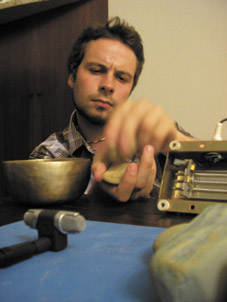
Tristan Louth-Robins
Created by playing four CDs simultaneously, Zaireeka, he explains, is a generative composition “utilising the technical features and potential of the technology—CD players—in order to create phase relations: either by accident or the inherent characteristics of the technology.”
This fascination with ‘accidental’ music and phase relationships led to a creative partnership with sound-artist Sebastian Tomczak. Together they formed The Glitch Collective, a loose ensemble of sound artists and musicians gathering to produce a series of spontaneous compositions using pre-recorded material: “We wrote the first couple of scores very much in the vein of the early Fluxus scores of the 1960s; very text-based. The first one we did was Glitch: a free-for-all which lasted an hour, where we were each assigned to write one minute of any sound material we wanted.” The result surprised its makers: with contributions variously at high pitch or low frequency ranges and with multi-tracking of all the sounds there was “a wonderful fullness [that] coloured the environment…We found that each of the sounds would fall in and out of synch with each other because the repeat times on the CD players are different. So that’s how you create phase relationships.” He thinks that general listener finds the result pleasing “because it’s made up of these little musical ostinatos.”
The basic principal of phase relationships used in Glitch, he notes, was also the one employed by Brian Eno to produce Music for Airports, composed from phasing loops of pre-recorded material on magnetic tape, cut to different lengths and therefore cycling at different rates. Eno created the piece in order to counter the impersonal nature of airports. Environments, whether built or natural, and their sound qualities and aural ecology, is a growing interest for Louth-Robins.
In a recent collaboration with the SHOOT collective, Louth-Robins produced the sound score for their video installation, Sounds from Level Four, an ominous piece about paranoia and social confinement using the central motif of an elevator to induce the feeling of claustrophobia and controlled movement. The sound moves from complex rhythms of cut-up vocals through to hydraulic elevator sounds, blistering glitches and sweet machine-like harmonics.
“The conceptual process…took quite a long time…probably close to three to four months developing an idea of how we would marry the visual and sound elements. I didn’t produce any sound per se until two months before it was first exhibited. I wasn’t necessarily gathering lots of audio samples and sticking them together and seeing how that sounded. If anything I was just writing down words that I would associate with the video and trying to find some kind of parallel to a sound or particular atmosphere.” On the issue of ‘machine aesthetics’ he was particularly pleased that he had created the score without relying on reverb. “I’d grown to hate an over-reliance of reverb in order to create the impression of space. I think there are other ways that you can evoke space.”
I had always attributed this penchant for reverb to the ‘wall of sound’ introduced by Phil Spector. Louth-Robins claims a later, far more sinister origin: “I think it’s partly to do with Phil Collins inventing the drum reverb in the 1980s. It’s that snare reverb. You listen to anything from the 1980’s and it’s there in some capacity.”
Louth-Robins is currently extending his interest in environmental sound design, using composition as a way of crossing over into ecology, influenced partly by his meeting with environmental musician and sound artist Robin Minard: “I was fortunate enough to meet Robin at the start of 2006 when I was involved with Michael Yuen’s Project 3, and spent some time with him setting up his Silent Music installation. My current interest is in natural phenomena and sound’s relationship to them, which is inextricably tied to the work of Alvin Lucier and Rolf Julius.” It also relates to the ideas of sound theorist and ecologist R Murray Schafer.
“Schafer looks at the particular characteristics of a natural environment, referring to these as sound marks: sounds that characterise the environment in a particular way. If you were to go down to a lake and hear the continuous sound of crickets and the intermittent chirps of birds, the water [lapping], they are always going to be there to a certain extent. What Schafer did was to start mapping these things out over the space of a year, so he could track the migratory patterns of the birds, or if the wildlife was diminishing or moving somewhere else.
“I’m specifically interested in the relationship between natural and industrial sounds. Such investigations involve making field recordings of various environments and assimilating excerpts into a collage, installation or [other] context. They stem from two main sources: the continuum of ambient sound—such as wind sounds and machine drones—and more instantaneous sounds which are characteristic to an environment, such as the croaking or frogs or a passing tram. This creates an interesting juxtaposition of sound sources and evokes a sensation, what writer David Toop [citing Schafer] describes as ‘schizophonia’, essentially sounds displaced from their point of origin. This is nothing new in terms of hearing transmitted or recorded sounds over the radio etc, but the displacement and juxtaposition of environmental sounds can significantly alter a listener’s perception. I am looking to apply this idea in an installation sometime over the course of the year.”
While interested in the objective appreciation of environmental sound, Tristan Louth-Robins says he is “still keen though on the idea of putting some kind of subjective intention into my work. I think maybe I’m just a little too much of a traditionalist. But if you put too much subjectivity into a piece—particularly a site specific installation that articulates a particular environment—then you can cloud the audience response with too much musical information.”
Glitch Collective archives: www.geocities.com/glitchtogether/
RealTime issue #77 Feb-March 2007 pg. 50
© Samara Mitchell; for permission to reproduce apply to realtime@realtimearts.net
For their latest program of new music Dead Horse Productions have moved from the carparks, warehouses and Meat Market of previous outings to the old Forum cinema (formerly the 1929 State Theatre, more recently a Christian Revival Centre) on Flinders Street with its Moorish Revival exterior (a style resurgence rather than a religious one) and neo-classical interior. Dead Horse Productions, who brought Melbourne audiences the adventurously programmed Concave City and New Works for Music and Film, now present Ground Elastic Sound.
The Dead Horse Ensemble, conducted by the globe-trotting Ben Northey, will play compositions by David Chisholm (from his score for balletlab’s Origami, now out on Move Records), Biddy Connor (vocalist, instrumentalist and accomplished composer for film), Wally Gunn (composer for visual arts, theatre and film and instrumentalist commissions), Peter Knight (composer and trumpet player with his own jazz quartet) and Kate Neal (composer and artistic director of Dead Horse Productions), fresh from her artist-in-residence stint in the US working with acclaimed US composer Syd Hodkinson and writing material for Ground Elastic Sound.
Ground Elastic Sound promises “to appeal to fans of rock, jazz, electronica and classical music.” The ensemble, with elements of laptop and pre-recorded sound, will feature leading players in classical and jazz, including Tristram Williams (trumpet), Miki Tsonuda (violin), Adam Simmons (sax) and Anita Hustas (double bass). RT
The Forum Upstairs, Melbourne, Feb 23, 8pm
RealTime issue #77 Feb-March 2007 pg. 50
© RealTime ; for permission to reproduce apply to realtime@realtimearts.net
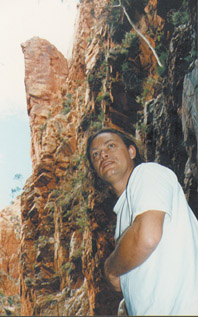
Michael Riley
MICHAEL RILEY IS PRIMARILY KNOWN AS A PHOTOGRAPHER, SO IT’S NO SURPRISE THAT HIS BEST KNOWN FILM, EMPIRE (1997), IS ALSO THE ONE MOST OBVIOUSLY ALIGNED WITH THE STYLE OF HIS LATE STILL PHOTOGRAPHY. YET IT IS THE LESSER KNOWN HALF-HOUR DOCUMENTARIES RILEY MADE FOR SBS AND THE ABC THAT HAVE HAD THE MOST SIGNIFICANT IMPACT ON THE DEVELOPMENT OF AUSTRALIAN INDIGENOUS FILM.
The Australian National Gallery retrospective, Michael Riley: sights unseen, provides a rare opportunity to consider Riley’s screen work alongside his stills and brings to light some surprising correlations. Both his films and photographs employ a broad spectrum of styles, but the exhibition reveals no clear cut division between his work in the two mediums. Rather, it creates the impression of two distinct strains that cut right across Riley’s entire artistic output. On the one hand his portraiture and documentaries rely primarily on the camera’s relationship to the physical reality before the lens—the look in a subject’s eyes, the way they hold themselves, and the stories they relate to the camera. On the other hand, Riley’s more overtly abstract work relies heavily on the relationship between deliberately ambiguous images, the symbolic resonances of collected objects and the formations of the natural world.
Empire (1997) epitomises the latter strand of Riley’s oeuvre. Originally commissioned for the Festival of the Dreaming program in the lead up to the 2000 Sydney Olympics, the film went on to appear in exhibitions and arts festivals around the world. Opening with a giant eye superimposed on a cloud-specked sky, Empire unfolds as a series of images depicting the Australian landscape as a parched country devoid of human presence. Animal skeletons lie stripped and scattered on the ground; an echidna’s corpse is beset by swarming ants; a windmill spins forlornly beside two water tanks, incongruous in a land without moisture. Towards the end of the film remnants of a decaying colonial dream appear: a weather-beaten Union Jack flutters across a blue sky, a mirrored crucifix reflects passing cloud, and a burning cross evokes the dark side of the colonial project. Finally, the camera rests on a tacky ‘noble savage’ figurine of an Aboriginal man. A disembodied voice from a newsreel or ancient radio broadcast crackles in a polite British accent that belies the culturally genocidal implications of the words: “Keeping untouched natives away from white settlements where they would perish like moths in a light, replacing…their ancient beliefs…with a higher faith—the Christian faith. Training them in a benevolent segregation…gradually to make them fit into an Australian community.”
Like the concomitant photographic series, Flyblown, Empire explores the impact of European invasion on the Australian continent and its people, but unlike the photographic series, the film also illustrates the way in which Riley’s more symbolist tendencies could become heavy-handed when rendered on screen. A series of photographs can be viewed, digested and returned to in any order, creating between them a site of floating exchange crucially informed by the viewer. In Empire the images are inevitably fixed; their interpretive potential can feel foreclosed. However, it is the film’s overbearing and self-consciously ethereal music that does most to make Empire’s air of mystery feel laboured, reinforcing the sense that for all the images’ indeterminate nature, our reading is being firmly guided.
For me, Riley was more effective as a filmmaker when exploring his documentary bent in films like Blacktracker (1996), Tent Boxers (1998) and Quest for Country (1993). These typify the rehabilitative historical impulse underlying much of Riley’s documentary work. In different ways, they all seek to unearth the buried threads of Indigenous experience woven into Australia’s social, cultural and political history.
Blacktracker was made for ABC TV and examines the life of Riley’s grandfather, who served in the NSW police force from 1911 to 1950. Rising to the rank of sergeant, Alec Riley became one of the best known trackers in the country. He was instrumental in solving at least seven murders and located many people lost in the bush during his time on the force. Despite relying a little too heavily on re-enactments to make up for an absence of relevant historical footage, Blacktracker succeeds admirably in bringing Alec Riley’s story to life and portraying a warm and sensitive man who “achieved in a time of extreme adversity.” It is a positive story, but one tempered by the times in which Alec Riley lived. According to his descendants, for example, he was never awarded a police pension, despite making contributions to the pension fund throughout his working life.
The prejudices Tracker Riley encountered also adversely affected others, a point tragically illustrated by the case of a two-and-a-half-year-old boy named Desmond Clarke who went missing in the Pilliga scrub in the early 1930s. Riley was summoned to assist in tracking the boy down but his grandfather “didn’t want any blacks on his property.” Consequently the search party was unable to find the missing child. A year later the boy’s grandfather passed away and Riley returned to the area; within 12 hours he had located Desmond’s remains in a chalk pit 500 metres from the family homestead. This story later provided the inspiration for Rachel Perkins’ film One Night the Moon (2000).
Two years after Blacktracker, Michael Riley made Tent Boxers for the ABC, another film looking at Indigenous men working in a time of institutionalised racism. The boxers of the film’s title were amateur fighters who until the early 1970s toured with country fairs, slugging it out with any locals willing to take them on. Inevitably many of the boxers were Indigenous youths looking to make some money and escape highly segregated country towns. They were expected to participate in up to fifteen fights a day in large circus tents strewn with sawdust and jam-packed with onlookers. In return they received some money and the rare opportunity to travel Australia. As one pair of fighters fondly recall, there was also the attraction of ardent female fans. Riley interviews a range of former boxers, intercutting their recollections with archival footage of the fairs and the fights, creating a vivid portrait of a distinct social and historical milieu shot through with humorous tales and memorable characters. The film exemplifies documentary’s ability to bring to light prosaic, small scale stories bypassed in ‘big picture’ social histories, revealing much about the everyday minutiae of a particular period.
Both Tent Boxers and Blacktracker remain within well established television documentary forms, but the earlier Quest for Country (1993) provides a rare example of Riley pursuing a degree of formal experimentation in one of his documentaries. Quest for Country is structured around Riley’s journey to the areas his father and mother are from around Dubbo and Moree. Like Empire, the film explicitly explores an Indigenous way of viewing the land and the stories the land holds. It begins with Riley driving through and observing the streets of Sydney before he passes out of the city, over the Blue Mountains and across the western plains. His gaze is intercut with a jarring visual and aural montage of sirens, screams and photographs of smug colonial settlers staring resolutely from fading 19th century photographs. Paintings of massacres cut across apparently empty tracts of western NSW, short-circuiting whitewashed accounts of our colonial past. Interspersed with his historical ruminations, Riley presciently describes a country facing ecological disaster, explicitly linking environmental ruination with European denial of Indigenous knowledge. Throughout we constantly return to Riley’s gaze reflected in his car’s rear-vision mirror. It’s a gaze that looks both forward and back in time, anchoring the film’s perspective while also turning Riley’s stare back on the viewer. Through this subtly reflexive device, the filmmaker quietly but forcefully asserts his presence, and the presence of the stories he tells, in the country through which he passes.
The late Charles Perkins famously commented, “We know we cannot live in the past, but the past lives with us”, and it is Michael Riley’s pioneering exploration of this theme in documentaries like Quest for Country that is his most lasting influence on the current generation of Australian Indigenous filmmakers. Ivan Sen’s work in particular displays a strong thematic kinship with Riley’s films. It is through the work of artists like Riley and the filmmakers he has inspired that non-Indigenous Australians might begin to understand something of our country’s deeply repressed Indigenous history and what this history means for our contemporary situation. Until these stories are heard and acknowledged, and their implications understood, we’ll forever be like two-year-old Desmond Clarke stumbling around, lost in the Pilliga scrub, unable to make sense of the land in which we live.
–
Michael Riley: sights unseen, curated by Brenda L Croft, National Gallery of Australia, Canberra, July 14-Oct 16; Monash Gallery of Art, Vic, Nov 16 2006-Feb 25 2007; Dubbo Regional Gallery May 12-July 8 2007; Moree Plains Gallery, May 19-July15 2007; Museum of Brisbane, July 27-Nov 19 2007; Art Gallery of NSW, 22 Feb 22-April 27 2008
Part 1 appears in RT76
RealTime issue #77 Feb-March 2007 pg. 15
© Dan Edwards; for permission to reproduce apply to realtime@realtimearts.net
IN DEATH 24x A SECOND, SEMINAL 1970S FILM THEORIST LAURA MULVEY RE-THINKS THE VIEWER’S RELATIONSHIP TO THE MOVING IMAGE IN THE DIGITAL ERA. SHE DESCRIBES A NEWLY EMPOWERED GAZE THAT NAVIGATES WITH UNPRECEDENTED FACILITY THE DETAILS OF INDIVIDUAL FILMS AMID AN INCREASINGLY AVAILABLE CINEMA HISTORY.
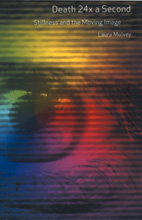
the digital gift of death
As DVD releases continue the vast rollout of the 20th century’s image history, Laura Mulvey begins her new book with the idea that cinema can be seen as increasingly peopled by spectres. Increasingly we watch characters on screen played by deceased stars and see films by seminal directors whose collected works are being re-born into digital life after they are themselves long gone. Celluloid itself is fast facing extinction; hence ‘cinema’ in its century-long incarnation is dead or dying. From these ashes Mulvey describes the ramifications of new ways of watching and conceiving films since the advent of domestic VCRs, a process intensified by DVD. Dead film meets new technology, “bringing, almost incidentally, new life to the cinema and its history.”
More precisely and theoretically, Mulvey is very interested in the way the new technologies enable and even encourage the remote control-wielding viewer to see figurative death in the form of the still or slowed image extricated from narrative movement. Replaying sequences and freeze-framing particular shots, for Mulvey, enable a significant re-making of the film away from its original organisation towards a more malleable, stretched and fragmented form that opens up a new engagement with “the presence of death.”
The new viewer-image relationship in this analysis enhances our perception of cinema’s rendering of the irrational and the pre-modern. This opens the way for Freud to be introduced into the story, a theoretical commitment Mulvey has maintained since the 1970s despite the extensive critiques of psychoanalytic theory in Film Studies over the last two decades. She starts with a telling early 20th century opposition that she suggests comes tellingly unstuck in the 21st: while Freud himself was dubious about cinema for celebrating modernity’s “novelty, speed and glamour”, to present-day eyes “the cinema [now] seems closer to Freud’s uncanny of the old and familiar, and … the archaic.”
back to the archaic
A chapter on Hitchcock’s Pyscho (1960) overcomes the reader’s initial we’ve-been-here-before scepticism serving well Mulvey’s argument that cinema’s predilection for irrationality, the archaic and death is all the more noticeable for the 21st century viewer. Treated as aesthetically ‘modern’ compared to Hitchcock’s previous melodramatic and theatrical presentation of murder, the famous shower scene’s primary importance here is in conceptually killing off the fashionable, sexualised female body, and hence the modernity Freud dismissed, instead enforcing the ‘dead’ body of the mother whose archaic psychic power persists beyond death. Mulvey therefore emphasizes at length the elaborate post-murder camera manoeuvre—from the modern woman’s naked body, accoutrements (and money) in the motel room, up to the old house—as inaugurating a circular movement away from civilisation’s straight lines and linearity seen earlier (notably with the highway sequence), back into primal darkness.
The connection with post-celluloid technology is then addressed via a discussion of Douglas Gordon’s art installation 24-Hour Psycho (in which the original film is ‘stretched’ over 24 hours), illustrating how the trajectory away from movement and towards death is made all the more palpable when the film’s narrative momentum is subverted. The point is fair, and Psycho shows the trajectory as already present in the original; nevertheless, the vast majority of viewers are still likely to first watch feature films at home, not in galleries, in real time and linear form.
Roberto Rossellini’s Journey to Italy (1953) proves almost equally viable for discussing cinema’s tendency towards death and the archaic. However I think Mulvey (like many leading film scholars) overstresses the generative tension caused here by confused Hollywood actors in a relatively ‘plotless’ European art film. The ancient religious rituals practiced by people of the Pompeii area in which the film is set are presented as having a magical, positive effect on the ennui-ridden bourgeois couple so that the reconciliatory final kiss is justified as Hollywood and the folkloric coming together. The turn to religion and ritual at the heart of what is claimed here as “the first modern film”, suggests a reactionary or escapist strain in the fascination with the archaic, irrespective of the ills of a jaded modernity.
outside the narrative
A chapter on the seminal contemporary art cinema of Abbas Kiarostami develops the idea of film as proffering epistemological doubt and non-narrative interest. This is refreshingly argued without the mystical and ethically affirmational interpretations of the Iranian master’s work favoured by many western critics. A discussion of his ‘Koker trilogy’ (1987-94) emphasises the increasingly reflexive nature of the films through which Mulvey seeks to expound cinema’s tendency towards the labyrinthine . She then sees the reflexivity of the video coda of Taste of Cherry (1996) as providing an elegy for cinema (the rest of the film is 35mm) at its centennial ‘death’ while also offering “a possible resurrection and return, phoenix-like, from the ashes.” Though a familiar reading, her analysis is less romantic and willful than most in concluding with a point apposite for the book’s argument about video re-activating cinema as a death-inscribing form—Kiarostami’s fond backward glance, she suggests, reflexively dramatises a “dead love.”
re-thinking the gaze
Mulvey eventually comes face-to-face with her own hugely influential 1970s thesis of the gaze, encouraged then by classical Hollywood cinema and reconsiders it in the wake of the viewer’s new agency where she says subjectivity, gender and ideology are less prescriptive. The radically reconfigured cinema and viewing relations Mulvey advocated back then (broadly, politically informed avant garde cinema) she now suggests have, in a different sense, come about not through the ‘content’ of the films but as a result of their new carrier medium. Thirty years ago Mulvey was criticized by many for being too deterministic in her denigration of Hollywood cinema’s spectatorial regime; perhaps now she is rather too uncritically invested in the liberating potential of the new technologies.
At its most pragmatic, the book’s argument is based on the idea that the democratizing of control over the image enables and encourages amateur textual analysis, which is thereby returned to “its origins as a work of cinephilia” rather than as an elite academic enterprise. Mulvey elaborates on this by showing how slow motion and freeze-frame allow an unprecedented essaying of every frame and editing correlation in a scene from Douglas Sirk’s Imitation of Life (1959), effectively disabling protagonists, story and movement as central to classical narrative film; for example, extras at the edges of the quickly moving frame previously impossible to see are now thematically telling. This emphasis on stilled and repeated “fragments” and “tableaux” pushes cinema towards an “extra diegetic mode of address”, all encouraged by the technical control enabled by DVD and the medium’s breaking of movies down into ‘chapters.’
a new revolution
Mulvey’s argument asserts a new viewer-film relationship—a technical, hermeneutic and sensual access to films in all their aesthetic minutiae—rather than cinema per se, which has always contained such elements even if shrouded by narrative action and linearity. This allows a newly multi-dimensional understanding of “the internal world of cinema.” Taken as a whole, the book effectively, if idealistically, essays this newly empowered gaze as a revolution in our knowledge of the increasingly important image world she says is equivalent to 19th century photography transforming “the human eye’s perception of the world.”
Laura Mulvey, Death 24x a Second, Reaktion Books, London, 2006, ISBN 10: 1 86819 263 2
RealTime issue #77 Feb-March 2007 pg. 16
IN QUEER SCREEN’S 2007 MARDI GRAS FILM FESTIVAL, GERMAN WRITER AXEL SCHOCK WILL APPEAR AT QUEER KINO: A HISTORY OF QUEER GERMAN CINEMA. IN THAT PROGRAM SCHOCK WILL SHOW OUT IM KINO, A 110 MINUTE DOCUMENTARY HE’S MADE WITH MANUELA KAY TRACING THE PATTERNS OF GAY FILMMAKING FOR OVER 100 YEARS FROM EARLY CLASSICS TO HOLLYWOOD AND THE NEWEST GENERATION OF GAY FILMMAKERS.
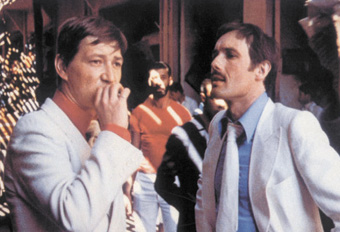
Fox and his Friends
A magazine and newspaper writer, Schock has collaborated on fun publications (in German) like The Queer Quiz Book (eg “Who was allowed to shave kd lang for the cover of Vanity Fair?”), Out! 800 Famous Lesbians, Gays & Bisexuals; Out Takes: The Encyclopedia of Lesbian and Gay Useless Knowledge, and, more to the point here, Out in the Cinema: the Lesbian & Gay Film Encyclopedia. Doubtless Schock’s film will combine serious study of this history with an apt embrace of both the high and low cultural dimensions central to gay film.
The Queer Kino program of eight films includes one regarded to be the first gay feature, a drama about a concert pianist in love and blackmailed, Different from the Others (director Richard Oswald, 1919, 50 mins). The film was destroyed by the Nazis but a copy was found in 1976. Carl Dreyer’s 1924 classic, Michael (79 mins), also about an artist and lost love, and possibly based on Rodin will also be screened.
There’s epic lesbian campery in the shape of Madame X: An Absolute Ruler (1977, 141 mins, Ulrike Ottinger). Possibly a nice antidote to Pirates of the Caribbean male antics, “Madame X, the irresistibly cruel and uncrowned pirate ruler of the China Seas, lures women away from their ordinary lives to gather aboard the ship Orlando for adventures at sea…Yvonne Rainer plays an artist, while underground icon Tabea Blumenschein tackles both the spike-fisted dominatrix queen and the ship’s leather-clad figurehead.”
Rainer Werner Fassbinder’s Fox and his Friends (1975, 117 mins) makes a rare cinema appearance (the Fassbinder oeuvre is to be released on DVD here) and a rare feature role for the writer-director himself in a tale of spiralling class, financial and sexual betrayal. The film was once called “The Blue Angel done in drag” and has sometimes been regarded as homophobic, but its complexity belies the charge. It’s certainly one of Fassbinder’s classiest looking films with cinematography by Michael Ballhaus (who has since worked extensively with Scorsese) and should be a real treat on the big screen.
Another rarity is Coming Out (Heiner Carow, 1989, 110 mins) regarded to be the first East German gay film, and the last because the Wall came down shortly after the film’s making. A young man represses his attraction to his best friend, finds love with a woman, but a journey into the gay underground…
The Oswald, Dreyer and Fassbinder features and Shock’s documentary history collectively make Queer Kino a seriously attractive proposition. It’ll be interesting to see if Shock’s encyclopaedic vision will put the German films in context. RT
Queer Kino: A History of Queer German Cinema, Chauvel Cinema, Mardi Gras Film Festival and Goethe Institut, Feb 15-March 1, www.queerscreen.com.au
RealTime issue #77 Feb-March 2007 pg. 20
<img src="http://www.realtime.org.au/wp-content/uploads/art/3/361_ndalianis_eyes.jpg" alt="David Lawrey & Jaki Middleton,
The Sound Before You Make It (2005),
kinetic installation with strobe lighting and audio”>
David Lawrey & Jaki Middleton,
The Sound Before You Make It (2005),
kinetic installation with strobe lighting and audio
courtesy of the artists
David Lawrey & Jaki Middleton,
The Sound Before You Make It (2005),
kinetic installation with strobe lighting and audio
DEVELOPED FROM THE EXHIBITION HELD AT THE HAYWARD GALLERY, LONDON (2004-5), EYES, LIES & ILLUSIONS AT THE AUSTRALIAN CENTRE FOR THE MOVING IMAGE CONTAINS MORE THAN 500 BOOKS, PRINTS, OPTICAL INSTRUMENTS AND TECHNOLOGICAL WONDERS THAT ARE DRAWN FROM THE WERNER NEKES COLLECTION (MULHEIM-AM-RUHR, GERMANY).
This extraordinary collection began in the mid-1960s when Nekes, a German experimental filmmaker and professor in film studies, started collecting examples of optical phenomena as teaching aids that highlighted pre-cinematic history. The objects, however, developed a mind of their own and grew beyond their pre-cinematic agenda into an encyclopaedic collection that now comprises approximately 25,000 devices devoted to the history of optical technologies.
If the Nekes collection can be understood as a contemporary wunderkammer that encases a micro-history of pre-20th century visual media technologies, then Eyes, Lies & Illusion might be seen as a micro-micro-history. Cameras obscura, magic lanterns, praxinoscopes, peep-boxes, daguerreotypes, kinetoscopes, panoramas and anamorphic lenses populate the appropriately darkened lower bowels of the ACMI building at Federation Square. The most impressive feature of this exhibition is that it represents a pansemiotic logic: each object is endowed with multiple layers of signification that speak of the past, the present and the present’s relationship to the past.
The exhibition is divided into seven thematic sections. Shadowplay, Tricks of the Light, Riddles of Perspective, Enhancing the Eye, Deceiving the Mind, Persistence of Vision and Moving in Time all introduce the audience to a gamut of spectacles, wonders of science and the technologies that create them: puppets, shadow theatres and magic lanterns manipulate light and dark to produce wonders that delight; prisms, lenses, mirrors and kaleidoscopes distort and alter light to reveal its mysterious properties; truly enchanting dioramas, panoramas, perspective boxes and a walk-in, distorting Ames Room all make concrete the mathematical principles of perspective; cameras obscura, scientific studies on anatomy, microscopy and astronomy, and examples of early photography reveal the way optics and technological innovation made visible the previously invisible; anamorphic images, visual cryptograms and optical illusions show how the human eye can succumb to artificially produced tricks of the eye; the wondrous motions of phenakistoscopes, zoetropes and praxinoscopes appear to magically create animated worlds; and pioneering experiments in photography and the cinema capture indexical reality opening the way to a new generation of optical illusions.
Teasing its audience with a rich, engaging and entertaining history of technological inventions that enhance and deceive human vision and perception, Eyes, Lies and Illusions typifies the active relations that many of these technologies command of their viewer-participant. The exhibition demonstrates the continuity of interest that has persisted in using media, in particular entertainment media, to push the boundaries of technology and vision, art and science through centuries. A pair of Florentine works painted on the natural stone known as pietre paesina (1620) depicts battle scenes and crumbling castles. Here, nature and art collide. In places, the natural patterns created by the stone’s surface portray smoke and crumbling castle walls; in other places, the artist’s hand takes over to depict the same subject matter. The eye is deceived. Where does nature end and human artifice take over? Perspective boxes and dioramas invite the participant to peep into their initially concealed spaces in order to discover alternate, virtual landscapes, theatrical performances and seascapes. Transparent pictures and Chinese shadow theatres transform their dark, two dimensional spaces into brightly lit, marvellous three-dimensional worlds. And in one of the 12 contemporary works, The Sound Before you Make It (2005), a kinetic installation with strobe lighting by the Australian artists David Lawrey and Jaki Middleton, the phenakistoscope’s reliance on the phenomenon of persistence of vision is given a new context as amused viewers watch small and static Michael Jackson figurines succumb to motion as the merry-go-round disc they stand on swings around and around to the rhythm of “Thriller.” The arrangement of all these objects serves to build visual (and audio) bridges that emphasize the playfulness of nature through the associative powers of sight.
Significantly, the experience of this exhibition reveals how no media are ever divorced from history. The camera obscura, for example, reveals its connections with the later invention of photography. The eerie 3D stereoscopic image of the filmmaker Lumiere reveals its connections to the spatially layered but illustrated 3D spaces of the dioramas. Marey’s chronoscope experiments expose themselves as predecessors of the digital animations used in current film effects—a fact also stressed in Carsten Höller’s 1998 work, Punkterfilm, which similarly maps a geometric depiction of movement. And perspective instruments, treatises and the objects that reflected its laws—dioramas, panoramas, and perspective boxes—reveal how they have found a new form of expression in the boxed screens that contain the virtual architecture of computer game spaces. But these objects are so much more than examples that highlight the path that eventually led to the diverse media of our own times. Almost every technological apparatus or depiction of wondrous media in action within this show shines independently of the role it serves as predecessor to a later media format.
The magic lantern is a case in point: walking through the show, the captivating properties of the optical devices have the capacity to ensnare the viewer with their mesmerising powers. It’s easy to forget the complex historical and cultural contexts that nurtured the production of these technologies and the modes of perception they evoked. As the concise and informative exhibition labels explain, and as is made even clearer in the excellent exhibition catalogue, the initial popularity of the magic lantern as visual entertainment has its origins in the 17th century. Athanasius Kircher, baroque scholar and scientist of encyclopedic proportions and the individual often (incorrectly) credited with the magic lantern’s invention, discusses its function and outlines his observations and experiments in light and shadow in his book Ars Magna Lucis et Umbrae of 1646 and in Physiologia Kircheriana Experimentalis of 1680, which is represented in the exhibition. Through their entertaining properties, these optical devices expressed the ways in which contemporary ‘science’ had altered perceptions of the universe.
The examples of magic lanterns range from simple, hand carved wooden boxes with lenses, to highly crafted metallic exteriors that depict the Eiffel Tower—all works of art in their own right. The sensory impact of the exterior designs further extends to the capabilities of the interior mechanics: a projection of H McAllister’s magic lantern slide of a dancing skeleton (c.1880), which was filmed by Nekes as part of his Media Magica film series (snippets of which are projected throughout the exhibition and successfully visualise many of the technologies in motion), drives home the fantastic and entertaining nature of the objects. Yet, the magical properties of these boxes are found not only in their well-crafted exteriors and the illusionist possibilities that this technology is capable of, but the micro-historical role they served. The various lithographs, prints and books from the 17th, 18th and 19th centuries accentuate this by providing snippets from time past: the image of a magic lantern projecting an image of a demon, for example, is from Gulielmo Jacobo ’s Gravesande’s two-volume book, Physices Elementa Mathematica (1748). As one of the earliest and most influential followers of Newtonian philosophy in Europe, ’s Gravesande’s image of the demon projection, and the accompanying image that reveals the interior mechanics of the magic lantern, visualised the theory of optics and light. A fantastic subject matter served a rational and scientific purpose that speaks of the arrival of the era of Enlightenment. Throughout its history, the magic lantern both enchanted and reflexively drew attention to the more rational function that these public spectacles served as scientific explorations of modes of perception, and of how the human eye is capable of being deceived through technological means. The books and prints in the collection play a significant role in highlighting the context of display; the magic lanterns the method and rationale of reception.
One of the most dramatic examples of this is the display of the frontispiece of Étienne-Gaspard Robert’s Mémoires Récréatives Scientifiques (1831), which depicts one of his famous phantasmagoria lantern projections. Better known as Robertson, he was a Belgian inventor, physicist and student of optics who improved the technology of the magic lantern, including its capacity to enlarge and decrease images. Robertson performed his most infamous show in Paris in an abandoned chapel surrounded by tombs. Crowds flocked to the dimly lit graveyard to experience (initially concealed) magic lantern effects of flying skulls and ghoulish apparitions against the backdrop of creepy lighting and sound effects. While it isn’t clear whether the frontispiece depicts this performance, the participants in the event, nevertheless, respond in similar ways by fainting, screaming and running away from the horrors that appear before them. Yet, despite the centrality of illusion and the theatrical emphasis on the fantastic, Robertson’s intentions were also scientifically motivated. His application of the magic lantern reflected Enlightenment concerns with scientific rationalism; reason and a scientific approach to the world could, it was believed, arm the individual with answers to the most fantastic and irrational of problems. Exposing his methods after the ghostly spectacle, Robertson’s aim was to arm the audience with scientific reason by showing them the technological and scientific means by which he conjured his illusions: the fantastic was a deception controlled by technological means.
For these magicians and popular scientists, there was nothing science and technology could not explain or achieve. But as commentators like Octave Mannoni, who contributes one of the chapters in the exhibition catalogue, has explained, and as those who experience this exhibition clearly understand, having insight into the means of the illusion’s production—its trick—exposed and explained through rational means and scientific process doesn’t make that illusion any less astounding. If only to experience this state of bizarre ambivalence, it is well worth visiting this fascinating and, in many respects, ground-breaking, exhibition.
Eyes, Lies & Illusions, Australian Centre for the Moving Image, Nov 2, 2006-Feb 11, 2007
RealTime issue #77 Feb-March 2007 pg. 21
© Angela Ndalianis; for permission to reproduce apply to realtime@realtimearts.net
THE DIVIDE BETWEEN THE MARKET SECTION OF THE AUSTRALIAN INTERNATIONAL DOCUMENTARY CONFERENCE WHERE PRODUCERS PITCH PROJECTS, AND THE CONFERENCE SECTION THAT FOCUSES ON THE CRAFT OF MAKING THE DOCUMENTARY IS BECOMING INCREASINGLY CONTENTIOUS. THE NEW CONFERENCE DIRECTOR HAS EVEN ENSURED THAT THE TWO STRANDS NOW OCCUR IN SEPARATE SPACES.

The Socialist, The Architect and the Twisted Tower
For the last few years the award-winning Adelaide filmmaker Heather Croall (now Festival Director, Sheffield Docfest, UK) ran the event. She brought to AIDC an internationalism, a slickness and an ongoing commitment to maintaining the craft section of the conference. The new director Joost den Hartog comes from the market side of documentary events. He has organised markets at, among others, Amsterdam’s IDFA, Toronto’s Hot Docs and our very own AIDC. His appointment represents a shift in dynamics for AIDC.
English is not den Hartog’s first language and he has the diplomatic considered speech patterns of a person who is not a native speaker. He is fast to assure me that non-market sections of the conference are still important. “The marketplace is an important part of the conference but that is not the flagship or the main focus. The main focus this year, because we are celebrating AIDC’s 20th anniversary, is on motivation and inspiration and trying to find answers for questions like, ‘What is the purpose of documentary for society?’.”
The ‘conference’ sessions from the programme profiled on the AIDC website are almost all market related and aimed at producers. These sessions are the traditional territory of directors, writers, editors and cinematographers. Documentary directors and writers may mutter under their breath about keeping the craft sessions but den Hartog is actually catering to his market by doing this. Documentary filmmakers have voted with their feet at previous conferences, turning out in droves to anything about potential financial resources. In a sense the ‘conference’ sessions for the directors et al had almost become sideshow to keep them entertained whilst their producers ran around like mad chooks cornering funders and TV execs.
The final session is where the large question “Can Documentaries Change the World?” will be posed. Ross Kauffman, one half of the directorial team of Born Into Brothels: Calcutta’s Red Light Kids (2004), will talk with Variety film critic Richard Kuipers to try to find an answer. The question implies functionality as fundamental for the documentary form. It turns out den Hartog does indeed like documentary to have a function, “Call me a hippy or naive, but I think documentary is a very powerful way to raise awareness and to actually mobilise behavioural change and establish social change in society. I am very convinced of that. And I think that there are plenty of examples of recent films that have been able to do that…The most obviously example is An Inconvenient Truth. Now even John Howard thinks that there is something like global warming going on. It is quite an achievement for a filmmaker to get to John Howard.”
Unfortunately it looks likely that Participant Productions’ Diane Weyermann will be unable to attend the conference, because she’ll be busy glamming up for the Oscars where An Inconvenient Truth (2006) is nominated. However Participant Productions is a company well worth watching. Started by the eBay billionaire Jeff Skoll, it aims to fund films that have a social change agenda and turn them into films that will have broad appeal. The company’s tagline is, ‘Lights, camera…social action!’
One of the interesting side effects of the market people taking over conferences is that they have created a space in which filmmakers might start thinking creatively about the marketplace. Joost says, “On the Monday of the conference there are two sessions designed to explore an alternative marketplace by looking at the example of the internet and starting to look at relationships between various platforms. It will also look at other potential financiers like NGOs. DocAgora is an international initiative which had its first gathering in Amsterdam.” There are DocAgora sessions planned for a number of conferences around the world. (DocAgora describes itself as “a virtual webplex” for documentary: “an open space to consider new forms, new platforms and new ways of financing creative, authored and socially engaged documentary content. www.docagora.org). Joost continues, “A report will be written of all the sessions and eventually it will have to result in an alternative marketplace that can exist next to the traditional broadcast model.”
Whilst on the subject of commissioning editors, an embarrassing moment occurred last conference when the search for a commissioning editor during a pitching session resulted in a speakerphone admission that she was at the beach. It’s a worrying notion that buyers might see AIDC as a beachside break. Joost says, “We screen all buyers on their willingness to work with Australians and Australian content. And the reason why they come is that they are interested in Australian content or have a willingness to work with Australian producers. We do a follow-up every year after the conference to see what kind of deals are made. Most of them go home with two or three presales and a bunch of contracts and projects in development.”
A large contingent from Asia will be attending AIDC this year. Joost says “We have quite a big involvement from Discovery Asia and [they] will announce a scheme which is new. They have given their Australian office a fund to commission Australian content. It will be spread over two years for the Australian independent sector.”
When asked about what he thinks are the current crises in documentary den Hartog mentioned the obvious, not enough funding, but also felt, “the broadcasters are in a more competitive market these days and they want to brand their channels. That has consequences for independent producers and on the type of content that [the broadcasters] acquire.” The issue of branding will be covered at the conference at Rudy Buttignol’s session, called “It’s the Flow Not the Show.” (Buttingol is a leading Canadian network commissioner and programmer). It promises to be an interesting session considering the traditional notion that documentary is about ‘program strands’ and that individual 50 minute works are fast giving way to reality style series in Australia.
Australian International Documentary Conference, Adelaide, Feb 23-26, 2007, www.aidc.com.au
RealTime issue #77 Feb-March 2007 pg. 20
© Catherine Gough-Brady; for permission to reproduce apply to realtime@realtimearts.net
THE IMAGE, FRAMED AND HUNG TO CATCH THE EYE AS ONE FIRST ENTERS THE GALLERY, IS A SUITABLY CHARACTERISTIC ONE: DYNAMIC IN COMPOSITION AND TONE, WITH AN INKY FLUIDITY TO ITS LINE, IT SEEMS AT ONCE BOTH ORGANIC AND FUTURISTIC, NOT TO MENTION KIND OF CUTE. IN IT, ASTRO BOY, THAT ICONIC AND SPRIGHTLY BOY CHILD ROBOT WHO FOR DECADES NOW HAS SERVED AS THE AVATAR OF JAPANESE ANIME AND MANGA IN THE WEST, IS FIGHTING A GOOFY LOOKING HUMAN ADULT, WHOSE EXPRESSION OF BEWILDERED ASTONISHMENT CAN BE GLIMPSED AS HIS SINEWY BODY SOMERSAULTS BACKWARDS THROUGH THE AIR, SOUNDLY PUMMELED AND CLEARLY BEATEN.
<img src="http://www.realtime.org.au/wp-content/uploads/art/3/374_clayfield_tezuka_black.jpg" alt="Tezuka, Black Jack, cover from Black Jack, 1974,
Weekly Shonen Champion, published by Akita Shoten”>
Tezuka, Black Jack, cover from Black Jack, 1974,
Weekly Shonen Champion, published by Akita Shoten
©Tezuka Productions
Tezuka, Black Jack, cover from Black Jack, 1974,
Weekly Shonen Champion, published by Akita Shoten
The exhibition in which this image appears, Tezuka: The Marvel of Manga, is full of such visually striking images. Developed by and for the National Gallery of Victoria in collaboration with guest curator Philip Brophy, and touring to both the Art Gallery of New South Wales, Sydney, and the Asian Art Museum, San Francisco, in 2007, the exhibition marks the first Western retrospective of the work of pioneering manga artist and innovator Osamu Tezuka, creator not only of Astro Boy and Kimba the White Lion (aka Jungle Emperor), but of over 700 other manga titles. Not all of these are represented in the exhibition, of course, but those that are (about sixteen titles) are not only representative of the remarkable breadth and depth of Tezuka’s oeuvre—not to mention its quasi-philosophical richness and inherent humanistic worldview—but also clearly establish him as one of the finest graphic artists of the post-war period, artist, entertainer or otherwise.
For the Western viewer, the iconic figure of Astro Boy serves as a convenient entry point into the world of both manga and Tezuka. I am no exception. Like many of my generation, my only previous connection to Tezuka was watching Astro Boy on television back when I was a little kid. His spiky black hair and his rocket booster boots are instantly recognisable but my interest in this sucker punch of an image—and in the exhibition waiting beyond it—has less to do with my childhood memories of serialised early morning cartoons than it does with the image’s graphic power, which is like a black-and-white slap in the face.
Tezuka’s work pivots on a series of dichotomies. The most obvious of these is the not-quite-absolute split between his manga for children and his gekiga for adults, embodied in the exhibition space itself by the colour-coded division between green walls (children’s manga) and blue (adults’ gekiga). However, this is by no means the only or the most interesting dichotomy. There is also the divide—a certain graphic tension—between abstraction and figuration, which often manifests as a struggle between page layout and panel content, or, within the panels themselves, between background and foreground (Tezuka’s backgrounds are like Futurist Florence Broadhurst wallpapers, particularly in a manga like Astro Boy).
There’s also a tension between modes—one might even say ‘schools’—of visual representation; a tension which cuts across all the manga and gekiga appearing in the exhibition. At times, Tezuka’s work seems to strive towards a kind of no-nonsense (if certainly heightened) realism; at others, it embraces no-holds-barred abstraction, Impressionism, or my personal favourite, Surrealism.
There are panels (and whole pages) in some of Tezuka’s darker gekiga work, particularly Bomba and Eulogy for Kirihito, which shock with their surrealist imagery. In a page from the latter, to illustrate Kirihito’s mental and physical torment as he transforms into a hybrid creature—half-dog, half-man—Tezuka gives us a series of disparate, terrible images, motivated not by any narrative or diegetic causality, but by a kind of emphatic, affective causality. The image of a primitive, almost totem- or sculpture-like being, lying on its back against a solid black background screaming, is genuinely terrifying (indeed, it was one of a few images that, for its very strangeness and uniqueness within the context of the exhibition, I just had to go back and see for a second time before I left). Other panels on the same page show a solid black form in the shape of an explosion and the turbulent surface of a pond during a downpour.
In another image from Kirihito a doctor, in a hospital somewhere, comes to a shocking realisation about something or other. Presently, his glasses begin to levitate, floating away from his face, which fades away. The floating spectacles instantly recall the floating bowler hats of Hans Richter. Rising against an empty white background, the spectacle lenses suddenly crack. Blood pours out into the air from invisible eye sockets. And then we’re back in the hospital again, in reality, ready to get on with the story.
But this page appears in a frame, behind glass: there’s no story to get on with. The images are abstracted, fragmented, devoid (even robbed) of their narrative context. Continually, we are told—by the wall panels, by the room book, by the small army of tour guides who lurk behind corners waiting to jump out and inform you—that Tezuka’s manga is concerned, first and foremost, with the telling of a story. But in the context of the gallery space, where comic books are hung as opposed to held, fingered, dog-eared and read, manga-stories become—(gasp!)—graphic art and, as such, at least comparatively, storyless.
And so as I leave this visually exhilarating exhibition, feeling genuinely excited about all that I have seen, I am hit all of a sudden by a feeling that I’ve missed something. I begin to wonder if I really know any more about manga than before. I wonder if I know less. I realise I want to turn the page and to find out what happens to Astro. The visual dynamism of his movements seems less important to me now. A gallery wall is not a comic book. I want to know what happens next.
Tezuka, the Marvel of Manga, curator Philip Brophy, National Gallery of Victoria, Nov 3-Jan 28; Art Gallery of New South Wales, Feb 23-April 29; Asian Art Museum, San Francisco, June 2-Sept 9
RealTime issue #77 Feb-March 2007 pg. 22
© Matthew Clayfield; for permission to reproduce apply to realtime@realtimearts.net
SUPER 8 HAS HAD A RESURGENCE OF LATE WITH SYN CITY AT THE ACP AS WELL AS SUPER 8 SCREENINGS AT THE CHAUVEL CINEMA. BOTH SHOWS WERE PART OF D/LUX/MEDIA/ARTS’ 25TH ANNIVERSARY THAT ALSO SAW THE LAUNCHING OF D/ARCHIVE.
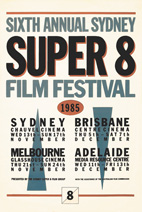
Posters, Sydney Super 8 Film Group
Courtesy D/Lux/Media/Arts
Posters, Sydney Super 8 Film Group
As part of the archive project I interviewed Kate Richards, who set up the first two Super 8 festivals, and Mark Titmarsh, who was instrumental in the formation of the Sydney Super 8 Film Group later to become Sydney Intermedia Network and finally d/Lux/Media/Arts.
Kate, you initiated the first Super 8 film festival with Deb Collins. Your background was a distinctively Sydney 80s mixture of politics, squats and French cultural theory?
KR We both began shooting Super 8 while still in high school, and were very political young people and strong feminists. In 1980, when we established the first Super 8 film festival we were living in the Surrey Street squats…Our imperative was just the politics of getting this stuff up on screen. Deb approached the Sydney Filmmakers Co-op to put the work on. She talked them through their initial response of, ‘Oh Super 8, that is not a valid format.’ They were media makers, content and documentary orientated, and artisanal based. What we represented were the new wave of the tertiary-educated, French theory driven students from UTS. Further down the track I could see that without a strong studio practice the whole thing falls over.
How did the first festival go?
KR It was an unbelievable success. We made a little poster and we photocopied it and just stuck it around in cafés and on posts and people had to mail their work in. We got a huge amount of films and we showed them all. The program was very long and we packed out the Co-op the whole weekend. The Co-op were astounded as they had a lot of trouble getting bums on seats. I think the festivals captured a moment when a whole lot of new forms of aesthetics and signification were starting to bubble away—classic post modernity before the term was being used in Sydney—films such as Stephen Harrop’s Square Bashing, with found footage re-configured, and very well cut.
You then moved to England and connected with the Bristol scene. The festival needed new patronage.
KR Yes, luckily they all appeared in that Brisbane wave. There was a big influx in the late 70s: musicians, artists and social workers. They were really quite smart, sophisticated and articulate, coming out of such a repressive regime as Bjelke Peterson’s. I think it was a natural progression that this new group would take over the next festival.
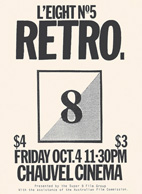
Posters, Sydney Super 8 Film Group
Courtesy D/Lux/Media/Arts
Posters, Sydney Super 8 Film Group
MT My earliest involvement with Super 8 in Sydney was contributing two films to the second festival in 1981. After that festival Ross Gibson, Lindy Lee, Deirdre Beck, Janet Burchill and myself got together and we called ourselves the Super 8 Collective.
After successfully applying for a grant from the Australian Film Commission we held the 3rd Sydney Super 8 Film Festival in November 1982 at the Chauvel Cinema in Paddington. The cinema had a capacity of 300 hundred seats. It was full every night and was like that for every annual festival for most of the 80s. I don’t think there were many sophisticated debates around the selection process. We were a test audience, a colosseum forum that voted thumbs up or down.
There was a scene there that grew in sophistication as long as the technology was viable. Over that period a new core of people began to develop with Gary Warner, Virginia Hilyard, Michael Hutak, Catherine Lowing, Andrew Frost and myself. We also did a whole series of Film Readers as well as the festival catalogues and posters, all of which demonstrated a post-do-it-yourself-new-wave aesthetic.
What were some of the political and aesthetic considerations of the filmmakers involved?
MT Andrew Frost, Michael Hutak, Gary Warner, Stephen Harrop and myself all eventually formed Metaphysical TV. We all made films about our relationship with the television screen. We used Super 8 to shoot directly off the screen, reconstructing the material into some personal or perverse work. It all fell into current discussions of post-modern quotation and appropriation. Catherine Lowing was working with a similar sensibility but without the direct relation to television; she was into subcultures, rockabilly, video clip…and dance cultures. Virginia Hilyard was more into a poetics of cinema; she did experiments with expanded live performances. Her work was close to neo-expressionist painting of the time, very visceral and physical.
What did post modernity mean for Sydney Super 8 film scene?
MT I remember the event that crystallised the understanding of postmodernism in relationship to visual art practice was the Futur*Fall conference at Sydney University in 1984. Baudrillard was the keynote speaker. Lots of people identified postmodern concerns in literature, film theory, fine arts, architecture and economics.
For most of the Super 8 filmmakers what appeared as postmodern in their work had come about quite spontaneously. Instead of taking up the previous generation’s tendency to critique entertainment culture and reject it out of hand we savoured it for aesthetic and expressive effect, touched it up in a certain way, rebuilt it to make it even more perfect. To even make it articulate where it had been dumb, and thoughtful where it had been ignorant.

Posters, Sydney Super 8 Film Group
Courtesy D/Lux/Media/Arts
Posters, Sydney Super 8 Film Group
KR I think collage and those sorts of ideas were the precursors of postmodernity as a technique and had been around for decades. The beauty with reversal stock was we could cut it and stick it; the medium lends itself to being treated that way. We questioned and broke things down. The thin edge of postmodernist reach, though, is just pastiche.
In the 80s you were seen as a vigorous proponent of Super 8 especially in regard to the concept of the ‘Super 8 phenomenon’ and ‘Super 8 effect.’
MT From very early on there was a feeling that Super 8 was special, that there was more to it than just a cheap mass-produced medium. To me it was more than film, it was a way of life, involving an act of sub-cultural revelation. It was really a kind of formalist analysis of the medium. I argued that Super 8 was invisible to practitioners of other gauges, that a certain repressed consciousness was able to return to the surface through the radical incompetence of untrained but otherwise creative Super 8 filmmakers. There were heated debates and differences of opinion about that. As a critical response Edward Colless put it really well, that ‘Super 8’ really defined nothing, that to call an evening of films simply ‘Super 8’ was as crazy as calling an exhibition of paintings ‘Oil Paint.’ I like to have it both ways, and say yes there is a Super 8 effect, it is liberating and empowered by radical incompetence. But also in Sydney and the city scene something happened that is still to be fully articulated; because of the particular place in time, fuelled by art schools and fringe dwelling film specialists and the nature of Super 8 cameras and instant technology.
KR I think the Super 8 scene was metonymic of people’s need to have time-based media. I think equipment was there waiting to be grabbed. It represented the first of what is a long line of domestic media. There is a political imperative about getting the means of production into the hands of non-experts. I think it’s a little bit facile to say it is the medium.
What relevance does Super 8 have today?
MT I know that there are still Super 8 film festivals in Melbourne and Super 8 is still being picked up by new generations of filmmakers, usually as a device for symbolically representing the past. So you have to say Super 8 never really went away, it just changed its context and its symbolic presence. The result is that the Super 8 phenomenon of the 1980s is really well documented and sits there as a resource waiting to be activated at any time.
d/Lux/Media/Arts are doing that right now with the launch of their web archive that is a repository of every work shown since the 1980s through the 90s and up to recent d>Art events. The archive includes digital versions of films, lists of all the screenings and works, all the writings and artists details from the last 25 years. Amnesia need no longer be an affliction for the experimental screen community!
SynCity, curator Mark Titmarsh, Australian Centre for Photography, Sydney, Oct 19-Nov 26, 2006; dlux.org.au/syncity
d/Archive can be visited at http://archive.dlux.org.au
RealTime issue #77 Feb-March 2007 pg. 23
© Bob Percival; for permission to reproduce apply to realtime@realtimearts.net
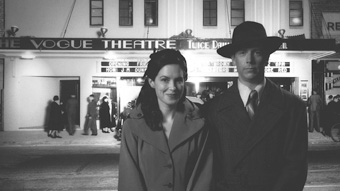
Alma (Victoria Hill) & Rupert (Ben Mendelsohn) at Vogue
photo Rose Draper
Alma (Victoria Hill) & Rupert (Ben Mendelsohn) at Vogue
LIKE AN AUSTRALIAN VERSION OF TIM BURTON’S ED WOOD (1995), HUNT ANGELS (ALEC MORGAN, 2006) IS A BIOPIC ABOUT A NOT VERY SUCCESSFUL, BUT VERY PASSIONATE, PAIR OF FILMMAKERS STRUGGLING OUTSIDE THE HOLLYWOOD RUN SYSTEM IN THE EARLY YEARS OF CINEMA. STARRING BEN MENDELSOHN AS THE FAST-TALKING RUPERT KATHNER AND VICTORIA HILL AS ALMA BROOKS, HIS ALLURING YOUNG CAMERAWOMAN, THIS SAD TALE OF THE DUO’S PERSISTENT BUT DOOMED STRUGGLE TO TELL AUTHENTIC AUSTRALIAN STORIES IS PORTRAYED IN SUMPTUOUS BLACK AND WHITE ART DECO STYLE.
Seamless computer manipulation embeds the two actors into stills and newsreel footage from the 1930s and 40s and intercuts them with interviews of still living contemporaries. Hyper-stylised mise-en-scène is reminiscent of film noir. Costuming and makeup is authentic to the period and immaculate. Even the transitional wipes from re-enacted footage to present-day interviews have the feel of the 30s. The use of matting and green-screen recording of the two actors playing the forgotten filmmakers integrated into hundreds of archival images has resulted in a documentary film consisting of 281 special effects shots, which “deploy…contemporary electronic means to fuse together the story of two filmmakers ‘lost’ from our written history with ‘lost’ images of Sydney of the era in which they lived” (Alec Morgan, “Re-telling history in the digital age: The scripting of Hunt Angels”, Scan: Journal of Media, Arts, Culture).
With more chutzpah than talent, Kathner and Brooks made nineteen films before ‘Rupe’ died of a brain hemorrhage in 1954 at the age of 50. Unfortunately, none of these bear scrutiny today, especially when stacked against the better funded works of their contemporary cinemateurs such as Charles Chauvel, whose Rats of Tobruk (1944) scuttled Kathner and Brook’s own plans of a desert war saga. Despite being pioneers in Australian cinema, their contributions don’t even rate a mention in the Australian Film Institute’s A Century of Australian Cinema (1995). The short-lived screenings of their films took place only in the so-called ‘flea-pits’ of Sydney, because, as David Stratton points out, “the two main cinema chains were majority owned by foreign companies (Hoyts by 20th Century Fox and Greater Union by Rank Organization)“, (“A true Aussie gem”, The Weekend Australian, December 2-3, 2006), and these cinemas could only play films sanctioned by the Hollywood owners.
Distribution was monopolized by Hollywood companies, too. Rarely were Australian-made features screened and Kathner and Brooks were under constant financial strain, with many of their filmmaking ventures being little more than scams to milk money from gullible investors, or ‘angels’. Morgan explains their appeal: “They were partners in moviemaking, love, and (as it turned out) crime” (“Lost city of the senses”, Scan: Journal of Media, Arts, Culture). For their Pyjama Girl Murder Case (1939), Australia’s first ‘true crime’ movie, Alma stripped and lay in a bathtub, pretending to be a corpse that had been steeped in formalin for five years, because access to the real thing was denied by the NSW Police Commissioner, “Big Bill” Mackay. The pair’s earlier break-in to the Sydney University Medical Faculty to film the body failed due to lack of a replacement bulb when their only lighting rig blew. Finally, to get permission to continue with the film, Kathner manufactured death threats against himself and ‘leaked’ them to the media: “Big Bill” relented and the film was completed.
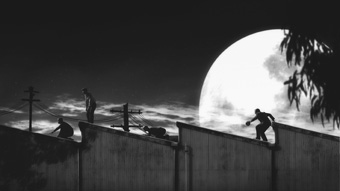
Hunt Angels
photo Rose Draper
Hunt Angels
After a state ban on bushrangers in film was overturned in 1946, the pair’s Ned Kelly film, The Glenrowan Affair (1951) employed numerous different leads according to whomever they could con. The movie’s ‘stars’ came from grazing properties around Victoria’s ‘Kelly country’ and contributed financially in return for the leading role. As a result Kathner and Brook’s ‘Ned’ was variously short, tall, fat and thin. Although the feature films with which they unsuccessfully took on the Hollywood stranglehold have all but sunk without a trace, with none ever turning a profit, Kathner and Brooks did contribute significantly to the newsreel genre, by depicting the actual misery and squalor of the Depression era in their Australia Today pieces of 1938-40, which were in stark contrast to the artificially optimistic Fox-Movietone News and Cinesound Review newsreels. Morgan laments the habit of historical surveys of Australian film to overlook the newsreel at the expense of features:
Because of the exclusion policies of Fox and Cinesound, moving images of the poorer, noir world of Sydney that Kathner and Brooks inhabited and filmed are missing from our popular memory. Generations have grown up seeing a Depression-era Sydney depicted as a sunny, prosperous place with beaches full of happy bathers and bronzed lifesavers. Even today, because of their easy access, the Fox-Movietone and Cinesound News collections are the most extensively used sources of factual footage of that era. (“Re-designing the past imperfect: The making of Hunt Angels”, Senses of Cinema, 2006).
By depicting Depression-era Australia as it really was, Kathner and Brooks should have earned a place in Australia’s cinematic history, but their fringe existence has meant they have been under-screened and overlooked…until now, that is.
Biopics of filmmakers have not been common in Hollywood: apart from Burton’s Ed Wood, Bill Condon’s Gods and Monsters (1998) about horror film director James Whale also springs to mind. Morgan’s work is the first biopic of an Australian filmmaker: biopics here have included a sports star, Dawn Fraser in Dawn! (Ken Hannam, 1979); criminals, Mark ‘Chopper’ Reid (Chopper, Andrew Dominik, 2000) and Brendan Abbott (The Postcard Bandit, Tony Tilse, 2003); a writer, Miles Franklin (My Brilliant Career, Gillian Armstrong, 1979); a pianist (David Helfgott in Shine, 1996); and Ned Kelly in a plethora of films. One commonality in Australian biopics is the recurring theme of a unique individual’s struggle against the establishment. But the underdog need not win: Albert Moran and Errol Vieth note in Film in Australia in their chapter on the Australian biopic: “there is no obligation on the genre to trace an ever-upward path on the part of its central figure. Triumph and affirmation may only be incidental moments in the biographical film” (Film in Australia, Melbourne: Cambridge UP, 2006). Kathner and Brooks were certainly underdogs.
Nevertheless, Hunt Angels serves as an instructional piece for contemporary Australian filmmakers, who have it comparatively easy. Since the 1970s Australian filmmaking has been greatly assisted by the state film development organisations in what has been called The Revival. Before this financial revitalisation, cinema in Australia was a mostly US lead affair: 95% of films screened were US productions distributed by US firms and shown only in cinemas they approved. This was the hostile environment in which Kathner and Brooks operated. Paul Kathner says in the film: “My father wanted to tell Australian stories—he was fed up with the Americanization of films.”
It is this passion to break away from Hollywood controlled production, distribution and screening and to tell Australian stories that drove Kathner and Brooks. It is this same intention to do things in an anti-Hollywood way that seems to have driven Morgan to choose two movie-making failures to be the subject of a film. Moran and Vieth write of the Australian biopic, “What matters is not the historical importance of the life but rather that the life actually happened. Beyond that, generic form and style intervene to ensure that the biographical subject becomes a screen subject.” Morgan creatively uses Art Deco style and form to turn a forgotten biographical subject into a captivating screen subject, something that would never have seen the light of day were it a story about two unknown filmmakers in Hollywood. Instead of choosing a successful Australian cinematic legend like Charles Chauvel, the subject of numerous historiographies, Morgan has disclosed the quondam reality of our lesser-known Australian movie-making background. As David Stratton has said of Hunt Angels, “if you care anything about local cinema, the result is essential viewing.” Hunt Angels has filled in a small blank in our cinematic and cultural history, re-coloured an effective whitewash of the Depression-era wretchedness of Sydney by Hollywood sanctioned sanitised newsreels, restored a nation’s previously censored memory, and done so with an unmistakable anti-Hollywood sneer.
Hunt Angels won the 2006 Film Critics Circle Australia Award for Best Feature Documentary and the Atom Award for Best General Documentary.
Hunt Angels, writer-director Alec Morgan, cinematography Jackie Farkas, lead compositor and visual Fx supervisor Rose Draper, visual effects consultant and post-production supervisor Mike Seymour, production designer Tony Campbell, costumes Margot Wilson, editor Tony Stevens, composer Jen Anderson, producer Sue Maslin; Palace Films with Film Art Doco and Blusteal Films, 2006 www.huntangels.com.au
RealTime issue #77 Feb-March 2007 pg. 24
© bruno starrs; for permission to reproduce apply to realtime@realtimearts.net
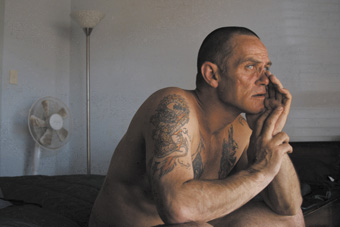
Richard Green, Boxing Day
KRIV STENDERS’ BOXING DAY IS A DOMESTIC DRAMA FOCUSING ON A MAN ON HOME DETENTION WHO UNCOVERS A DISTURBING TRUTH WHILE ATTEMPTING TO RECONCILE HIS ESTRANGED FAMILY. SOLELY FUNDED BY THE ADELAIDE FILM FESTIVAL AND UNFOLDING IN REAL TIME IN ESSENTIALLY ONE CONTINUOUS TAKE, THE FILM IS A FOLLOW UP, NOT JUST CHRONOLOGICALLY BUT METHODOLOGICALLY, TO STENDERS’ MICRO-BUDGET BLACKTOWN, WHICH WAS A HIT AT THE 2006 SYDNEY FILM FESTIVAL (WHERE IT TOOK OUT THE AUDIENCE AWARD), MELBOURNE, BRISBANE, PERTH AND CANBERRA FILM FESTIVALS.
Blacktown is shortly to be released on DVD by Madman Entertainment. Ahead of Boxing Day’s world premiere at AFF, I spoke to Kriv Stenders about his working methods, casting strategies and stylistic formalism.
“The seed for the film happened ten years ago when I made a short film called Two/Out,” says Stenders of his first collaboration with Boxing Day co-writer and star, indigenous poet, musician and sometime actor, Richard Green. “I met both Tony Ryan [star of Blacktown, RT67, p22] and Richard through making Two/Out. Richard and I stayed in loose contact, and when I made Blacktown with Tony I touched base with Richard. Then, because of the experience I had with Blacktown, I thought it would be great to make a film with Richard in a lead role. Basically having that experience under my belt I decided to do Boxing Day.”
The film’s scenario involves Green’s character, Chris Sykes, a recovering alcoholic and criminal, preparing Christmas lunch when an old friend turns up uninvited at his doorstep and reveals a secret regarding his family. When Chris’ daughter, his wife and her new boyfriend finally arrive, the situation inevitability escalates in tension towards revelation and conflict. Dark and relentless when compared to some of the relatively lighter and romantic moments of Blacktown, the film’s tone was dictated by Green’s presence: “ Tony [in Blacktown], who’s very gregarious, with a lot of light inside him, he was ideal for that type of film, while Richard is a lot more conflicted. I knew that he’d be able to play intensity really convincingly, absolutely perfect for some kind of heavily dramatic role. And it just kind of fed from there. Well, we thought, what about a siege situation? He’d be really good in that. How about that? What about a domestic situation, the ones you read about in the papers at Christmas when families go off the rails? Perfect. That’s where it started. Richard can do this sort of character. What kind of story would that character inhabit? Work with that, and the story kind of wrote itself from that point. And it became this kind of confronting, quite unrelenting piece. Hopefully with some kind of light in it as well.”
The writing process for Boxing Day never advanced to a full draft screenplay, but what Stenders calls a “scriptment”, which had precisely laid out story beats and sample dialogue, but with enormous scope for flexibility and improvisation. A limited cast of six and one location was suited to this form of organic evolution of narrative and character. “Basically we had a three week period to produce the film. So for the first two weeks we rehearsed the film chronologically, and shot it. At the end of the first week we had a version of the film, which we could sit back and watch. Every night I’d pick the best bits and cut it together. So at any point of the day we had the film, and we just added on the next dramatic layer. By the second week we had a second version of the film and we really knew what the weak points were, what the twists and turns were, and were really able to refine the story and address a lot of dramatic issues and character issues.” This was a more structured approach than the guerrilla approach to the making of Blacktown. “Blacktown was shot over about eight months. And it wasn’t as concentrated or disciplined as this. Boxing Day is a much more contained enterprise. It was more finite. But because we had finite resources and finite time, I think it worked really well, because it really helped focus everything.”
Stenders is a passionate advocate of backing the abilities of non-actors, as long as they bring an intrinsic talent and legitimacy to the role, and he encourages them in certain scenarios to construct their own dialogue and action. “Because you’re not bound by script or hitting lines, it can help alleviate stilted performances, and it’s important to get actors who are more like jazz musicians, who are able to improvise, riff off a melody, and come back to the basic rhythm again.” A non-actor, Stuart Clark, plays Chris’s drug-dealing colleague in Boxing Day, his services attained through contact with the Offenders Aid and Rehabilitation Services of SA. A similar process was used to cast Stenders’ short film Two/Out, “and it’s a risky thing to do because some of these guys are struggling with internal issues. But Stuart brought something inherent, he brought some authenticity and a lot of credibility to Boxing Day.” The end result of Clark’s natural performance is compelling, full of implied menace and idiosyncratic phrasing.
While most of the cast were taking their first roles, they were also offset by the presence of two professional actors in Syd Brisbane and Tammy Anderson. This blending of experience and rawness was very deliberate: “In a funny kind of way they feed off each other. Non-actors can be more tangential and unpredictable but the actors can always bring them into line, and vice versa…it’s all about casting. From my point of view directing is 99% casting.”
Trained as a cinematographer, Stenders himself shot Boxing Day with a hand held, intimately observational approach of one extended take in a digital format. Aware that this brand of cinematic experiment has been attempted before, he acknowledges predecessors like Russian Ark (Aleksandr Sukorov, 2002) and Time Code (Mike Figgis, 2000): “So it’s not that groundbreaking, but I think what’s different about Boxing Day is that we’re telling a linear story. It’s all about the story, really.” His ambition for Boxing Day is to balance an aesthetic style, a narrative structure, and the technology of the medium, into something cohesive:
I really love digital as a medium and I really like to find new ways of telling stories to make films. In a funny kind of way, I think digital has been the best thing to happen to cinema in the last twenty years, because the freedom it gives you to work outside of normal systems, styles, formats or traditions is great. So I wanted to do something where the form and content were the one thing and kind of inform each other. And I just really like the idea of doing long takes, and never cutting and always being in the moment.
Having made Illustrated Family Doctor, a traditional feature on 35mm—although that was a lot of fun—the thing I learn as I make more and more films is that if I frighten myself, if I put myself in compromising positions I find that the payoff is more rewarding than by being safe.
Adelaide Film Festival, Feb 22-March 4, www.adelaidefilmfestival.org
RealTime issue #77 Feb-March 2007 pg. 17
© Sandy Cameron; for permission to reproduce apply to realtime@realtimearts.net
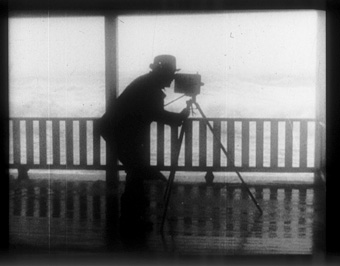
Passio
ONE OF THE DISTINCTIVE FEATURES OF THE PROGRAM FOR THE 2007 ADELAIDE FILM FESTIVAL (AFF) IS ITS EMPHASIS ON SILENT FILM WITH THREE STRONG ATTRACTIONS: PAOLO CHERCHI USAI’S PASSIO, ROLF DE HEER’S DR PLONK AND A SCREENING OF D.W. GRIFFITH’S INTOLERANCE WITH LIVE ACCOMPANIMENT BY LOCAL BAND, THE DEADBEATS. GIVEN THE GRAND CLAIMS FOR NEW MEDIA IN THE DIGITAL LANDSCAPE, IT SEEMS SIGNIFICANT THAT OLD MEDIA ARE SIMULTANEOUSLY RETURNING TO PROMINENCE.
One common thread linking AFF events is the relationship with live music which has sustained the renaissance of interest in silent film. Film theorists, for many decades, have noted that the diffusion of synchronised sound in the later 1920s and the rise of a dialogue driven cinema added to the realism of the image. These three projects, while with very different geneses, employing divergent aesthetic strategies and addressing different publics, all circle around the idea of returning the image to a space where it can interact as an equal with the more abstract structures of music.
Paolo Cherchi Usai is the Director of Australia’s National Film and Sound Archive, as well as one of the world’s most respected film archivists and historians. Passio, his feature compilation of found footage and calligraphy, accompanies Arvo Pärt’s musical adaptation of the Passion from The Gospel of St John. Pärt’s music will be performed by the Adelaide Symphony Orchestra with organist Christopher Bowers Broadbent and the Theatre of Voices directed by Paul Hillier.
Cherchi Usai has spoken of his interest in producing a dialogue between image and sound. To the extent that the film has a subject, he sees it as dealing with our society’s history of image production. He sees the sum total of our images as a kind of repressed collective memory, and in interviews he has invoked writers such as Mircea Eliade who emphasise the symbolic role of imagery.
He is also interested in the image as image in a very concrete sense. In an attempt to restore what Walter Benjamin called the aura of the individual artwork, lost in the age of mechanical (and now digital) reproduction, only seven prints of the film were struck before the negative was destroyed. Each print is hand-coloured in a different hue, with four cool prints (ruby, violet, indigo and magenta) and three warm prints (vermilion, gold and minimum colouring). No one print of the film is like another, just as no one performance of the work will be like another.
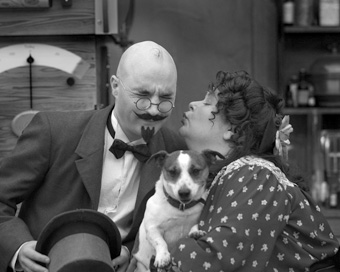
Dr Plonk
From the sublime to the ridiculous. In an industry where the hardest thing is to make your second film, Rolf de Heer was travelling with his tenth feature, the AFI-winning Ten Canoes, while cutting his eleventh, Dr Plonk, which is the AFF’s closing night film. By Australian standards, de Heer comes up with some pretty daring ideas. Having made a subtitled film in an indigenous language with a group of non-actors, he has backed up with a silent, slapstick comedy. To de Heer, these aspects of his career are related. “The more radical I get, the easier these things are to finance,” he said at a Media Resource Centre talk in Adelaide recently.
His last two films are linked in more pragmatic ways as well. The overrun in making Ten Canoes meant that de Heer needed to make another film relatively quickly. He tells of going to the fridge to get some insect repellent in preparation for a trip north and finding instead 20,000 feet of film stock past its expiry date. At that moment, he knew he had his next project: a film which would invoke the look of silent cinema, where any deterioration in the stock would be immaterial as it would be printed in black and white, and in a genre where we expect films to be far from pristine in condition.
Though the inspiration for Plonk stemmed from these humble beginnings, this was to be no simple project. De Heer says that many of his films “begin first as a contrivance and only after that become a great passion.” He decided that his silent film would have to be shot in the style of silent films—the slapstick comedies which he had seen on television in his childhood—but also employing as much of the technology as was feasible. He and cinematographer Judd Overton set about finding a hand-cranked camera to give the image a pulse in the inevitable variations in winding speed.
On first glance the project suggests comparison to Borges’ story about Pierre Menard who re-writes Don Quixote word for word in the present day—and in the process creates a completely different work. De Heer insists that the film “has to be its own thing. You can’t replicate silent film,” he explains, “but it’s in the tradition of silent film.” Some early attempts at technological authenticity were abandoned. The 1920s camera bought on eBay was jettisoned for a Mitchell modified for hand-cranking; black and white processing and cutting on film were replaced by digitising the negative for editing and then outputting back to film. An early plan to record a soundtrack on a theatre Wurlitzer was also abandoned in favour of an accompaniment by a Melbourne group, the Stiletto Sisters, which will be performed live at the Adelaide premiere (de Heer’s The Tracker was presented at the 2002 Melbourne Film Festival with Archie Roach performing live). The experimentation with sound that has characterised de Heer’s filmmaking has often taken the form of separating picture and sound as elements in their own right. The multiple strands of sound in Ten Canoes with David Gulpilil’s voiceover existing in a separate space to the narrative diegeses is another case in point.
Perhaps the most interesting concession de Heer had to make to an earlier style of filmmaking was the substitution of editing with complex staging. Rather than shooting standard coverage for an editor, the camera is held back in full shot, and like great filmmakers such as Feuillade, Bauer or Keaton, de Heer has to re-discover the craft of the early silent period—learning how to direct and quickly re-direct the audience’s attention to the salient dramatic business.
In a film so outlandishly different from Ten Canoes, de Heer has paradoxically come back to the same ground in Dr Plonk, with the need to find the formal means in picture, sound and drama to imagine a radically different time and place. Here is another attempt to regain the past, just as the protagonist of Ten Canoes has to recover the past of his ancestral cosmology before he can die, just as de Heer the image-maker tries to recover the past of anthropologist Donald Thomson’s photographs.
De Heer’s experiment in re-discovering cinema through anachronism is not an isolated one. In Wisconsin for instance, the university’s filmmaking department runs a course in silent filmmaking which tries to replicate as closely as possible the film stock, camera equipment, lighting conditions and processing technology available to filmmakers at the birth of the medium (mywebspace.wisc.edu/dhfuller/web). For film historians, the benefits are a closer understanding of the conditions and constraints faced by the filmmakers, while for those interested in becoming filmmakers, silent film offers a tangible encounter with the material basis of the medium in ways which have been lost by the “point and shoot, click and drag” methods of digital video.
The third silent program at AFF has its origin in the Media Resource Centre’s Silent Re-masters series, which has given rise to The Deadbeats’ accompaniment to DW Griffith’s 1916 classic Intolerance. Re-scores of silent films by rock groups or electronic musicians commonly polarise opinion. Some view it as a refusal to see history in any terms other than contemporary ones. For others, it acknowledges that these films were intensely modern and popular in their historical moment, and that as electronic and rock music occupy an analogous cultural space today, they can help translate the films into contemporary idiom.
Rather than play over the film, The Deadbeats (bass, drums, guitar, keyboard and spoken word picking out key intertitles) provide a spare accompaniment which accentuates the rising patterns of action within scenes. Intolerance, with its four interwoven narratives, stands up well to this treatment which refreshes the audience’s respect for the essentially abstract nature of Griffith’s achievement instead of facilely deriding it for its lack of realism.
Adelaide is not alone in foregrounding silent cinema within a festival context. The recent Berlin Film Festival programmed restorations of Giovanni Pastrone’s 1913 Italian epic Cabiria and Asta Nielson’s 1920 version of Hamlet. This rediscovery of silent film is undoubtedly a by-product of Pordenone’s Le Giornate del Cinema Muto, an annual festival begun 25 years ago by a group including Cherchi Usai, and which has included strands on 21st century silents, including filmmakers such as Guy Maddin. The lesson here might be that, as much as artists envision the future, there is something both perverse and prudent about turning in the other direction and absorbing the lessons that history has to offer on the production and consumption of screen images.
Adelaide Film Festival, Feb 22-March 4
www.adelaidefilmfestival.org
RealTime issue #77 Feb-March 2007 pg. 18
© Mike Walsh; for permission to reproduce apply to realtime@realtimearts.net
QUÉBEC ARTIST DIANE LANDRY’S WORK INVOLVES EVERYDAY OBJECTS AND GADGETS, BUT SUGGESTS A LONG-HELD INTEREST IN THE ORIGINS AND POWER OF MOVING PICTURES, AND EXPOSES THE WAY CINEMA HAS CHANGED THE NATURE OF PERCEPTION.
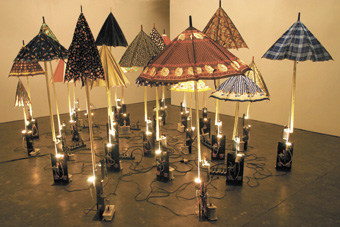
Ecole d’aviation (Flying School), Diane Landry
photo Tim O’Donoghue
Ecole d’aviation (Flying School), Diane Landry
For her performance, Morse Alphabet Soup, at RMIT University Union, Landry set up two turntables in front of the stage. Each is a large, slowly revolving pizza tray, on which she places a variety of objects in a planned sequence. A single bright light located behind each turntable projects a silhouette of the otherwise innocuous object on the turntable onto the auditorium’s blank cinema screen, creating a shadow puppet theatre. The objects—stencils used for lettering, egg-timers, drinking glasses, toy buses, dolls, a tiny bicycle and toy animals including rats positioned to suggest copulation—are selected for their symbolic power. Placed on the trays for a few seconds to a minute in a series of shifting superimpositions and juxtapositions, they create a darkly symbolic language addressing broader social realities.
Each turntable is equipped with a handmade phono arm and a stylus as large as a sewing needle in contact with the turning tray, sending a scraping sound through a multi-channel mixer to the auditorium’s PA. Landry complements the imagery by varying the sound-mix from screeching to moaning—it’s as if society is grinding itself to death. Parodying a DJ or a VJ, she blends objects, light and sound into a powerful cinematic experience. In her artist’s statement she discusses how projecting a silhouette to enlarge an object amplifies its presence and meaning and prompts a re-evaluation of the material world. She coined the phrase ‘oeuvre mouvelle’ to describe her work, noting that, like a piece of music, the work unfolds over a period of time and cannot be absorbed quickly.
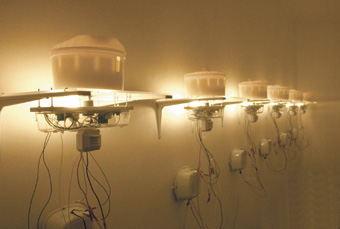
Je ne trouve pas ma montre, elle ne s’est pourtant pas envoiée’ (I can’t find my watch yet it hasn’t flown away)
photos Tim O’Donoghue
Je ne trouve pas ma montre, elle ne s’est pourtant pas envoiée’ (I can’t find my watch yet it hasn’t flown away)
Landry’s exhibition at Bus included three works that further attest her passion for robotics but also explore the nature of perception. Ecôle d’aviation (Flying School) comprises 20 umbrellas that open and close, the lights beneath them casting shadows like slow-moving clouds on the white gallery ceiling. Accompanied by a gentle sighing from the little electrically driven air pumps that activate each umbrella, this slow, mechanical unfolding of silhouetted forms projected into the room becomes a metaphor for our programmed, repetitive lives.
Je ne trouve pas ma montre, elle ne s’est pourtant pas envoiée (I can’t find my watch yet it hasn’t flown away) comprises 6 electrically-driven salad spinners mounted chest-high on a wall, each activated by a movement sensor and revealing, through a tiny aperture, glimpses of fragments of photos of someone going about her daily routines. In her notes Landry refers to the early 19th century parlour device, the Zoetrope, which preceded the birth of cinema and which demonstrated persistence of vision, or how the eye is tricked into seeing movement in a rapidly changing sequence of still images. The viewer gleans a ‘story’ from the imagery in the salad spinners that, ironically, is only triggered by the movement sensors. Landry’s use of vernacular found objects such as toys, salad spinners, surveillance devices and umbrellas, reconnects us to the everyday world and also shifts the work away from high art and cinematic traditions.
But perhaps Diane Landry’s most engaging work is Le bouclier perdu (The lost shield), a video of a woman (the artist) apparently tossing and turning in disturbed sleep on a couch. The video is constructed from a series of still photographs shown in a sequence of superimpositions and dissolves that disrupt the normal cinematic illusion of seamless movement. This artificial portrayal of broken, dreamy sleep becomes a metaphor for the inauthenticity of photography and cinema.
By recalling the work of moving picture pioneers such as Muybridge and the Lumière brothers, Landry’s work reveals how the moving image has been used to structure our perceptual awareness and understanding. Her work questions the impact of the persistence of vision to address the nature of visual comprehension and its relationship with emotional memory, highlighting our tendency to imbue the imagery that flashes before our eyes with narrative meaning and intent. By showing us how easily illusions can be created, we are prompted to see through our visual world and to acknowledge that the ‘truth’ we deduce from what we see may be a trompe l’oeil, a projection of our emotional state or a figment of our imagination.
The RMIT evening also included a performance by sound artist Ernie Althoff, a sound/video performance by Snawklor and Dale Nason, and the screening of Pia Borg’s great new video, When Objects Dream, all of which, with Landry’s work, neatly complement each other.
Diane Landry, Morse Alphabet Soup, RMIT University Union Kaleide Theatre, Dec 9; Bus, Melbourne, Dec 12-23 Dec 2006 www.clic.net/~dilandry
RealTime issue #77 Feb-March 2007 pg. 54
© Chris Reid; for permission to reproduce apply to realtime@realtimearts.net
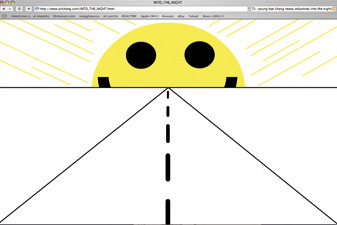
(Out of the Internet and) Into the Night, Young Hae Change Heavy Indsutries
IN A LARGE STUDIO ADJOINING THE NEW STATE LIBRARY OF QUEENSLAND, MAAP 2006 OFFERS VISITORS INTIMATE, INTENSIVE BROWSING OF MEDIA ART IT HAS COMMISSIONED AND COLLECTED. THE LIBRARY, A PARTNER IN MAAP'S OUT OF THE INTERNET, IS IMPRESSIVE ARCHITECTURALLY, IN SCALE AND IN THE ARRAY OF SCREEN AND COMPUTER FACILITIES AVAILABLE TO USERS. IT'S WELL PLACED AS PART OF THE SOUTHBANK CULTURAL PRECINCT BETWEEN THE QUEENSLAND ART GALLERY AND THE SPECTACULAR NEW GALLERY OF MODERN ART. MAAP FITS WELL IN THIS SCHEME OF THINGS, EMBRACING AND INTERROGATING NEW MEDIA WORK AS ART AND SIMULTANEOUSLY AS PART OF GLOBAL COMMUNICATION NETWORKS.
In titling MAAP 2006 Out of the Internet, artistic director Kim Machan was hoping to give internet art a palpable exhibition presence as well as an online life: “I am shepherding the work back into taking a material form in the museum context, to achieve authority, blending the different fields in which they operate, and joining another official art history context. Making a representation of all the works in the State Library of Queensland adds another dimension—or escape route—out of the closed museum context” (RT 75, p2).
This physicality manifests itself for visitors too. Near the entrance to the exhibition, on Singapore based artists Charles Lim and defence scientist Melvin Phua’s exercise rowing machine, alpha 4 (GENERATOR), you work hard until the point at which you’ve powered up the battery which kickstarts a computer that is set up as a server for its own website and which sends the image of you rowing out around the world. As Machan observes in her catalogue notes, there’s something dryly funny about an “overly earnest scientific approach coupled with the absurdly circular demonstration.” This is interactivity that not only makes you work but triggers ideas of bizarre potential applications.
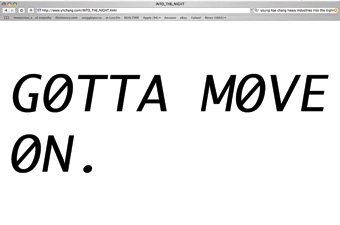
(Out of the Internet and) Into the Night, Young Hae Change Heavy Indsutries
In the relaxed MAAP exhibition space, scaffolding creates a second level to which you climb to view YOUNG-HAE CHANG HEAVY INDUSTRIES’ flash animation, Into the Night, on a big screen, or look left to another featuring G’day, G’day by Japan’s Candy Factory. Beneath the floor are rows of video monitors on which, with headphones, you can choose to view a host of DVD-based works from the Move on Asia Clash & Network Exhibition originally shown in Seoul and Tokyo and, once sifted through, featuring some strong work. A seat per screen makes the experience a serious as well as comfortable one (galleries take note). In Zhong Shuo (People say…; Australian artist Iain Mott with Chinese collaborators li Chuan Group, Ding Jie) you can set yourself down on cushions in a small house to hear Chinese people speak of their experience of cities as they change (www.reverberant.com; RT 71, p26).
As promised by Machan, YOUNG-HAE CHANG INDUSTRIES’ Into the Night offers a cinematic version of what is usually an internet experience. The Korean pair have created a wickedly witty text rendition of a film-noirish road movie replete with the artists’ own fine jazz score backing a hilarious argument in aptly dead-pan computer-generated speech. The only concessions to imagery (the scale, distribution and lyrical movement of the words make the art here) come in the form of road markings flickering into the distance and a happy face sun on the horizon. There’s a shocking crash (the word falls off the screen) and fitting closure after droll renditions of Talk About It and Funky Town: “You kill me.” Go to www.yhchang.com to see Into the Night, and many more inventive works, on the small screen, but it must be said: BIG is good.
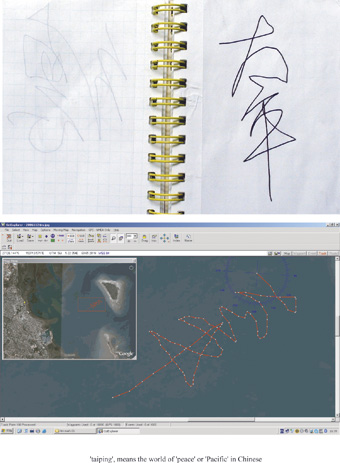 Feng Mengbo, The Invisible Words: A GPS Calligraphy Project, 2006,
Feng Mengbo, The Invisible Words: A GPS Calligraphy Project, 2006,
Moreton Bay, November 2006
As with Candy Factory and Young Hae Chang, Feng Mengbo (China) has a longstanding relationship with MAAP. GPS technology is employed quite laterally in his appealing Invisible Words installation. He uses it to ‘write’ Chinese characters across city maps (www.maap.fengmengbo – expired) and oceanographic charts. The artist travels the route (in “kilometres’ long brush strokes”) determined for him by the shape of a an ideogram and records the result as he goes. For MAAP he worked off the coast of Queensland. The finished exhibits, where the techno-calligraphy hovers beautifully between the impressionistic and precise, are accompanied by images of the artist ‘writing’ at sea. RT
MAAP: Out of the internet, artistic director Kim Machan, State Library of Queensland and international partner venues, Nov 30, 2006-Jan 25, 2007; www.maap.org.au. For the full extent of MAAP Out of the Internet activities see Danni Zuvela’s interview with the curators in RealTime 75.
RealTime issue #77 Feb-March 2007 pg. 34
© Keith Gallasch; for permission to reproduce apply to realtime@realtimearts.net
IN CHARLES STROSS’ SCI-FI NOVEL THE SINGULARITY SKY, CULTURAL COLONISERS INVADE A PLANET WITH CORNUCOPIA MACHINES WHICH CHURN OUT EVERY KIND OF OBJECT AND TECHNOLOGICAL DEVICE ON THE INHABITANTS’ WISH LIST IN RETURN FOR THEIR IDEAS, HISTORIES AND BELIEFS. THE ALIENS, WHO ARE NEVER SEEN, LEAVE THE PLANET AND ITS CULTURE IN A RIGHT MESS, RUINING THE ALREADY DODGY DISTRIBUTION OF POWER. THE AUSTRALIAN NETWORK FOR ART AND TECHNOLOGY (ANAT) IS A VERY DIFFERENT KIND OF CORNUCOPIA MACHINE, A BENIGN ONE HELPING US MAKE THE MOST, ETHICALLY AND AESTHETICALLY, OF THE NEW TECHNOLOGICAL TOOLS WE ARE FLOODED WITH BY OUR OWN ALIENS, THE TECHNO-CORPORATIONS.
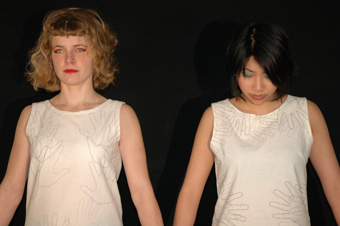
Finger Dress, Joanna Berzowska
courtesy of the artist
Finger Dress, Joanna Berzowska
When I comment on the apparent fecundity of ANAT’s 2007 program, director Melinda Rackham informs me that, of course, Anat is the ancient Egyptian goddess of fertility and crops, and of war. Even so, the program is not quite the horn of plenty Rackham envisaged given limits on funding, consequently “there was some cutting back. So we’re really looking for partners and sponsors outside grant funding in order to employ additional staff to make what we’re doing sustainable.”
in the loop
One of Rackham’s passions is keeping media artists informed, in touch, in the loop. A highly developed mailing list is vital and she’ll look to the model she employed when she instigated the empyre list with its moderated discussions and papers in 2002 (www.subtle.net/empyre). ANAT will also revitalise the lapsed Synapse Database, “an online resource promoting the nexus of art and science”, by bringing writers and curators as well as artists and scientists into its fold (www.synapse.net.au). Because media arts have difficulty connecting with the wider community, says Rackham, it’s vital to attract a diverse audience, “like the scientific community or Cosmos readers [www.cosmosmagazine.com], people who enjoy reading about science. We have to make media arts more visible.” As well, ANAT’s new website, Artport, will play a major role in identifying and promoting artist and organisation members, integrating a diverse field and, as well, reaching out to artists in other fields and a wider audience, “working like a rhizome.”
everyday potentials
A sizeable part of ANAT’s current focus is on the technological innovations pertaining to everyday life. While attending festivals in recent years Rackham noticed developments in techno-wearables. She was alert to how “textile manufacturing and computing shared the same root—think the Jacquard loom and the difference machine. Why not take a different tack and reunite them. It’s aesthetic, it’s fun, technologically advanced and pushing at the edges.” Some wearables are eminently useful, many of them playful and some surreal: Rackham cites the “really practical handbag you can scream into in public places and let the cry out later.” But she also mentions Aphrodite shoes; designed initially for the safety of prostitutes, they are fitted with GPS receiver, alarm and back-to-base signal. (www.theaphroditeproject.tv/saftey). Meanwhile major fashion companies, especially in Italy, are alreading marketing ‘techno-couture’: “Zegna’s parka with pores that open and close, Valetino’s waterproof cashmeres and Alexander McQueen’s papier-mache leather” (“Made in Milan”, Australian Financial Review, Jan 25-28).
The upshot of Rackham’s interest is Reskin, a two-week intensive workshop for Australian media, visual arts and craft practitioners led by prominent overseas makers in the field and related practices: Joanna Berzowska (a Montreal expert in responsive textiles and clothing), Susan Cohn (a Melbourne goldsmith and designer), Stephen Barrass (Canberra-based interaction designer and artist), Elise Co (Los Angeles-based multimedia designer and programmer), Alistair Riddell (Canberra-based interaction design artist and researcher) and Cinammon Lee (Canberra-based metalsmith). Berzowska’s many imaginative and often amusing creations include “memory rich clothing” pictured on this page in the form of a “finger dress”: it’s “an intimacy map of the body, recording and displaying where a person has been touched” (www.berzowska.com).
Rackham is impressed with the high calibre of the Australian artists involved in the workshop (including Keith Armstrong, Somaya Langley, Catherine Truman, Michael Yuen, Robin Petterd) and notes that ANAT, a media arts organisation adopted as a client of the Visual Arts Board in the wake of the recent Australia Council restructure, is leading the way for the board’s traditional clientele in engaging with technological innovation and in an international context. In RealTime 78 Dan Mackinlay will report on the Reskin exhibition and forum.
pixel.play & portable walls
ANAT staff member Sasha Grbich, was one of the EPIC (Emerging Producers in Community) team (RT73, p9), focussing on mobile phone art in regional areas in South Australia with ANAT in the pixel.play program. The next stage of pixel.play is Portable Walls which, says Rackham, “is an outgrowth of the EPIC program and has really grown on its own”. Portable Walls will exhibit on phones and accessible, small DVD player screens the work of young makers and, depending on sponsorship, could tour to over 20 suburban and regional centres around Australia. Rackham says that if she’d seen this kind of art in a gallery when she was growing up in Tamworth: “I would have become an artist much earlier. Exposure of work that we take for granted in the cities is vital in the regions.” Pixel.play will show as part of the 2007 Come Out Youth Festival in Adelaide, May 7-19, featuring work on mobiles from 24 schools in the Mercury Cinema foyer (www.comeout.on.net).
opensourcing
The Annual ANAT Media Lab is titled Still Open, comprising two-day workshops in Perth, Melbourne Brisbane in conjunction with the Biennial of Electronic Art (BEAP07) and SymbioticA, Perth, Open Channel in Melbourne and Creative Commons at QUT, Brisbane. The focus is on opensource, the collective authoring of software, specifically the Linux operating system as a model of democratic and low cost cooperation. The workshops aim “to provide hands on experience; and to initiate local networks and projects.” The emphasis will be on the application of opensource practice and theory to “networked art and software development, print and online publishing, and in the scientific arena where the open science movement encourages a collaborative environment in which science can be pursued by anyone who is inspired to discover something new about the natural world.”
The Lab facilitators are publisher and media artist Alessandro Ludovico (Italy) producer of the online and print publication neural (www.neural.it); free software hacker and new media activist Andy Nicholson (Australia); and interdisciplinary artist and researcher Beatriz da Costa (USA), a former collaborator with the Critical Art Ensemble who works in open science.
The title Still Open was designed to match BEAP07’s stillness theme, but is also an apt reminder, says Rackham, that opensource is still a key media factor and “that there’s more to life than Microsoft and iPods.” Asked about the relatively brief duration of the workshops, Rackham points out that the cost of the lab is considerable and that after their two-day workshop experience, participants will stay in the loop, online with interstate workshoppers. She comments that in a climate where too many things are done on the cheap, ANAT’s big investment has been in Reskin and that she has effectively put one and half years of ANAT workshop funding resources into the event to ensure that it is of a scale to make it truly worthwhile, to influence artists and to push the work out into the community, “to really build on what we have started.”
new niches
ANAT is continuing its vital Professional Development Travel Grant program: the organisation’s membership magazine, Filter, documents artists’ reports on their travels. The grants take many artists overseas to research and develop their art and provide the potential for exhibition and collaboration. The Synapse Art and Science Residency Program is particularly targeted at developing “dynamic creative and collaborative partnerships between scientists and artists, science institutions and arts organisations.” The program is managed by ANAT as part of the Australia Council InterArts Office’s Synapse Art and Science Initiative. With two local residencies already completed in the second program, an international residency will occur at Rothamstead Research, Hertfordshire, UK assisted by Arts Catalyst, the UK equivalent to Synapse. Lynnette Walworth will take up this residency early in 2007 for eight weeks. Synapse Art and Science Residency Program 3 will extend the program into the Asia Pacific region. For Arts Victoria ANAT is now managing the AIR (Arts Innovation Residency) Art and Science Residency Program with three residencies to enable Victorian scientists and artists to develop collaborative research and projects during 2007. ANAT is also a member of Arts Active, a currently office-less international gathering making the most of the residencies boom, says Rackham, not just in universities but in commercial laboratories.
through the portal
ArtPort, ANAT’s radically refurbished website will be launched in 2007, shrinking distances nationally and internationally to connect Australian artists with each other and the world, making them, says Rackham, more visible and approachable. Artport will detail the careers and achievements of member artists and organisations; it will stream works; house the Synapse Database site; provide a media arts portal; and archive ANAT’s history as it approaches its 21st birthday.
soundings
Also in the pipeline for 2007 is Synthesia, a DVD with sound, images and critical writing by some of Australia’s leading experimental sound artists. Rackham is committed to ANAT “exploring sound culture in as many ways as possible.”
the ANAT role
I ask Rackham about ANAT’s role. It’s not quite like the politically active National Association of Visual Arts (NAVA): perhaps that will be the role of the Australian Media Arts Organisation (AMAO) if it gets past the incipient stage. Rackham says that ANAT’s role is to educate the public, make media arts more accessible and push for more funding by showing that the media arts are indispensable. To this end, as well as ANAT running a strong program, Rackham sits on a wide range of committees.
I ask about the mood of Australia’s new media artists. “Pretty depressed”, replies Rackham, as indicated by the lack of funding applications to the Australia Council and a general lack of exposure. However, she feels that “confidence is returning and that the Australia Council is really trying to reach out to artists.” She herself, as an award-winning net artist, finds the failure of Australian institutions to support the form exasperating; overseas it is thriving. Similarly she feels that while work on locative media is strong it should be taken up extensively in the community arts area because of its accessibility and artistic potential. The commitment to developing locative media art is, she says, much stronger in the US. Overall, Melinda Rackham feels that emerging practices, like work in techno-wearables, need to be rewarded so they can develop to their full potential and give hope to the young artists engaging with them.
www.anat.org.au/reskin
Great new images of prototypes produced in the reSkin lab are now available for download: http://www.flickr.com/photos/reskin/sets/72157594520118616/
RealTime issue #77 Feb-March 2007 pg. 25
© Keith Gallasch; for permission to reproduce apply to realtime@realtimearts.net
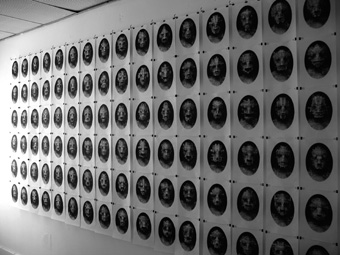
Murray McKeich, pzombie installation
photo Jonathan Rann
Murray McKeich, pzombie installation
THE SMALL, HIDDEN-AWAY ROOM IN MELBOURNE’S CBD HAS SOMETHING OF THE AIR OF A FORENSICS LAB. FACES, LIKE RETRO-FUTURISTIC MUG-SHOTS, ADORN THE MAIN WALL. AT FIRST THIS IS SUGGESTIVE OF THE REPLICATION OF THE SAME IMAGE—UNTIL THE INDIVIDUAL PATHOLOGY OF THE SUBJECT’S PHYSIOLOGY BECOMES UNNERVINGLY APPARENT.
Murray McKeich has been using computer technology for many years to create his macabre imagery. But it has none of the high-gloss or hi-tech aesthetics that so often characterises such work. Indeed, McKeich’s approach suggests the opposite; it is in his abuse of technology that the potency emerges.
For all of the cool, medical-examination style of installation, what creates the grit in these works is McKeich’s materials. He uses rubbish as his source material; all sorts of rotting, stinking, putrid crap oozing all over his state-of-the-art technology. When he scans his detritus it may clear away the smell, but not the hint of malevolent, maggot-ridden rot.
McKeich titled this body of work pzombie. Does this make his zombies postmodern zombies, psychotic zombies (aren’t they all?). Is he investigating the psychology of zombies or, as Kirsten Rann suggests in her accompanying essay, perhaps McKeich is investigating the philosophical “discourse in the field of cognitive science, specifically in relation to human consciousness.”
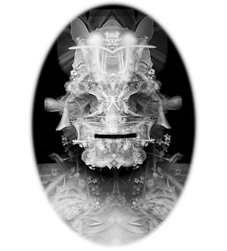
Murray McKeich, pzombie
The zombie seems to be rampant in popular culture. There are the literal, obvious references in such recent films as 28 Days Later and the remake of Dawn of the Dead. There are hints of zombification in Cormac McCarthy’s recent novel The Road. And I would not be the first to watch news footage of White House press conferences and wonder about a certain individual. The zombie is, in popular culture, the embodiment of evil, a flesh eating and mindless ogre. A pzombie, as Kirsten Rann points out in her catalogue essay, is in fact a real term in discussion of the mind and taking this further into the realm of artificial intelligence—what in fact it means to be conscious.
But McKeich’s pzombies may also be the stunned and stunted results of information overload. They are most certainly, if not brought back from the dead, then constructed from death, decay and detritus—doll’s heads, chicken bones, rotting lettuce leaves—a suppurating morass constructed in a hyper-drive voodoo ritual of McKeich’s own devising. And of course voodoo spirituality runs like a thick succor through such epics as William Gibson’s Neuromancer and the Wachowski Brothers’ Matrix series. And, although it has by now become a cliché, McKeich is most definitely enacting Gibson’s now-famous catch phrase: “The street finds its own use for things.”
McKeich’s pzombies are deeply creepy. They are mug shots from hi-tech hell and one wonders if these ‘portraits’ aren’t the result of what we now witness not just via the news, as gory as that can be, but what we dub ‘entertainment.’ Writing on the television series CSI in The Guardian newspaper last year, the author JG Ballard articulated this succinctly:
Lurid computer graphics provided flashbacks to the actual homicides, a stomach-churning revelation of what actually happens when an axe strikes the back of the skull, or a corrosive gas gets to work on the lungs…Light and safety are found only in the crime lab, among its high-tech scanners and its ruthless deconstruction of human trauma.
I suspect that the cadavers waiting their turn on the tables are surrogates for ourselves, the viewers…I fear that we watch, entranced, because we feel an almost holy pity for ourselves and the oblivion patiently waiting for us.
McKeich has dabbled in this strange realm of portraiture before, notably for 21•C in 1996 when he rendered an impressionistic and grotesque portrait of The Unabomber for the magazine’s cover. Indeed, before becoming known as an artist in his own right, McKeich was renowned as a powerful illustrator. The crossover moment, at least in terms of published material, was arguably his collaborative work with the writer Darren Tofts on their 1997 book, Memory Trade. Since then he has exhibited his digital maelstroms regularly.
McKeich has continued to develop his bizarre language in multiple forms. Accompanying his pzombies are hypnotic moving images, one of which was projected on an outside wall above the entranceway. This projection reveals McKeich’s other side, a more ambient, almost poetic shift in which his use of detritus becomes a floating, hallucinatory opus. Perhaps this is the womb of the pzombie floating in a toxic amniotic fluid.
Murray McKeich, along with such younger artists as Irene Hanenbergh and Brie Trenerry, are finding fresh directions in the world of the digital. By allowing their work to embrace a darker aesthetic they seem very much of their time. McKeich is leading the way into a decidedly challenging world.
Murray McKeich, pzombie, curator Kirsten Rann, Counterpoint, Melbourne, Nov 29-Dec 14
RealTime issue #77 Feb-March 2007 pg. 26
HOW DO WE DEFINE THE CONNECTIONS BETWEEN JAPAN AND AUSTRALIA IN THE NEW MILLENNIUM? TO WHAT DEGREE CAN COMMUNICATIONS TECHNOLOGIES AND THE EFFECTS OF GLOBALISATION MEDIATE NATIONAL BOUNDARIES? ARE JAPANESE CITIES COOKIE CUTTER REPLICAS OF ONE ANOTHER? THE RE:SEARCH EXHIBITION, AN ART COLLABORATION BETWEEN AUSTRALIA AND JAPAN, SETS OUT TO ADDRESS QUESTIONS CONCERNING THE EFFECTS OF GLOBALISATION ON CULTURAL IDENTITIES AND THE POTENTIAL FOR CONNECTION BETWEEN PEOPLE AND SPACES.
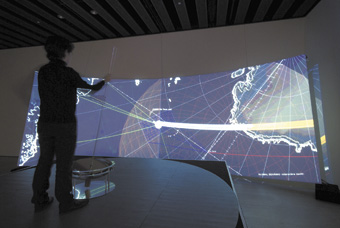
Norimichi Hirakawa, Global Bearing
In 2006 Experimenta Media Arts collaborated with the Sendai Mediatheque to offer Australian and Japanese artists a two-month residency at Sendai, in the Miyagi Prefecture. Curated by Kent Shimizu, the resulting exhibition reveals a diverse range of dynamic new media art that imagines Sendai at the centre of a matrix of local, national and global networks.
The Re:search exhibition is a hybrid of the traditionally lit and hung ‘white cube’ gallery with the darkened environment of the participatory ‘black box’ experience conventionally used to exhibit innovations in science. Re:search displays art created from materials including moving and still images, digital and analogue sound, maps, global positioning devices, satellite images and black and white, low definition footage seemingly from closed circuit television cameras. Themes that emerge include: the fracturing of identity, the escalation of paranoia and alienation within surveillance cultures and the potential for deception within commodity driven societies. Such themes are explored in relation to Sendai, Japan, Australia, the planet and some even extend into the universe.
Re:search opens with Norimichi Hirakawa’s Global Bearing, a large concave screen, upon which is projected a satellite map of the globe, complete with meridian lines. Global Bearing prioritises the Sendai Mediatheque by placing it at the centre of the map and measuring the distance between it and the rest of the world. The curved screen extends beyond the limits of peripheral vision, and the participant is invited to navigate the globe using what seems to be an oversized joystick. Travel is initially deceptively simple, but it becomes more difficult as the map begins to spin and flip. The participant is challenged to control the direction, speed and stability of the virtual map. Whilst this might suggest the difficulty of travel, or possibly the dislocation between virtual and physical spaces, more likely Global Bearing is a reminder of the inability of humans to control their environments.
In Conversations, Intimate moments with random strangers, Alex Davies explores the dual impulse of connection and alienation in an environment of dislocation and surveillance. Communication is at the centre of this exhibit, but Conversations is less about verbal discourse and more focused on investigating the possibility of connection through the eyes of anonymous people. Individuals are singled out from a crowd as they glance towards the camera/viewer. In elongating the duration of the moments of visual connection, Conversations seems to promise imminent contact. But because these intimate moments are fleeting and finally fail, ultimately this exhibit emphasizes unrequited desire. A similar illusion of proximity and imminence through the manipulation of spatial and temporal elements continues in Davies’ second exhibit, Swarm. Here he includes the visitor within the exhibit as a horizontal screen extends to reveal composite footage of visitors to the gallery, past and present.
Craig Walsh’s Big in Japan exhibits the artist himself inflated to a huge scale, towering over the city on a billboard. Big in Japan constructs levels of deception, obviously in the reversal of the dynamics of scale between the human and the metropolis, but also by employing a model to portray the image of the artist. The work questions the position of art within commodity-driven cultures, engaging the eccentricities of advertising. On opening night, Walsh employed female models to hand out tissue packets emblazoned with the billboard image. Across two adjacent screens, Walsh produces what appears to be closed circuit imagery (complete with time codes) as hidden cameras record locations within Sendai. Initially disquieting in its invitation to voyeurism, closer examination reveals that the low definition footage is carefully constructed.
<img src="http://www.realtime.org.au/wp-content/uploads/art/3/385_haslem_experimenta.jpg" alt="David Haines & Joyce Hinterding, Electromagnetique Composition for Building,
Plants & Stars (2006)”>
David Haines & Joyce Hinterding, Electromagnetique Composition for Building,
Plants & Stars (2006)
photo Michael Myers
David Haines & Joyce Hinterding, Electromagnetique Composition for Building,
Plants & Stars (2006)
Another outstanding exhibit is the David Haines and Joyce Hinterding collaboration in the production of Electromagnetique Composition for Building, Plants & Stars. Haines-Hinterding’s imagery of vivid green, lush, overgrown foliage slightly swaying in the breeze is juxtaposed with a soundscape comprising low frequency noise from within the Mediatheque, extending to an 18 kilometre radius of Sendai and including sounds emanating from the Milky Way. The soundscape is picked up on the copper wire antenna that spirals around the vertical rods of Mediatheque’s architecture. Image and sound combine to produce compelling links between the immediate space, the local city and the universe. The incredible beauty and simplicity of the imagery and the surprising range of the soundscape results in a sublime imagining of nature and science.
Also using soundwaves to great effect, The Sine Wave Orchestra’s contribution, Compath, a participatory sound project, relies on the user to create their own sine wave as a form of communication, each wave merging with others to create a collective soundscape. Employing fader levels, Compath appears to use old technologies to create distinctive effects. The emerging sounds are unique due to the range of options available to the participant.
The magic of Lieko Shiga’s photographs is created using manual techniques in re-photographing and printing. The Golden Mirage series was produced during her residency in Brisbane earlier in 2006 and it reveals a fascination with the impact of the elements on Australian landscapes and inhabitants. Iconic images of backyard bonfires and weathered faces of Australian men stand out in a range of dreamlike portraits of humans situated within surreal landscapes. Space is crucial to Shiga’s photographs and some locations work to suggest alienated inhabitants. In one of the untitled photographs from this series, the emptiness of a restaurant represents little help for a woman who sits at a large table, the blur of her head suggesting that she is suffering a seizure. Bizarre, paranoia-fuelled nightmarish compositions combine with a luminescent aesthetic to create images that are compelling and beautiful.
The Veil series of haunting and evocative photographs was produced during Shiga’s residency at Sendai. It constructs eccentric images of Sendai at night. A fluorescent pink shed in a backyard appears disconcerting not only in the vivacity of its colour but the darkness beneath the building also offers an impression of levitation. In another evocative landscape, Shiga attached cotton buds to a dead tree producing a stunning, luminescent image of revitalization within an arid landscape. In an eerie domestic scene, a light hanging above a ransacked lounge room seems to have sucked up any sign of life, only the whirlwind fragments of detritus remain. One of the most poetic images of desire and dislocation is the visualisation of the dream as an incarnation of a woman floating above a sleeping man, suspended by invisible forces.
The Sendai Mediatheque is an appropriate site for the Re:search exhibition. Designed by Toyo Ito, the mediatheque’s glass façade (or skin) acts simultaneously as an invitation to enter and as a reflection of its surroundings. Each level is linked by shafts of light that connect and illuminate the spaces. These shafts also house 13 vertical steel lattice tubular columns that appear like tree trunks rising from the ground floor to the rooftop. The mediatheque features archives, reading spaces, as well as a permanent display of the work of local artists. Intertwining the local with the global, nature with science, the Sendai Mediatheque is the perfect host for such an exhibition of visionary and creative new media art.
Re:search: an art collaboration between Australia and Japan, Sendai Mediatheque, curator Kent Shimizu, in collaboration with Experimenta, 2006 Australia-Japan Year of Exchange; Tokyo, Nov 25-Dec 25, 2006
RealTime issue #77 Feb-March 2007 pg. 30
© Wendy Haslem; for permission to reproduce apply to realtime@realtimearts.net
FEMINISTS HAVE LONG BEEN CONSUMED BY THE RELATIONSHIP BETWEEN GENDER AND TECHNOLOGY. WITH THE BIRTH AND RISE OF SUCH GIBSONESQUE “CONSENSUAL HALLUCINATIONS” AS CYBERSPACE, IT WAS FEMINISTS SUCH AS DONNA HARAWAY, SADIE PLANT, LISA NAKAMURA AND ALLUCQUÉRE ROSANNA STONE WHO SOUGHT TO ARTICULATE THE REPLICATION OF OFFLINE INEQUALITIES ONLINE. IN AUSTRALIA, THE BEGINNINGS OF NEW MEDIA WERE STRONGLY TIED TO ADDRESSING THESE CONCERNS AS EPITOMISED BY THE WORK OF VNS MATRIX.
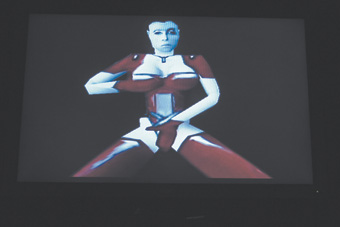
Tobias Berstrup, Polygon Lover
Extending the feminist agenda, new media theorists and practitioners began to consider how language and ethnicity shape the experience of technology and their impact on offline relations. In the ‘global’ world of the internet we can see that the dominance of English is quickly being contested by the increasing appearance of Chinese, Spanish, Japanese and Korean sites. The ‘local’ is contesting an homogenised ideal of globalisation. Negotiating the local—establishing co-presences, virtual and actual—is particularly prevalent in online gaming communities in what TL Taylor dubs “play between worlds” (Play Between Worlds: Exploring Online Game Culture, MIT Press, 2006).
So how can we think of gendered ideas of technology in a period where gender is but one of many complex and competing factors influencing our relationship to technology? With this question in mind I ventured along to Teknikunst. Curated by dynamic duo Kristen Condon and Lynsey Hagen, this year’s exhibition took as its title Condon’s neologism, “GenderTopia.”
The impressive line up of artists included Josephine Starrs (co-founder of VNS Matrix), Melinda Rackham, Linda Dement, Cynthia Verspaget (in collaboration with Adam Fiannaca), Rosie X, Michelle Siciliano, Oliver Ressler (Vienna), Jose Carlos Casado (New York) and Tobias Bernstrup (Sweden). Whilst some of the individual works were compelling, others sat together uncomfortably, like two people shouting (in different languages) over each other. Moreover, some of the works were not great examples of the artist’s oeuvre. In Josephine Starrs’ video, Pocket Calculator, the artist innanely sings a karaoke-style version of a Kraftwerk song accompanied by stereotypical images of Tokyo. Any lo-tech vs hi-tech irony in the work was overshadowed by a suggestion of techno-orientalism (the Asian city exoticised as techno-centre) highlighting a notable lack of Asian new media artists in the exhibition.
In Armour, Rosie X (with Técha Noble, Laura Jordan and Wade Marynowsky) presents us with a series of scenarios navigated by a protagonist geekgirl. The intentionally naff flash animation explores the paranoia around the Y2K millennium hype (remember that?). But as one visitor proclaimed, “wow, that’s sooooo last century”, the problem was that this work—made in 2000—was not aptly contextualised as a comment on an historical moment. It just looked dated. The effect was exaggerated by its being placed next to a sociological, documentary style video work, Die Rote Zora, by Oliver Ressler. Made in 1998, this work documented the militant women’s group, Rote Zora’s 20 attacks against “patriarchical orders” such as the companies of Bayer, Schering and Siemens. The disparate themes and styles of the two works made their conjunction beneath the gender and technology banner unrevealing.
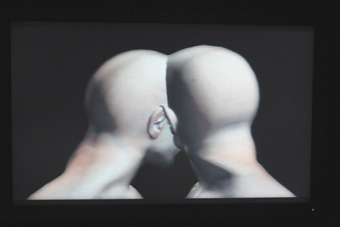
Jose Carlos Casado, Inside V.O4
Other exhibits added weight and currency to each other. Two 3D animations, Polygon Lover by Tobias Berstrup and Inside V.04 by Jose Carlos Casado, worked well together in their exploration of and play with body politics. Berstrup has the SiN game female character Elexis masturbating. Evocative of the style of game artist Brody Condon, Berstrup’s work suggests that gaming is still very much in need of feminist interrogation. Neighbouring this explicit work we find its inverse in Casado’s sublime metamorphosis of androgynous heads as they fuse, blur and transform into abstract forms. This poetic account of the ambiguities of identity and indivisibility is kin to the work of Chris Cunningham (particularly his music videos for Bjork’s All Is Full Of Love).
Morphing is also used in Claudia Hart’s beautiful Machinia. Based loosely on Titian’s Venus this beautiful nude isn’t a still life. She moves and she looks, slowly inverting the tradition of the male gaze. The title is a play on the growing genre of “machimina” (a neology encompassing machine and cinema) whereby game artists make self-reflexive and hyper-conscious mini-films of games that question ideas of interactivity, digital storytelling, game play and the politics of simulation. Machinia succinctly demonstrates how such disciplines as gaming owe much to cinema and the visual arts, but in other ways are emerging as media with their own specificities. In this way, Hart’s work is not only in dialogue with Casado’s fusion of the real and the reel, realism and abstraction, but also elaborates on Berstrup’s deconstruction of gender gaming stereotypes.
GenderTopia was an undulating ride, from wonderfully poetic and compelling works to questionable selections of exhibits without contextualisation. Works exploring issues around gaming and online-offline co-presence were the most compelling in respect of the theme. But why were there no artists from Asia given the plentitude in the region exploring Teknikunst’s theme? Beyond this oversight, GenderTopia highlighted gender and technology issues as ever pervasive, and reminded us that realms such as gaming are still in need of critique. Game on, feminist? Wii, Wii (Nintendo).
Teknikunst 06, GenderTopia group exhibition, Meat Market Main Hall, Melbourne, Dec 9-17, 2006; www.teknikunst.com
RealTime issue #77 Feb-March 2007 pg.
© Larissa Hjorth; for permission to reproduce apply to realtime@realtimearts.net
“IN THE FUTURE, SALLOW YOUTH WAIT LISTLESSLY FOR TRAMS THAT NEVER COME. THEIR SKIN GLOWS GREY DESPITE DARKENED SKIES AND BILLOWING RAINLESS CLOUDS…SCARRED, RAVAGED, TRAUMATIZED—YET STRANGELY INNOCENT—THESE YOUTHS APPEAR TO HAVE STEPPED STRAIGHT OUT OF A BOMBED HOSPITAL WARD. IN THE POST-FUTURE, THEY LINGER STILL—SHIMMERING GHOSTS OF THE AUSTRALIA THAT NEVER CAME” [NORTHERN VOID PRESS RELEASE].
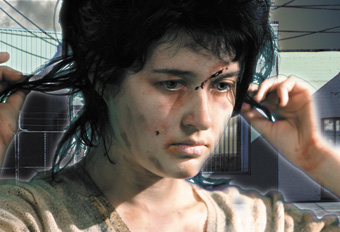
Thembi Soddell, Northern Void
photo Pancho Calladetti
Thembi Soddell, Northern Void
The genesis of Northern Void has been a haphazard series of events. Ph2 (Philip Samartzis and myself) were developing a piece for the Podewil Centre in Berlin some years back. Following changes in administration there, the funding for the project was then to be secured through a different body—one that was seeking projects which addressed site-specific and culturally dependent issues concerning the city of Berlin.
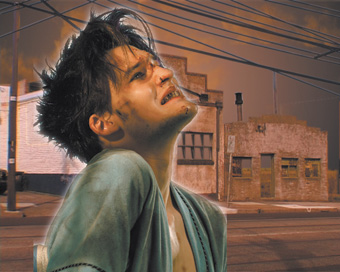
Nigel Brown, Northern Void
photo Pancho Calladetti
Nigel Brown, Northern Void
Initially I was quite deflated by this change. I have no connection to the idea that artists should be responsible to anything—their setting, their audience, their past, their new zones of activity. The idea that artists can somehow magically enter a new cultural domain and—purely through the suggestive power of curatorial legislation—be deemed not merely responsible but also capable of addressing anything is simplistic. I view the prime value of artists being their disconnection from society, through which energy lines and points of impact can eventuate, but not solely through an artist claiming he or she is ‘addressing/exploring/investigating’ some topical issue of the world. Like, that’s so Ben Elton meets the Venice Biennale.
But then I thought, okay, if Berlin wants me to ‘address the city’, then I’ll do just that. So I devised a story set across both World Wars, involving gas, prosthetics, skin, celluloid, dolls, corpses, music, bombs and movie theatres. I was going to film all the locations there, then get actors in a green-screen studio back in Melbourne to act out the narrative, then I’d composite it all together.
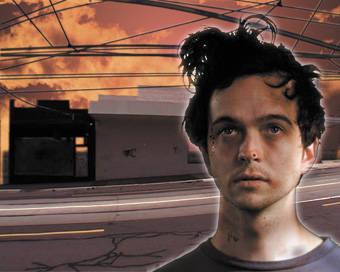
Gus Franklin, Northern Void
photo Pancho Calladetti
Gus Franklin, Northern Void
The Podewil project fell through, but actually I was liberated by this in two ways. Firstly, I felt enabled to devise any narrative/visual situation to which Ph2 could then work a live score. Secondly, I realized that I could address topical issues—but purely on my own terms, even if it be to my own detriment. My work generally deals with the ideological but always via submerged and what I contend are more opaquely politicised strategies buffed to gleam with Pop-ist surfaces.
So, shortly after, Phil Samartzis secured for Ph2 a showing of a new audiovisual work in Moscow. The idea of travelling and somehow ‘representing Australia’ again was repellent—yet now exciting. I thought, okay, I’ll show what Australia is like from my view. Not only that, I’ll predict what it will become.
Specifically, the idea of utilising science fiction for this purpose excited me. Science fiction is now exciting because it is the most bankrupt mythological narrative vehicle imaginable. When everyone from Hollywood to my mum can devise a dystopian scenario that champions rebels, critiques corporations, celebrates the hero’s journey and believes in humanity, then the form isn’t even worth subverting. My view of the future is a simple one: you’re soaking in it. In an era that commodifies the very notion of evolution as a sales strategy for iPods, then you know that humankind has reached a dead end that can only progress through complete decimation. But hey, that’s just my opinion. I’m sure breeders have great things in mind for the future of their children.
In this sense, Northern Void wonders what the future might be like in ways devoid of both grand narrative and social critique mythologies (both of which are equally suspect in their murky muddling of humanism and universalism). So I picked not some towering metropolis, but simply a three kilometre strip of shops and factories in Plenty Road, Preston—an outer northern Melbourne suburb.
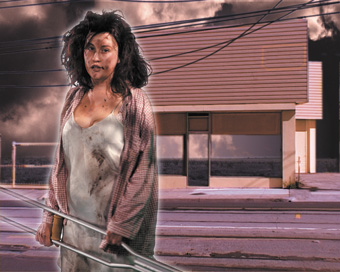
Madeline Hodge, Northern Void
photo Pancho Calladetti
Madeline Hodge, Northern Void
I hadn’t visited this area for many years (it’s near where I grew up) and I was shocked by how desolate it had become. Not an ‘aesthetic’ kind of Ed Ruscha desolate, just a real ‘present-tense’ banality that is old but locked in a frozen time period. Plenty Road is a mix of cheap 1970s brickwork and shrubbery with cheap 80s facades with cheap 90s computer-lettered signage. Failed small businesses delivering basic services in a saturated domain where nothing grows. Most importantly, this isn’t just Preston: this is a perfect snapshot of Australia. I’m very curious to see what the Russian response will be.
The video is a series of portraits of young people who have been made up to look ill—not spooky, just fucked-up and off-medication. I don’t drive, so I’m on public transport all the time, and really this is how I see most people. Things have developed this way as health services (especially mental health services) have been withering away over the last few decades. Plus the Plenty Road strip is a tram route, and public transport is another key service that has been utterly bankrupted in Melbourne. Like most of Australia, more work is now put into logo design and signage than an actual service.
A lateral inspiration for Northern Void comes from being in San Francisco in the early 80s and (long story for another time) spending a few nights in casualty at SF General Hospital. I was also struck by how many people were on crutches in the street—the more I realised this the more I saw. I remember thinking at the time that ultimately America is a vision of a future Australia. Some decades down the track now, I still relate to that perspective—not that Australia is somehow colonised by the US, but that Australia’s own de-evolving mechanisms have generated the state we’re now in.
Suffice to say that through the Northern Void project I’m optioning another way to consider things as they are, and working through another projection of this thing called Australia. Ultimately, it’s neither dystopian (because I think all utopias are deluded so there’s no point in opposing them) nor apocalyptic (because such a Judeo-Christian embrace of ‘finality’ is not part of my world view). Put simply, Northern Void is a suite of pastoral portraits which evidence the future as a slow drain. No eventfulness; no catharsis; no resolution. Just lots of young people getting sick too quickly, waiting for public transport that will never come. If change is required to forestall this, it will not come from obvious strategic measures. These symptoms need to be read devoid of the possibility of cure in order to perceive their status with clarity. Such is the audiovisual aim of Northern Void.
Northern Void will be performed live by Ph2 in multi-channel surround.
The video is divided into 3 sections: The Present (2013), The Future (2085) and The Post-Future (3079).
Spatial Drift presents Northern Void, director Philip Brophy, score performed by Ph2 (Philip Brophy, Philip Samartzis); Australian Centre for the Moving Image, Melbourne, Feb 17, 18, www.acmi.net.au, www.philipbrophy.com
RealTime issue #77 Feb-March 2007 pg. 28
© Philip Brophy; for permission to reproduce apply to realtime@realtimearts.net
IN A SANDSTONE BUILDING OVERLOOKING A PARK IN FREMANTLE, ATTENDEES TO AN INTERNATIONAL CONFERENCE SAT STARING, GIGGLING AND FROWNING AT PROJECTIONS OF VIRTUAL LANDSCAPES, PHOTOS, QUOTES AND STATISTICS. THE EVENT WAS A SPECIAL JOINT CONFERENCE BETWEEN CYBERGAMES: INTERNATIONAL CONFERENCE AND EXHIBITION ON GAMES RESEARCH AND DEVELOPMENT, AND INTERACTIVE ENTERTAINMENT 2006: THE THIRD AUSTRALASIAN CONFERENCE ON INTERACTIVE ENTERTAINMENT.
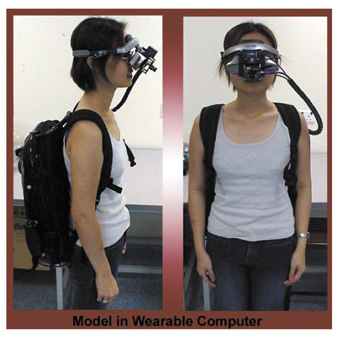
Model in wearable computer, Human Pacman (2005) Mixed Reality Lab, Singapore
Rest assured, participants did go outside and feel the sun on their cheeks, but the chuckling of children playing in the park was no subsitute for the serious study of how people of all ages play in the digital realm. Yusuf Pisan, Technical Chair and Founder of Interactive Entertainment (IE) outlined in the proceedings the motivation behind the conferences:
The interactive entertainment industry continues to grow at a rapid pace worldwide. This expansion needs to be examined not just in dollar amounts they contribute to the economy or the number of people playing computer games, but also in how our everyday interaction is changed and shaped by this new medium. We are defining not just a new field, but a new way of being.
The champions of our evolution are a mix of Australian and international practitioners and researchers from the fields of Artificial Intelligence, Media Studies, Human Computer Interaction, Design, Graphics, Cultural Studies and Psychology. We’ll start with industry. Elina MI Koivisto of Nokia Research gave one of the two keynotes on the “Vision of the Future of Mobile Games.” Nokia is attempting to move mobile gaming beyond the current approach of remediating familiar games like Pacman and Tetris. The company is exploring how the mobile, a device that is always with you and always connected, can facilitate the persistence of game worlds. For instance, they’ve published a cross-platform, massively multiplayer online role-playing game that you can play through your PC and phone: HinterWars: Aterian Invasion (Activate, 2005). Nokia are also looking at the way we interact with these game worlds by exploring applications that allow different input and feedback systems like game pads and motion bands.
Likewise looking at game world persistence and how to produce different ways of interacting is the Mixed Reality Lab in Singapore (www.mixedrealitylab.org). Adrian David Cheok provided lots of photos and descriptions of projects in his talk on “Social and Physical Interactive Paradigms for Mixed Reality Entertainment.” Mixed Reality Lab has created many games that are set in the real world but your actions impact on a virtual world. For example, Human Pacman (2006) involves a person donning a wearable computer and walking down the street. As you walk you devour cookies in the virtual world. Cheok also outlined a few projects that involve playing with your pet. For example, you can play chasey in a virtual world with your real life pet hamster in Metazoa Ludens (2006) or you can pat your hen remotely with Poultry Internet (2004). The lab is also interested in bringing elderly people and children together: Age Invaders (2006) has grandparent and grandchild shooting each other on a dance-floor-like setting with virtual ramifications.
Concerned with how elders (or teachers) can guide young people, Scot Osterweil, Project Manager for MIT’s Education Arcade (www.educationarcade.org), gave a passionate and canny talk on what he terms “learning games.” Games can be used for teaching but many extant ones, he explained, fail because of poor design. Many are created, for instance, with a “content stuffer” approach: they use an existing game platform and inject it with education related content. The result, he jokes, is “Grand Theft Calculus.” Osterweil makes the point that “without playfulness, a game is just going through the motions.’ As a guide, he juxtaposes four freedoms that he believes are the same for play and learning (outside of school): freedom to experiment, freedom to fail, freedom to try on identities and freedom of effort. Arguing that all game play is about learning, Craig A Lindley of Gotland University, Sweden, in “Game Play Schemas: From Player Analysis to Adaptive Game Mechanics”, divides what is learnt into three forms: interaction mechanics (how to interact with the machine), interaction semantics (associative mappings of that interaction) and game play competence (how to progress through the game).
There were five special sessions, the standout of those that I attended was “Experiential Spatiality in Games: Knowing Your Place.” Chaired by Nicola J Bidwell of James Cook University, it included a holistic selection of speakers exploring place, immersion and self. Ulf Wihelmsson of the University of Skövde, Sweden spoke about what he terms the “game ego”: “a bodily based function that enacts a point of being with the game environment through a tactile motor/kinesthetic link.” Wihelmsson argued that the game environment affects a person’s game ego through constraints on what they can do. Andrew Hutchison of Perths’ Curtin University explored how game graphics remove parts of our avatars. He entertained us with examples from games like Half-Life 2 (Valve Software, 2004) where your hand disappears when picking up objects, but is always present when holding weapons; and Doom 3 (id Software, 2004), a game with an extreme graphics engine that performs an array of blood-splatter and shooting effects, but doesn’t give us legs.
Although some games do give us legs, David Browning of James Cook University argued they don’t give us realistic interaction with the terrain. You cannot, for instance, get your feet stuck in mud. Games that are designed for proprioceptivity (using many senses to experience the weather etc) will engage players in the game world more. Georgia Leigh McGregor of the University of New South Wales, focused on the architecture of game worlds comparing World of Warcraft (Blizzard Entertainment, 2004) and Lord of the Rings: Battle for Middle Earth II (Electronic Arts, 2006) and finding that architecture in the former is designed as a spatial experience. The latter, however, treats architecture as an object that cannot be entered and explored. Truna (aka Jane Turner) gave a demonstration of a virtual world that was created to explore archives of the real world. The Australasian CRC for Interaction Design’s Digital Songlines (2005) project (songlines.interactiondesign. com.au) is a virtual landscape of Australia that you can traverse. Your presence in an area triggers local stories, providing a spatial navigation analogous to the manner the stories are recorded traditionally in Indigenous cultures. In her paper, “Digital Songlines Environment”, Truna expands on the culturally-aware design:
The design goal of this project is to reconstruct the Indigenous experience from an Indigenous perspective rather than the usual cultural archiving which tends to prioritise the needs of the database structure and meta-data tags and fields.
Two post-conference workshops, run by Scot Osterweil and myself, provided a more intensive insight into how to design experiences that address audiences rather than system architecture. Overall this first joint conference, chaired by Kevin Wong, Lance Fung and Peter Cole, was a thoroughly enjoyable experience. It was good to have such a cross-fertilisation of topics (only some of them covered here) and to have the chance to debate at length with delegates from around the globe. We didn’t solve what “new being” interactivity is birthing, but had fun in the kindergarten of its evolution.
CyberGames: International Conference and Exhibition on Games Research and Development, and Interactive Entertainment 2006: The Third Australasian Conference on Interactive Entertainment, Fremantle, Dec 4-6, 2006
RealTime issue #77 Feb-March 2007 pg. 29
© Christy Dena; for permission to reproduce apply to realtime@realtimearts.net
TECHNOLOGIES OF MAGIC BEGINS WITH A SIMPLE YET INTRIGUING QUESTION: “WHY IS IT THAT MANY TECHNOLOGIES, PARTICULARLY MEDIA TECHNOLOGIES, CONTINUE TO BE SHROUDED IN A MYSTIQUE, PRESERVING FORMS OF MAGICAL BELIEF WITHIN RATIONALLY ORDERED SOCIETIES?”
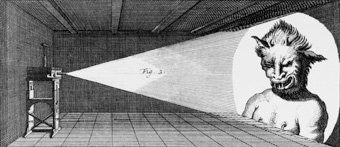 Lantern of Fear, Gulielmo Jacobo ’s Gravesande,
Lantern of Fear, Gulielmo Jacobo ’s Gravesande,
Physices Elementa Mathematica, Geneva, 1748, from Eyes, Lies & Illusions, ACMI
Advertising has long been a site for such expressions represented in, for example, Bell’s 1915 “weavers of speech” advertisement depicting an operator working “upon the magic looms of the Bell System” to weave “millions of messages into a marvellous fabric.” Or consider the 1950s “Spellbound” campaign from American company Ampex, promising users of its new audio system “an exquisite pleasure and a dangerous revelation.” More recently, figures of enchantment appear throughout the advertising of Motorola, Sony and Nokia (Sony’s 1990s “Magic Link” PDA, as just one example; advertisements cited are available at: www.adflip.com). And for its unfettered celebration of technology’s sublime power, it’s hard to ignore how Time magazine announced its front cover 2006 Person of the Year through that uber media of illusion and fantasy: the mirror.
This edited collection is a valuable addition to research examining the material and symbolic interconnections between magic and technology or what John Potts calls “media mysticism.” Although the contributors deal with practices of magic in diverse ways, the editors outline a common definition: “the key notion is the kind of performativity which arises from an agent of transformation whose effects are evident but whose operations are not apparent.” For Andrew Murphie, in his elegant chapter, “‘Brain-magic’: figures of the brain, technology and magic”, transformation and performance are crucial for understanding how power links the cultural fields of magic and technology: “magic has always been about power—over life and death and illness, over transformation, over appearance and disappearance…this is what technology is increasingly about as well.” Rather than viewing the cultural logic of magic as antithetical to science, Murphie explores the “indissoluble binding between magic and technology.”
The paradoxical yet symbiotic relation between magic and technology is a central preoccupation of the book. In her chapter on “the modest witness”, Anne Cranny-Francis revisits Donna Haraway’s work on the disinterested observer within scientific discovery. Cranny-Francis recounts a compelling ‘urban-legendesque’ story of two women who, while driving at night, encounter a threatening ghostly vision manifesting as a tailgating motor bike audible within their car and clearly visible through their rear vision mirror. However, when the passenger rolls down her window to remonstrate with the motorcyclist the vehicle ‘disappears’ to return only when the two glance back through their mirror. What’s interesting for Cranny-Francis is the subsequent discussion in which the passenger, a science PhD candidate, denies having had the experience. As a scientist, the woman refuses to believe in anything that is not explicable through logical and rational means. The driver then suggests that “perhaps science simply does not know yet how to describe such a phenomenon” to which the scientist replies “no, I simply do not accept what I saw; I did not see it.” This story illustrates the inherent ideological tensions of the objective observer. The scientist, argues Cranny-Francis, “could not afford to be known as someone who believes in things that are outside mainstream scientific thought. If she is positioned outside that mainstream, she will not be acceptable as a modest witness and so will be unacceptable as a scientist.”
Also exploring the unacknowledged ‘bridging’ of mysticism and science, are John Potts’ contribution on the contemporary ghost and Chris Chesher’s piece about the function of invocation within technological practice. For Potts, ghost discourse—including “academic parasychological research initiatives”, anecdotal reports from ghost hunters, and web sites selling ‘ghost detectors’—demonstrates the persistence “of mystical belief in societies founded on rationalist principles.” Modernity, he suggests, has never been fully “disenchanted” since “enchantment”, understood as a form of “belief in the supernatural”, continues to flourish “even in highly technologised cultures.” Arguing for the enchantment of Western modernity, Potts joins writers such as Simon During (Modern Enchantments: The Cultural Power of Secular Magic, Cambridge, Harvard, 2002) and Alex Owen (The Place of Enchantment: British Occultism and the Culture of the Modern, University of Chicago Press, Chicago, 2004). In his chapter on “The Muse and the Electronic Invocator”, Chesher develops his theory of the invocation. This “cultural form” he explains is “a call to a power outside ordinary fields of perception and action for immediate assistance, guidance or support.” The invocation operates through a diverse range of institutional and technological settings: “magicians invoke spirits; priests invoke the name of Christ; artists invoke a Muse”; and “a computer program invokes a subroutine.” Although careful to distinguish between these divergent socio-technical fields, Chesher argues that the “remarkable regularity” with which the invocation appears “undermines the myth” that there exist “complete revolutions in human affairs.”
For some contributors, the “strange borderland” between rationality and mysticism is underpinned by “the technological uncanny”: those voices, histories and practices that are rendered unfamiliar by powers articulated through specific economic and political registers. Scott McQuire, for example, traces elements of Freud’s theory of the uncanny, where “inanimate objects seem to come to life” within the development of spectacular electrical illumination. In particular, McQuire explains how “the fundamental spatial ambivalence of electrification” enables new architectural forms and urban configurations in which “architecture seems to come alive.” Similarly, Annette Hamilton discovers uncanny relations operating between “humans and their things.” While “our discarded objects mock us in the garbage dumps of the world”, new technologies promise the opportunity to develop a “more care-full and respectful” structure of ethics. And in Stephen Muecke’s astute critique of the ethnographic ahistorical address, situated voices of the ethnographic subject are repressed. In response, Muecke calls for a “new ethnographic practice” that rejects “the positivism of an anthropological practice which constructs another society as unified ‘over there’… in which ‘they’ remain superstitious, about, say, an eclipse of the sun while ‘I’ am necessarily beyond that historical stage.”
Technologies of Magic is both timely and historical: cogent in its contemporary observations and historically enchanting.
John Potts and Edward Scheer eds, Technologies of Magic: A cultural study of ghosts, machines and the uncanny Sydney: Power Publications, 2006. Available through Power Publications (www.arts.usyd.edu.au/departs/arthistory/power) or Gleebooks (www.gleebooks.com.au).
RealTime issue #77 Feb-March 2007 pg. 31
© Esther Milne; for permission to reproduce apply to realtime@realtimearts.net
WHILE INTERACTION IS PERHAPS THE MOST BASIC THING THAT CAN OCCUR WITHIN ANY CONTEXT, FORMING THE RAW BASIS FOR ALL COMMUNICATION IN BIOLOGY AND SOCIALITY, INTERACTIVE ART IS FAST BECOMING SOPHISTICATED AND REFLECTIVE.
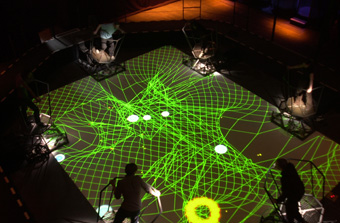
Time’s Up, Graviton
Artists whose practice includes works that are interactive have begun exploring the audience experience by investigating the extent to which their works engage an audience in an interesting and satisfying ‘conversation’ with the work’s content through the details of its sensing and responsive character. This notion of engagement is similar to the notion of immersion, though without the connotation of floating in some private pool of virtual space or information.
The Engage symposium at University of Technology Sydney provided a venue for artists whose works incorporate interactivity, to focus their attention on questions of how well interactive works achieve their aims and how that can be measured. The symposium followed two interwoven lines: the discussion of works that are engaging in their interactive behaviour and the discussion of methods for discovering what it is about these works and the audience’s experience that makes them engaging. Thus interactive art has developed two contexts: one as art in which the nature of the experience, the content, the intentions and discussion that the artist wants to bring to attention become the issue; and the other as science, where the study of the interactive mechanisms and their capacity to entice involvement or engagement lead toward a theory of effective design. This scientific interest in the character of engagement itself involves two further stages: the mapping of gestural and other audience behaviours into the processing systems that lie behind interactive art installations, and measuring the success with which that mapping is handled so that the person participating in the installation becomes engaged with the work.
Overall the question becomes: how do artists make interactive works that people enjoy engaging with, given that, as Mike Stubbs (media artist and Exhibitions Program Manager, ACMI) argued, engagement is more interesting when it is not simply a function of some technical characteristic of the particular devices being used, but is primarily content oriented.
Participation implies a relinquishing of curatorial and artistic control. British curator Beryl Graham illustrated this with Rafael Lozano Hemmer’s installation Body Movies: Relational Architecture 6 (Rotterdam, 2001). This was a large-scale public light-projection work in which people interact through differences in the scale of their shadows on the walls of a building. It is the spontaneous interaction of the audience that makes the work effective. Tim Boykett, of the Austrian group Time’s Up, spoke about how they approached this problem in their installation, Hyperfitness Studio, in which they present the audience with intuitive interfaces utilising the metaphor of the fitness and sporting facility. The audience are put in the position of “proto-scientist” and have to make sense of what they find and, Boykett observed, they appear to enjoy having to experiment in order to make the connections.
Our engagement with the work also comes through being represented within it, and the more so when in intriguing and mysterious ways. As Kathy Cleland (writer, curator, lecturer, University of Sydney) noted in referring to several early video installation works (fortuitously available in the Centre Pompidou collection currently at the MCA and soon at ACMI), we do enjoy seeing ourselves in the artwork, especially when one’s image appears to be acting in ways that are quite contrary to one’s current behaviour. This is something that also arises in more recent work such as Alex Davies’ Dislocations, where virtual characters irrupt into the viewing space causing a curious dissonance within the audience’s experience. Davies’ paper subsequently revealed some of the technicalities of these illusions.
Mari Velonaki looked at another aspect of the projected personality within the installation. In her work, including her Fish-Bird’s roboticised wheelchairs we enter a “conversation” with characters who respond, often quite obliquely, to our presence thus drawing us in as participants. In Velonaki’s installations the technology is hidden, producing an illusionistic space similar to the cinema, allowing the suspension of disbelief and easing identification, but this illusion and the potential engagement can be easily broken if the projected personality responds in baffling ways.
Other problems that disrupt the illusion are more technical. For example, Nick Mariette has been exploring the Audio Nomad system (based on work by Nigel Helyer). Sound is superimposed on objects in the gallery or public space and the question becomes how well the received sound relate to the visual sites upon which it is superimposed; ie how good is the tracking and the sound rendering for source position fidelity. Here the science enters; Mariette is involved in experimental work in psychoacoustics within virtual sound environments.
With the many ways in which the audience’s presence within an installation and their responses to it can modulate its behaviour, a new kind of aura becomes attached to interactive art, of behavioural presence which, if there is going to be any kind of engagement, asks that the installation be able to actually sense aspects of the audience’s behaviour. Conversation being two-way, not only does the installation need information about its interlocutor but also that person needs to be having an experience that makes it clear that the installation has some knowledge of their presence. This leads to the investigation and evaluation of the user’s experience.
Ultimately the question must be: is the experience effective, interesting, stimulating, exciting, provocative and thus engaging? This is largely a qualitative inquiry using the methods of cognitive science. These mostly comprise various forms of post-experience interviews, often videotaped for subsequent analysis, building up categories of behaviours and personal impressions that bring out the audience’s actions, perceptions, circumstances and reflections on the experience. Some work on analysing recordings of the audience’s actual behaviour is also done.
One of the more interesting situations in which the investigation of interactive art is occurring is Beta_space, a dedicated interactive venue jointly established by the Creativity and Cognition Studios (CCS) group at the museum. Beta_space is an environment where artists can evaluate new interactive artworks using these observational and interview procedures with audience members who are willing to describe their experiences in the artwork. It also provides a context in which researchers can test and evaluate protocols for exploring user experience for use in the refinement of design processes (RT76).
There is an underlying question of what it is exactly that new media art sees itself as doing. Obviously this varies from artist to artist. Is it making new subjectivities, increasing curiosity by providing questions or conundrums for people to investigate, exploring and critiquing new technologies, offering mysteries and moments of wonder that can come from spending time with a work and engaging with it? Is it exploringour relationship to technology with a view to developing new interactive technologies for media use in general? Or are the interactive arts to be reduced to some sort of bread and circuses entertainment? We must remain aware of this potential and lift ourselves out of it into a more politically and socially cognisant activity where the exploration is of ideas and the stimulus is more than just momentary. As Lyndal Jones pointed out, it is not “interactivity per se that is important but [the] generation of meaning through the work…Furthermore…the resulting work needs to have creative and/or social impact.” This is the sort of engagement that I seek.
Engage: Interaction, Art & Audience Experience, a symposium presented by the UTS Creativity and Cognition Studios (CCS), ACID ( Australasian CRC for Interaction Design) and ANAT (Australian Network for Art & Technology); University of Technology Sydney, Nov 27-29, 2006
RealTime issue #77 Feb-March 2007 pg. 32
© Stephen Jones; for permission to reproduce apply to realtime@realtimearts.net
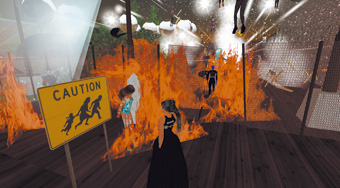
Second Life, photo Lythe Witte (Christy Dena)
THIS SCREEN SHOT IS OF A SITE-SPECIFIC PERFORMANCE HELD IN THE ONLINE VIRTUAL WORLD SECOND LIFE (SL).
The event was the opening of an installation by SL resident JC Fremont, an artist and academic who goes by the name John Craig Freeman in real life. In Imaging Place SL: US/Mexico Border, Fremont explores the notion of political and artistic borders with a two-part installation that includes a large border fence. Second Front (www.slfront.blogspot.com), apparently the first dedicated performance art group in SL, were commissioned by Ars Virtua Gallery (www.arsvirtua.com) curator Rubaiyat Shatner to create a performance for the opening held January 5, 2007. Second Front actors, attired as virtual helicopters and inspectors, cast all the guests at the opening as illegal immigrants and proceeded to interrogate and harass them. The drama escalated when Second Front showered the border with barricades and set the place on fire—some people in power think the only solution to dealing with border crossers is to blow them up. CD
RealTime issue #77 Feb-March 2007 pg. 29
© Christy Dena; for permission to reproduce apply to realtime@realtimearts.net
KURT VONNEGUT ONCE HYPOTHESIZED A HOLOCAUST IN WHICH THE CHEMICAL BONDS OF THE WORLD’S WATER SUPPLY PERMANENTLY FUSED FOLLOWING THE ACCIDENTAL RELEASE OF A LETHAL CHEMICAL REFERRED TO AS ICE-9. THE WRITER USED THE CATALYTIC PROPERTIES OF THE CHEMICAL AND THE FLUID DYNAMICS OF WATER TO CONVEY A SENSE OF THE INTERCONNECTEDNESS OF SYSTEMS.
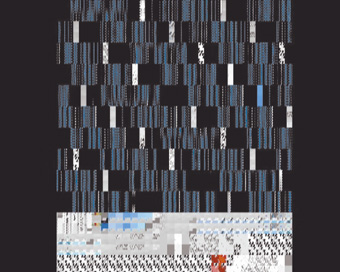
Tracey Cornish, Glitch
An ostensibly discrete puddle becomes infected with the chemical and connects with the muck and ooze of the surrounding swamp, breaking out into deltas, rivers, oceans and clouds, and permeating the cell walls of almost every living thing on the planet.
This notion of complex interactions has been adroitly summarised by American sociologist and philosopher Theodore Nelson:
Intertwingularity is not generally acknowledged; people keep pretending they can make things deeply hierarchical, categorizable and sequential when they can’t. Everything is deeply intertwingled.
Intertwingularity at the EAF is an exhibition of computer-generated moving images created by Tracy Cornish, emerging from her doctoral research into generative photography and the non-linearity of complex systems. She refers to these works as found objects, artefacts that have arisen from computer translation errors and source glitches whilst encoding prior works.
Emission Glitches is a shifting mosaic of colour-soaked pixels, the result of a coding error whilst the artitst was putting together a moving image called Glowing Emissions. Glitches perforate the vacuum seal separating different kinds of media reality. There is a place between the gestalt of recognising a familiar pattern or code and relating it to the next in which the mind freefalls before finding something to hold onto, measure, record and customise. Watching the shuffling patterns in this work, it is tempting to want to lock down its content into something recognisable: as if this elusive pattern is simply the poor transmission of a known television program. Buddhist philosophy has for centuries recognised the benefit of placing the logical part of the mind into suspended animation. Zen koans such as the well travelled ‘sound of one hand clapping’ pose questions that are unanswerable and often circular in nature, generating experiences that would remain inaccessible via logical or sequential thinking. Cornish refers to complexity in her thesis as information containing more than one form of representation simultaneously, citing the ambiguous rabbit-duck illustration (first noted by the American psychologist Joseph Jastrow) as an example of how perception is a result of cognition, not simply an index of external stimulus.
The slip of gears between recorded stimulus and awareness is present in another of Cornish’s glitch pieces, Encoding Patterns. This sequence is the result of a slightly more complicated process involving the transposition of a photograph into sound using synthetic software. Accessible as an open-source application, this “visual prosthesis” software is used by the visually impaired as a means of accessing web content. Fundamentally, it operates by converting images into frequencies. The ensuing artefact is a waterfall of graphic striations with the odd hint of something familiar, such as road or a mirage of elongated people. This warp and weft of glitchy abstractions emits an aura of compression and absence simultaneously. Watching the cascade of information on screen is like watching the back of a scrolling tapestry, or a machine dreaming from the vantage point of its root directory.
The same software used to generate Encoding Patterns was also used to produce the exhibition’s soundscape, Sound Glitching. Cornish used the vision software to sample images from this sequence at a rate of one frame per second, converting these captured stills into sound files and arranging them into an accompanying score. It is uncanny how such procedures always seem to emulate a kind of neurological synesthesia.
Machine translation—whether as an interlocution between human languages, or software packages—exposes the difference between computational complexity and true Artificial Intelligence, which computer science is a long way from achieving. A toaster may be programmed with enough complexity to accommodate different tastes, but it will be a long time before machines understand that burnt toast tastes bad.
The works in Intertwingularity succeed collectively as an entry point into generative artforms and emerging media theory. However they are still at an experimental stage and not quite ready to support their own weight without an adjoining thesis. Technology sophisticates are much more likely to enjoy a richer aesthetic response to this work than viewers who know nothing about machine complexity. Of course as machine interfaces evolve to increasingly mirror human complexity, research into the cognitive and aesthetic experience of such interfaces becomes progressively more relevant.
Tracy Cornish, Interwingularity Experimental Art Foundation, Adelaide, Oct 6-Nov 4, 2006
RealTime issue #77 Feb-March 2007 pg. 33
© Samara Mitchell; for permission to reproduce apply to realtime@realtimearts.net

On perspective and motion (part 2) 2006, Daniel Crooks
IN A MEDIA CULTURE SATURATED WITH VISUAL SORCERY, IT IS NO MEAN FEAT THAT THE TIME SLICE PRACTICE OF DANIEL CROOKS CONTINUES TO ASTOUND. COMMISSIONED FOR THE BIENNIAL ANNE LANDA AWARD, ON PERSPECTIVE AND MOTION (PART 2) IS NO EXCEPTION, PUSHING THIS EXPLORATION TO A NEW LEVEL OF LYRICISM.
Distributed across seven screens Crooks has captured (with seven cameras) a series of continuous 180 degree pans in Sydney’s Martin Place on a weekday. He has then disrupted the time line, oscillating between moments before and after themselves, morphing and stuttering between them. This humble description doesn’t begin to convey the intricacy of the work. The mesmerising result is a city folding, reversing, expanding and contracting on itself with perfect fluidity; a city in which pedestrians slip, slide and undulate in a sensuous dance of the everyday.
Over 23 minutes there are four sequences in which different qualities of movement and space are explored. In one sequence the pedestrians glide through the city: a woman floats across the road, the interlude between strides lengthened so that for brief moments she defies gravity, bringing to mind Laurie Anderson’s “walking and falling”; a businessman’s legs taper and elongate out behind him so that he becomes half man, half skateboard. In another sequence, pedestrian movements ripple: a woman with a strident arm-swing appears to moonwalk across the space, while other figures’ legs precede and follow them, like Balla’s dog. People appear from nowhere, emerging from invisible seams, splitting in two and scuttling off, while others walk towards themselves, disappearing on contact. Another section concentrates on the place itself, the buildings mirrored, extending beyond their limits to form liquid architecture; accelarating, the phenomenon spreads virally across the seven screens yielding a vast smear of stone and glass. In yet another sequence that seems slower than the rest, the figures are stationary, snap frozen like elongated cut-outs, as slices of the city bustle around them.
In his exploration of a form he has developed for almost a decade, Daniel Crooks has constantly impressed with his meticulousness. As there is never a uniform ‘apply all’ approach, it seems the artist has personally touched and manipulated each figure, each object, each background. This provides endless perplexing anomalies—why is the flower stall now over there? How is that man walking away on screen one, towards me on screen three, while staring at me from the distance on screen seven? Are those feet pointing forwards and backwards simultaneously?
Like many of Crooks’ works On perspective and motion is accompanied by a subtle yet effective score. The soundtrack of a modern city is emulated by tuned drones peppered with shuffles, squeaks, train noises and sirens. Understated, the half-heard familiar sound sources and insistent hum seep into consciousness, heightening the meditative and melancholy tone of the work.
People-watching in Martin Place is fascinating at the best of times. Here Crooks creates an environment of infinite curiosity and urban poetry. The manipulation of physical rhythms creates an elaborate choreography, revealing relationships within the crowds. The multiplication of individuals, splitting, meeting, deleting themselves, playing out past, present and future simultaneously creates powerful resonances. Amongst the dancing figures are delicate portraits suspended in time: a girl, still as death amidst the mêlée, staring straight at the camera; a family of four holding hands on the curb waiting to cross the road; a shoeshine man whose sign reads “helping myself, not begging.”
Crooks’ manipulation of time and spatial orientation within the fast-paced landscape opens a space for contemplation, and reveals the fragility of the anonymous individuals who make up a crowd. Playing with immutable laws of time and space in almost god-like fashion, Daniel Crooks offers us the opportunity to see ourselves from not just a different angle, but from another dimension.
Along with Daniel Crooks, the Anne Landa finalists were Philip Brophy, James Lynch, Monika Tichacek, Tony Schwensen, Grant Stevens and Daniel von Sturmer. Tichacek’s The Shadowers won the award.
Daniel Crooks, On perspective and motion (part 2), Anne Landa Award, Art Gallery of New South Wales, Nov 16, 2006 – Feb 11, 2007
RealTime issue #77 Feb-March 2007 pg. 33
© Gail Priest; for permission to reproduce apply to realtime@realtimearts.net
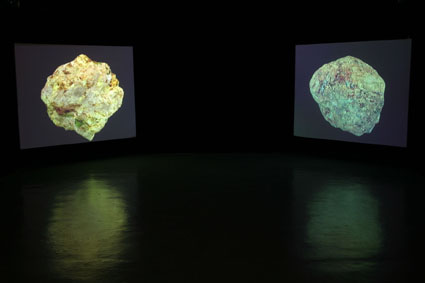
Anthony Gross, From Here to Eternity II, Computer animation installation, UK, 2002 – present
-+-(negative plus negative), is a contemplative, sometimes gently disorienting experience, a tautly curated exhibition (Gridthiya Gaweewong), modest in scale but richly suggestive, comprising works by Thai and Thailand-based British artists. It quietly embraces the domestic–a trio of large Bangkok family portraits vibrate in “the 'in-between' space of photography and animation”; the urban–a 3-screen “healing space [offers] refuge from the pressures of everyday life”; the political–roped monitors loop tense border crossing images; the cosmic–3D animated meteorites tumble and disintegrate; and the metaphysical–a projected, rotating mandala critiques the foolishness that brings on economic crises.
The sense of in-betweenness is pervasive in -+-(negative plus negative), sometimes triggering the curious dialectic suggested by the title, sometimes evoking suspension (and MAAP's gravity theme) both literally and metaphorically, and generating a reflective unease, a reminder that borders are not just lines to be crossed but states where being is denied or can evaporate.
In Wit Pinkanchanapan's Family Portrait (2002; see Virginia Baxter, “The pause that refreshes”) the father hoses his hand in the garden. It's a still-life video with a little movement, a kind of involuntary vibration of body and globules of suspended water. There's an odd sense of vulnerability. In the next portrait, in a moment of control and anticipation, the mother in traditional dress holds up a treat for 3 large, eager dogs as high as her waist. The third portrait is of a young woman in a domestic storeroom holding a large blue plastic box labelled “PA Supply.” The only subject to look at the camera, she smiles, moving the box ever so slightly up and down, suggesting both the weight of the task and her strength. Apparently she is not 'family.' The son is the portraitist. This woman is a maid, presumably with all the connotations of that role in South-East Asia in terms of labour, migration and exploitation, and the status of the servant as part of the family, or not. The vibration of minimal and repeated action in this trio of images reads like a capture for a time capsule, a quivering trace of middle class Thai life in the early 21st century.
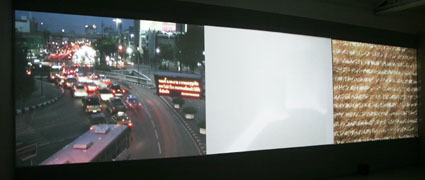
Kamol Phaosavasdi, Techno Temple, Video Installation, Thailand, 2004
Kamol Phaosavasdi's Techno Temple is also an experience of stasis and movement, but here the dynamic is of sustained stillness and sweeping flow rather than the minutiae of vibration. The image on the central screen is grey and white, flaring, still. The gallery text says it's a real time image of a room. The image to the left is of a busy intersection in the passage between light and dark, traffic moving in stop-start flows, the predictability of the rhythm exaggerated by running the camera slow so that the patterning is accelerated. Rather than the image inducing infamous Bangkok traffic anxiety, its effect is painterly and calming. The vehicles gather before the stoplights, neat and still before rushing away, merging and dissolving into long brush-like streaks of colour, a river of abstracted traffic, and from the other direction comes a transcendent flood of headlights. The accompanying sound score, among other things, is of the flow of water, a chorus of birds and perhaps temple chanting and bells in an otherworldly sonic constellation. Techno Temple is just like the refuge offered by real temples in the midst of busy Asian cities, where noise seems to be backgrounded or banished. The third screen displays a sandy surface over which screen-deep layers of words scroll left to right, rippling in and out of view as they pass over slight ridges. No explanation of their meaning is at hand, but their constant, gentle flow suggests again meditative reflection as part of a cumulative, 3-screen image of urban life, language and domestic space viewed from an easeful distance and transformed into ethereal forms.
In a long, darkened space, 2 meteorites in From Here to Eternity II, by British artist Anthony Gross, appear one at a time on separate screens angled slightly towards each other. As one meteorite forms suddenly from a small cluster of tiny stars and rolls through space, the other on the second screen becomes transparent, flares with colour and explodes, and the cycle starts up again. In each appearance the shape of the large meteorite is the same, but it is the colour and texture of the surface which fascinates as it changes cycle to cycle, from a crusty white, to grey, to orange flecked with reds, looking sometimes precious, sometimes hot, snakeskin-like, sometimes stark, icy and threatening. The 'Eternity' evoked here is of endless creation and destruction, a sameness relieved by the beauties of the transformations allowed by colour and form. From Here to Eternity is a novel (and subsequently a famous film) by James Jones about tensions of race, class and sex within the American forces in World War II. Gross' vision offers no narrative and no such specificity, just a series of not big but small beautiful bangs. The overarching rhythm of the turning meteorites punctuated by explosions and the dance of stars prior to re-creation places us again in the in-between, in a visual mantra of the acceptance of cycle and change.
In the 16-minute video loop installation A Song for No Man, Jim Prevett & McArthur (the aggregate name of just one artist) hangs one video monitor from the ceiling with thick rope, tying it to another placed facing it on a chair. On the hung monitor a man hangs in space, we see him from the waist down, jerking about, the result of editing but uncomfortably like watching a hanging. He is suspended over a road that leads to a border control station. People cross the border on a sunny day, officers go about their tasks, while the hanged man is ignored, stuck in-between, between nation states, between life and death. On the second monitor, people wait in transit in what looks like an airport customs control section. A veiled woman stands by her luggage trolleys interminably waiting, but suddenly 2 men wheel them away for her. The soundtrack grumbles with slowed down voices, the dark murmur of authority. Here people seem to pass through the in-between of borders, but slowly. The light of one image, the darkness of the other, the tortuous fixity of the first and the underworld gloom but fluidity of the second play out a grim dynamic.
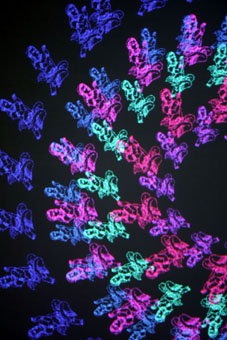
Sakarin Krue-on, Circle of Hope, Single-screen video, 5-min loop, Thailand, 2003
Sakarin Krue-on's Circle of Hope is a 5 minute video loop in which the image of Nang Gwag, the goddess of prosperity (whose image graces the entrances of many a Thai shopfront) is multiplied many times over in low definition, forming a large rotating circle within which concentric circles multiply, expand and contract, pushing the largest circle out, the whole pulsing with ever-changing lurid colours–pinks, blues, greens, yellows in many permutations against a black background. This mobile mandala is like a giant transparent jellyfish, rippling with colour, swelling and compacting as it moves through deep dark waters. And perhaps it's as toxic as a jellyfish: the gallery text says that the artist's target is the lure of prosperity that creates national economic crises. Seductively beautiful in itself, Circle of Hope is an ironic, mesmeric meditation on prosperity, portraying desire as a living thing. The in-between suggested by this work resides in the disjunction between the beauty of the image and the false hope it conjures.
-+-(negative plus negative) is a satisfying and well deployed gathering of works in which border states are experienced not just as content, whether political, moral or psychological, but in vibrations, pulsing and flows, a visual musicality that links all the works in their very different evocations of in-between states.
-+-(negative plus negative), curator Gridthiya Gaweewong, Project 304, Chiangmai, Thailand; organised by Earl Lu Gallery, LASALLE-SIA College of the Arts and MAAP; MAAP in Singapore-GRAVITY, Oct 7-31
RealTime issue #77 Feb-March 2007 pg.
© Keith Gallasch; for permission to reproduce apply to realtime@realtimearts.net
AT LONG LAST, DVDS OF CONTEMPORARY PERFORMANCE AND INTERVIEWS AND DOCUMENTARIES ABOUT OR WITH THEIR MAKERS FROM THE LAST 50 YEARS ARE BECOMING AVAILABLE TO DEVOTEES OF ART THAT CHALLENGES AND INSPIRES AS IT TURNS YOU UPSIDE DOWN AND SOMETIMES INSIDE OUT. ON THE DOWNSIDE, THE DVDS ARE EXPENSIVE COMPARED WITH FEATURE FILM AND DOCUMENTARY RELEASES AND NOT ALWAYS EASY TO ACCESS. THEY EMANATE FROM SMALL-SCALE PRODUCERS AND DISTRIBUTORS IN BERLIN, NEW YORK, TOKYO, and ALSO FREMANTLE WHERE AUSTRALIA’S CONTEMPORARY ARTS MEDIA HAS A LARGE CATALOGUE RANGING FROM GROTOWSKI TO JENNY KEMP AND FORCED ENTERTAINMENT. REALTIME WILL REVIEW NEW DVDS AS THEY BECOME AVAILABLE.
Foreman Planet
Interview with Richard Foreman
Director Kriszta Doczy
DVD, 2004, recorded 2003, 75 mins
Private $65; Schools $AUS200; Tertiary education $AUS250
Plus GST, packaging and post
Contemporary Arts Media
www.hushvideos.com
Foreman Planet is a 75-minute documentary DVD on the life and work of Richard Foreman—10 time OBIE award winning writer, director, designer and founder of his own influential Ontological Hysteric Theater, in New York.
“Consciousness… spiritual consciousness… to know the unknowable other…” is what Richard Foreman describes as the foundation and ultimate subject of his life and work. His is an investigation of the unconscious that is outside of culture and conditioning which is part of the world that we can understand. To achieve this his theatre attempts to dismantle all “reference points.”
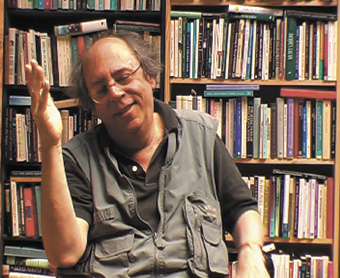
Richard Foreman, Foreman Planet
Foreman equates his own investigations with what he calls a “negative theology,” which is to know God or the Other by knowing everything that is not God or the Other. His two roles of writer and director encapsulate this binary—as director he embodies the ego and performance of being in the world, while the writer remains in the realm of the unconscious. Foreman states that his talent is for “sensing this underlying, unattainable, continual eruption of new things from different directions that are constantly colliding… sensing a rhythm… sensing a responsiveness.” Finally, concerning both the language of his theatre and the language of the world, Foreman articulates that language is, for him, “a statement that is as if dropped to the bottom of a well, where its statement hits, and reverberates…” The language of his theatre attempts to deal with such reverberation.
The style and presentation of this DVD document—and the nature of the questions from interviewer Kriszta Doczy—amounts to more an introduction to the man and a little of his work than an in-depth study. Foreman describes in detail his creative impulses, defines his methodologies and talks about psychic freedom, realism, objects and influences. The sun slowly fades from afternoon to evening as Foreman sits talking in his New York loft. The high quality of Paula Court’s photographs of his productions give the DVD an elegance otherwise lacking. Sadly, for whatever reason, no filmed examples of his work are shown.
In response to the interviewer’s somewhat basic questions, Foreman’s discourses (sometimes rants) are full of linguistic colour and energy. The questions are often used as section titles, giving the DVD the feeling of an educational aid rather than an imaginative response to Foreman’s work. Nevertheless this DVD is a very valuable introduction to the thinking if not the work of an important American contemporary artist.
Max Lyandvert
John Cage Performs James Joyce
Takahiko Iimura
DVD, 2005, recorded 1985, 15 mins, B&W
Private $US100; institutions $US400
www.takaiimura.com/home.html
Taka Iimura is a senior figure among contemporary Japanese artists and has been working with film, sound and video since the 1960s. He was one of several Japanese who, coming from a 20th century tradition of avant-garde intervention, contributed to the Fluxus (NYC) group in the 60s. As a senior figure (1912-1992), active experimentally since the late 30s, John Cage is the subject of a video portrait shot by Iimura in 1985, released in 1991 and made available on DVD in 2005.
Like many media artists, Iimura made recordings of contemporaries and their work. Alongside his making of artworks, portable video enabled documentation (and general note making) more economically than film. As the cycle of experimentation moves through another generation, glimpses of precursors through archive recordings of this kind help ground artists’ surviving words and artworks.
Cage had a long-standing fascination with the work of James Joyce, Finnegans Wake, forming the basis of many works, the best known of which is the Roaratorio—an Irish Circus on Finnegans Wake. Commissioned by German radio and IRCAM in Paris the sound recording was completed in 1979, lasted about an hour and was a 62 track mix of the sounds referred to in the text, the text itself as prepared (using a mesostic system) and read by Cage, together with music by the traditional Irish musicians of the day.
Roaratorio is one of the classics of Cage’s oeuvre and in Iimura’s 15 minute recording Cage presents the core of the spoken part of the work. Its composition, like many of his other works, is aided by the I-Ching. Here he briefly explains that none of the sentences (sic) in Finnegans Wake are selected, only words, syllables and letters from different pages according to the chance decisions made by consulting the I-Ching and its representational hexigrams. In this way the 624 pages of the book are compressed into 12 pages of text, and it is one of these pages that we see him holding. He reads from it, sings it, then hustling close to the camera and its microphone, whispers it. At the bottom of the screen are superimposed, each time, two lines of sub-titling synchronised with the text he is using.
Iimura’s presence is felt but not seen, though we hear him responding to Cage’s explanations at the outset. Cage’s voice is not strong (he is in his seventies) and we strain to hear him against the noise of New York traffic in the background coming through the window of a sunlit room. His demeanour remains buoyant, at one point making light of a fumble he makes with a watch he is holding, an event incorporated into the flow of the tape. Like so many of his initiatives, the line between the artwork and its making is blurred, a state aided and amplified by Iimura’s collaboration in its making.
Mike Leggett
This review first appeared in Leonardo Vol 40, No 1, 2007.
Fluxus Replayed
Takahiko Iimura
DVD, 2005, recorded1991, 30 mins, B&W
Private $US100; institutions $US400
www.takaiimura.com/home.html
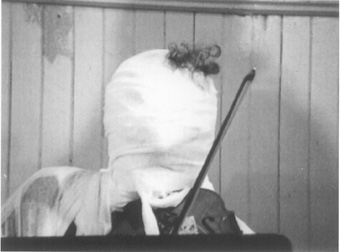
oko Ono, Skypiece for Jesus Christ (1965)
In Fluxus Replayed, Taka Iimura documents an event in 1991 held to reproduce historical performances by NYC-based Fluxus artists of the 1960s. The S.E.M Ensemble together with some of the Fluxus artists themselves, perform works by Nam June Paik, Yoko Ono, Dick Higgins, George Brecht, Allison Knowles, Ben Patterson, Jackson Mac Low and Emett Williams. Iimura has edited together the sounds and images captured by two cameras as raw evidence of the goings-on with scant regard for the conventions of continuity editing, thus maintaining the document in the space between the moment of recording and that of viewing. Time compression is only obvious in Ono’s SkyPiece for Jesus Christ (1965) as the baroque instrumental ensemble are wound around with white paper, accumulated as a series of jump cuts to the point where their music is reduced to a series of bumps and scrapes before being man-handled off the stage, still attached to their chairs and instruments.
Again, Iimura gives some idea to younger generations of how these early precursors to contemporary performance art appeared to audiences, in a setting typical of the genre—church hall ecclesiastical architecture, painted walls, wooden floor. Though much of this work was sound-based, produced collaboratively for group performance using chance determinations and framed with a sense of the aesthetics of noise, the written scores or instructions for each piece may well have satisfied many members of the audience. Glimpsed in the background, some walking around, others squirming in their seats, the probably overlong evening has been bravely foreshortened into a useful 30-minute document by the man with the video camera.
Mike Leggett
This review first appeared in Leonardo Vol 40, No 1, 2007.
RealTime issue #77 Feb-March 2007 pg. 48
© Max Lyandvert & Mike Leggett; for permission to reproduce apply to realtime@realtimearts.net
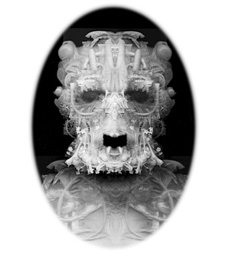
Murray McKeich, pzombie
From pre-cinema visual entertainments to the first Second Life performance art group, RealTime 77 celebrates media arts, a far-reaching field of not always screen-based and increasingly interactive works that are fast disappearing old meanings of ‘audience’, to create an arts experience that is insistently more immersive and mobile, and arts users who mutate into active participants. The new media arts domain of the Australian media arts field, although still vigorously infecting all forms and practices with its innovations, has been battered in recent years by the ill winds of artform envy, category debates, funding losses, reduction in institutional support and a consequent lessening of visibility. The ‘new’ has been struck off the new media arts label, leaving us with a looser, less troublesome, if often meaningless moniker. And yet, while some new media artists have fallen by the way, overwhelmed by costs, scared off by funding detours or exhausted by the sheer duration of working technology into form, many Australian artists and media arts organisations keep doggedly at it, as this edition of RealTime extensively illustrates. Media arts as a totality looks healthy—the history of alternative cinema is being re-explored and old devices and techniques reactivated and refashioned; video art continues to make the most of its second coming: and multimedia performance is thriving. In general, media arts (if not net art, wearables, mobiles, interactives, sound art) are ever more present in art galleries even if often problematically placed and resourced. While not a survey, our media arts feature is indicative nonetheless of the extent and the continuing inventiveness of media arts, old and new.
image: Murray McKeich, pzombie, see page 26
RealTime issue #77 Feb-March 2007 pg. 1
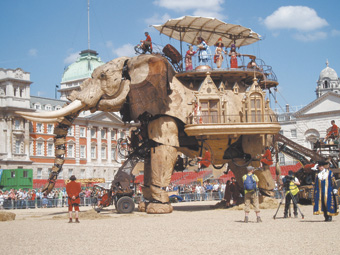
The Sultan’s Elephant, Royale de Luxe
photo Susana Paiva
The Sultan’s Elephant, Royale de Luxe
EARLY IN 2006, WE MET LIFT (LONDON INTERNATIONAL FESTIVAL OF THEATRE) DIRECTOR ANGHARAD WYNNE-JONES ON AN ICY DAY, APPROPRIATELY OVER A WELSH RAREBIT IN A CAFÉ NEAR THE LIFT OFFICE IN LONDON’S EAST. WYNNE-JONES HAS BEEN BUSY REVITALISING THE 25-YEAR-OLD FESTIVAL, RADICALLY INTENSIFYING ITS LONG-TERM LOCAL AND INTERNATIONAL FOCUS. HER ENTHUSIASM FOR THE 2008 FESTIVAL AND THE VALUES UNDERPINNING IT ARE CONTAGIOUS, HER LANGUAGE PEPPERED WITH TERMS THAT SUGGEST VISIONARY, EVEN REVOLUTIONARY ZEAL AND A REAL SENSE OF QUEST. MORE RECENTLY, IN AN EXCHANGE OF EMAILS, SHE REPORTED ON THE VISION’S REALISATION, AND CHALLENGES, TO DATE.
Wynne-Jones came to Australia as an artist. In 1994 she appeared on the cover of the very first edition of RealTime as the new director of Performance Space. During her time here she staged memorable site-specific works (like Hydrofictions) on Sydney Harbour and was part of Peter Sellars’ team for the 2000 Adelaide Festival until she left to become a mother. Despite that festival’s practical problems it’s clear that Wynne-Jones continues to be inspired by Sellars’ vision as well as the one she inherited from Lift’s founders Lucy Neal and Rose Fenton, but is doing it in her own intensively collaborative way. Lift in 2008 will be created by a large team of “Seekers”—artists and artworkers from London and the world along with representatives from around the UK and East London communities in particular.
Lift’s collaborative model is intended to engender a wider public participation where those attending become something more than an audience, and instead create a festival that is about more than art, to ensure that art is doubly valued. To enable this, Lift is creating as the hub of its festival a New Parliament.
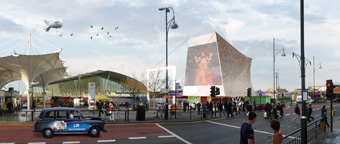
The Lift New Parliament as it might look in Stratford, East London
image AOC
The Lift New Parliament as it might look in Stratford, East London
lift new parliament
Lift has run a major architectural competition for a design for its New Parliament with a brief for a mobile structure that can hold hundreds of people and be used for performances, forums and broadcasting. The aim, says Wynne-Jones, is to place the structure near centres of power, like the British Parliament in London, where its very presence will say, “art is important.” And it can travel the country and the world. Designed by architectural practice AOC with engineers Momentum and Mark Prizeman, its “flexible membrane structure taking the archetypal form of a tent as its starting point”, the winning submission was selected by a jury from four anonymous short-listed designs (out of 56 entries) that were put to the public to have their say in an online vote. Wynne-Jones has written, “At the heart of this vision is…a new concept in performance space, where artists from around the world and the people of London can gather together to share stories, exchange knowledge, and imagine and rehearse new futures.”
constituency
Lift combines the local (East London), the national (via the tourable New Parliament), and the global (the Seekers). Long-term Lift staffer Tony Fagan is coordinating the involvement of East London communities, while the Seekers consult with their own. The Seekers met in London in May 2006 and will meet again in March this year as well as consulting online. The ultimate goal, says Wynne-Jones, is “to have Lift owned by the community by the 2012 London Olympics.”
On the local front, Lift is engaging with local boroughs and their “regenerative agendas.” To do that, says Wynne-Jones, the organisation “has had to learn the language: it was an artificial hoop to have to jump through.” Clearly, having to deal with local government and to seek funds beyond the Arts Council of England (Lift’s principal funder) is a major challenge. When we met, Wynne-Jones was by no means certain that Lift could achieve the financial goals that it had set itself. But, she said, “regeneration is vital for these communities: it is urgently needed or disaster lies ahead.”
Similarly Wynne-Jones sees it as vital that artists face the challenges of their world. Lift’s role, she says emphatically, is “to create context, to move closer to the things we fear…and to have a voice.” The New Parliament will provide a place for that voice, and hopefully its realisation will encourage potential sponsors to give, but also to enter the parliament themselves.
seekers
Asked about the choice of the term ‘Seekers’ for Lift’s collaborators Wynne-Jones explained that it “came from a desire to get away from overly academic associations with the term ‘curator’ in the visual arts world and the product oriented ‘programmer’ in performance. I have read Harry Potter, but it wasn’t a direct crib, I promise.” However, she reveals, “‘New Parliament’ is proving very unpopular with all the collaborators in East London, testament to disappointment with New Labour and indicative of voter disengagement—in the UK you don’t have to vote, so most people don’t. When the parliament does open it may well be called something else. But whatever it’s called—suggestions welcome—it will be a physical embodiment and tangible experience of peoples’ desire and capacity to engage with each other, with theatre—in its broadest sense—and with the things that matter to us most, locally and globally.”
taking it to the streets
To light the flame of its vision, Lift collaborated on a large scale public theatre event for four days in May 2006, a visit to London by The Sultan’s Elephant, a massive human-operated pachyderm created by Frances’ Royale de Luxe mechanical marionette street theatre company. Lift involved primary and secondary school students, young and emerging artists in the event, contributing objects, letters, drawings and photographs about their particular part of London or the UK. These then travel with the elephant around the world. The event also included a day of conversation, “How many elephants does it take…?”, at the South Bank Centre to explore how creative people and city infrastructures can collaborate to change the way the city is experienced.
For Wynne-Jones the estimated million people who turned out to see the elephant confirmed the need for a new public space. At the time she said: “Almost a year on from the bombings of July 7 2005, the people of London came together to celebrate and share an experience, eager to interact with each other and to be in a public space together. We saw a different London and were filled with a great sense of ownership which enabled a generosity between us. The sheer joy and enthusiasm with which the elephant [was] greeted suggests a tremendous need for a space that allows us this freedom to come together more often. One of those spaces is the Lift New Parliament.”
seekers meet
Wynne-Jones said that the meeting of the Seekers happened at the same time as the visit of The Sultan’s Elephant: “We wanted them to experience London at its most animated…We left our intense discussion many times to participate in this reclamation of the city by its citizens.” At this meeting, “the Seekers heard from us about the proposed Lift New Parliament…Inevitably we talked about money and risk. Participation is at the heart of the process and we invited the Seekers to share their experience and understanding of participative work from their very different contexts and asked if audiences can be turned into or should be participants.
“Much of the discussion centred on how individual and collective identity is constructed, how relevant that was to us now, how much of it was constructed from our individual and national histories. Questions arose to do with whether there is a sense of identity that is common to all, irrespective of context or geography. In our dreamings of the space of the Lift New Parliament as a place of cultural equity we talked about what might need to be given up, what needed to be held onto, what protocols we might establish, whether we needed a constitution.
“The Seekers spoke of their understanding of their role and how they inhabited it….They range from artists, initiators and creators to prospectors, prophets, transformers and revolutionaries to messengers and catalysts. Simply put, we got to know each other.”
next
Asked about the stages leading to Lift 2008, Wynne-Jones explains it will entail further testing of the Lift vision and the first presentations towards programming. “We begin our next meeting in March 2007 with a gathering of the Seekers along with politicians, scientists, cultural commentators and academic theorists to think about the context that we are operating in and the potential for change. Exploring the question ‘How do we live?’, we’ll use Open Space Technology (www.openspaceworld.org), a self organizing meeting and discussion tool which we hope will become one of the meeting protocols within the Lift New Parliament, to make visible the landscape we are operating in and unearth its spiritual and philosophical underpinnings as a prelude to the Seekers’ presentation of the projects they have selected.
“By the time the Seekers leave seven days later we will have a fabulous palette of proposals from existing work, new commissions and linking events between the international work and UK-made work. These will have been discussed with the programmers from our partner venues. What remains is for Lift to raise the funds to produce and present the work. The production process begins in the Autumn of 2007, with a 10-month run up to the festival and the launch of the Lift New Parliament.”
opening parliament
Wynne-Jones is programming “a number of trailblazer events leading up to the opening. These will be created by international artists in collaboration with communities and are indicative of the kind of projects we imagine will happen in and around the Lift New Parliament. In Eat London, a collaboration with Spanish artist Alicia Rios and 300 community members will create a giant three dimensional city made entirely out of food to be eaten on one glorious day by London’s citizens. Auckland’s dance company Mau, will stage Requiem [originally commissioned by Peter Sellars for the New Crowned Hope Festival in Vienna in 2006 to mark the 250th anniversary of Mozart’s birth] at the South Bank Centre, and Stan’s Café from Birmingham will create the largest artwork made of rice in the world [the company appeared in the 2006 Melbourne International Arts Festival], in which every living person is represented by one grain.
“The festival, with the Lift New Parliament as its heartbeat throughout June 2008, will begin in Stratford [East London] in collaboration with our partners. The parliament will then be packed up and transported along the river by boat and travel to the South Bank Centre. Alongside the commissioned program within the Parliament itself, there will be debates, celebrations and an exchange of ideas through a whole range of mediums, between international artists, local residents, cultural commentators, politicians and local, national and international audiences. That’s not forgetting singing, dancing, eating, and generally having fun!
“The final design for the parliament will go public in June this year and then it will take a year to tender and build it, test and open it!”
Lift’s Seekers
Caroline Calburn, theatre artist, Cape Town, South Africa; Jeremy Deller, artist, curator, London, UK; Ishrat Nishat, theatre artist and critic, Dhaka, Bangladesh; Oby Obyerodhyambo, playwright, director and writer, Nairobi, Kenya; Jonathan Parsons, director Brisbane’s Riverfestival, Australia; Roma Patel, interactive media and theatre artist, Nottingham; Menno Plukker, theatre , dance and festival producer, Montreal, Canada; Lemi Ponifasio, theatre artist, artistic director of MAU, Auckland, New Zealand; Dawn Reid, theatre director, London; Fabio Santos, teacher, choreographer, arts project coordinator, London; Jenny Sealey, multisensory theatre artist in disability arts, London; Subathra Subramaniam, dancer-choreographer and biologist, London; Lone Twin—Gregg Whelan and Gary Winters, writer-performers, directors, Brighton and Glasgow; Prasad Vanarase, theatre artist, Pune, India; Wen Hui, choreographer, Beijing, China.
Lift, www.liftfest.org.uk
RealTime issue #77 Feb-March 2007 pg. 2
© Keith Gallasch & Virginia Baxter; for permission to reproduce apply to realtime@realtimearts.net
SPILL, A NEW INTERNATIONAL PERFORMANCE FESTIVAL IS SOON TO PREMIERE IN LONDON. IT’S THE BRAINCHILD OF ROBERT PACITTI OF THE PACITTI COMPANY, AN EXPERIMENTAL THEATRE COMPANY BASED IN EAST LONDON AND WELL KNOWN FOR ITS WORK IN EUROPE. THE AIM IS TO IMPROVE THE LOT OF PERFORMANCE IN THE UK, TO CHALLENGE LONDON THEATRICAL CONSERVATISM AND GENERATE INTERNATIONAL EXCHANGE.
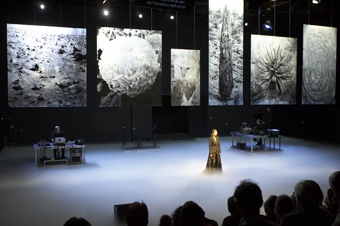
Francoise Berlanger, Penthesilea
photo Thierry Monasse
Francoise Berlanger, Penthesilea
Pacitti was one of the mentors in the very first Time_Place_Space hybrid performance laboratory held in Australia on 2002. At a meeting in London in February 2006 and then in a recent email exchange we asked Pacitti to detail his motivation for such a large undertaking as SPILL.
“SPILL is very much an artist led initiative”, he writes. “The festival has grown out of my increasing frustration that our own work and that of many peers, whilst remaining very successful overseas, still struggles to be seen and taken seriously in the UK. There are many complicated—and alas, dim-witted—reasons why radical or ideas based work is a tougher beast to place here than more traditional forms, but few of them are actually to do with what audiences seem to want. So I knew I had to do something to force change, but I also knew I would fail in that if I just tried to better my own situation. Therefore SPILL is absolutely about the company being in service to a larger context, and the implications of that are truly international.”
In the UK there’s an incredible variety of forms of contemporary performance and fluidity between the categories of live art, performance art and experimental and new theatre. SPILL exemplifies the range and diversity of practices, juxtaposing, for example, Forced Entertainment, Raimund Hoghe, Kira O’Reilly, Francoise Berlanger, Hancock and Kelly, and the Pacitti Company.
For all this plenitude, however, Pacitti describes London as being without a focal point for contemporary performance: “London really lacks any ongoing high profile, properly resourced platform for performance. The city likes to ‘big itself up’ as a wild theatre capital, but in reality it still exists within very safe territory. This is clearly evident in the current plethora of site-specific work being made by younger artists who seemingly lack any desire to present content. It’s as if the civil rights movements never happened. So to that end SPILL is deliberately a programme of volatile work shown for incendiary ends.”
grand collaboration
Invited companies and individual artists will not only appear in SPILL in their own works but will collaborate with Pacitti Company in Finale, a work based on Emile Zola’s 1867 novel, Therese Raquin. Pacitti writes that many of them already have a collaborative history of some kind with his company. Finale was originally designed for the company when touring to challenge the notion of what it means to be a visiting artist. “We do this by running a two-week workshop for up to 30 local practitioners around issues of manifestos and explicit bodies, and the local artists then become performers in the piece, presenting their own workshop material integrated with our existing images. It’s crucial that everybody has equity though, and this is always the tricky bit. It’s a risky model for us as we never know quite what we’re going to get, but it means that each performance is a unique event that starts to unpack issues around what it means to host and what the status is of the visiting artist in relation to home-grown talent.”
Now Finale will be played out on Pacitti Company’s home ground: “In SPILL we are addressing a politic of international reciprocity by inviting artists from Brazil, Belgium, France and Australia who have been through this process before, to show their own practices and then work collectively with us as an international group to end the festival with Grand Finale. It’s a new model for us, and feels very political.” Grande Finale will be accompanied by the Swiss cult electronica band, Velma.
the program: scope
SPILL includes more than 50 performances over three weeks, a two-day international symposium on sustainable models for experimental practice; a weekly banquet for audiences to sit down informally and eat with artists; a program of feature films each accompanied by contemporary performance shorts; and “a series of ‘hidden’ messages around the city, accessed only via bluetooth broadcasts and SMS.” Venues include the Barbican, the South Bank Centre and the Soho Theatre.
In London’s vast Shunt Vaults below London Bridge (where the young performance company Shunt work) SPILL will collaborate with the Live Art Development Agency on an exhibition, Future Classic, of documentation of performance activity lineages from across the visual arts, dance, civil rights movements, clubland and film. “Future Classic is a participatory exhibition that will run throughout the festival. Onto a wall map placed deep within the Shunt Vaults audiences are invited to submit key influences that they feel are important to the development of contemporary performance praxis. Over the festival period these influences will accumulate to become a new collective map charting the activities of people and times that have somehow forced change, and in doing so become pivotal to the furtherance of performance making—either deliberately or otherwise.”
the program: artists
Forced Entertainment will present their magical saga of unfinished tales, And On The Thousandth Night (seen at the 2004 Adelaide Festival), and Exquisite Pain, their performance adaptation of the Sophie Calle work (see RT 78 for a report from Christine Evans on that performance and Quizoola by the company at the PuSh festival in Vancouver and also The World in Pictures, in Dublin).
Brazil’s Andre Masseno, a dancer, actor, choreographer, costume designer and stage director, will present his solo work I’m Not Here or The Dying Swan, a dance dialogue with Fokine’s 1907 choreographic piece for Anna Pavlova. Brussels based artist Eve Bonneau interrogates her own nudity in live performance with video in Body is the First Word I Say, her practice focusing on the body as organism: “The passage of experience from the body into the performance, of an organic world becoming a social body.”
Another Belgian artist, originally from Algeria, Francoise Berlanger bases her Penthesilea on the Heinrich Von Kleist version, producing “a work about the shock of falling in love, and the subsequent violence of loss.” Working with her visual artist brother Marcel, two sound artists, and a scenographer, Francoise Berlanger “plunges us into the cruel and haunted consciousness of a woman at war with herself as her flesh and her mind falter with fatal effects. Half-woman, half-animal, the stage is her abyss.”
In Tattoo, Traci Kelly will her have her back tattooed in the pattern of wallpaper from co-performer Richard Hancock’s childhood home. The work by these UK artists is described as “a slow archaeology…The tattoo will form a permanent exhibit; a visceral exchange of memories from one body to another.” The compelling Kira O’Reilly will present a new performance, a SPILL commission, which will doubtless be as beautiful and disturbing as previous works where she’s inscribed on her body with fine blades. Live art practitioner and long-term Pacitti Company member Sheila Ghelani will explore cultural and other hybridities in Covet me, Care for me , about “dissemination, about ‘upping the value of the mongrel’, about rejoicing in cross fertilization…”
Julia Bardsley (UK) will present one part of her Trans:Acts, “an accident at the cross-roads between video and live presence—a smash up at the intersection of performance and the script—a director and actress splayed across the dissecting table, waiting for the understudy to walk on and corpse—a last supper for an audience of twelve intimates.” The complete trilogy was presented at the National Review of Live Art in Glasgow, February 2005, and the TROUBLE Festival, Brussels in November 2005.
The engagingly idiosnycratic Raimund Hoghe (Germany), former dramaturg to Pina Bausch and solo performer (2003 Melbourne International Arts Festival, RT 58, p6) will appear in Sacre—The Rites of Spring with Belgian performer Lorenzo De Brabandere, responding to the Stravinsky score with “a new, contemporary and minimalist interpretation of the ballet classic: an initiation ritual for two men.”
As well as orchestrating Grand Finale, Pacitti Company will show its video installation, Three Duets, in which Pacitti performs in duets about self, sexual identity and age with Sheila Ghelani, Juliet Robson and octogenarian Angela Rodaway. The company will also present Civil, a significant moment in Pacitti’s personal history as an artist. It is rare for performance works to be presented by anyone other than their maker. Now Pacitti is to pass on one of his best known works about his encounter with Quentin Crisp in New York in 1996 and focused on issues of disobedience and civil rights, to a younger performer, Richard Eton.
Last, but not least, emerging Australian performance company Unreasonable Adults (RT76, p25) will present Last To See Them Alive, a solo performance by Carolyn Daish to a text by Fiona Sprott with direction and sound by Jason Sweeney. In RealTime 75 (p46), Sprott detailed the workshop gestation of the piece, from which has come “a series of monologues which propose a ‘character’ of a single girl and her relationship to a serial killer, distorting the traditional romantic fantasy portrayed in romance fiction to ask: ‘How do you meet Mr Right in an age of Serial Killers?’“
With the LIFT festivals now well in the past and the new Lift moving in a very different direction (p2-4), doubtless SPILL has the potential to satisfy the urgent needs Pacitti has identified. Lke LIFT before it, SPILL may find everyday arts competition in London a considerable challenge. However, the sensible scale of the festival, a strong program and an audience Pacitti believes is ready for challenging work, could create in SPILL the performance platform he yearns for as an ongoing entity.
SPILL, Festival of Performance, London, April 2-22, www.spillfestival.com
RealTime issue #77 Feb-March 2007 pg. 6
© RealTime ; for permission to reproduce apply to realtime@realtimearts.net
IN THE 2007 SYDNEY FESTIVAL WE ENJOYED AN UNUSUALLY LARGE NUMBER OF CHALLENGING AND DEEPLY SATISFYING WORKS FROM ARTISTS NOT AFRAID TO THINK BIG, EVEN IN SMALL WORKS.
Time, not merely as content (reflections, memories, forgettings, prophecies) but as form (temporal distortions and suspensions), figured frequently as we engaged with the traps of human intimacy and technological ingenuity, death and a welter of separation anxieties and fears about our future.
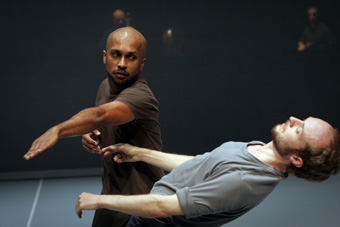
Akram Khan, Sidi Larbi Cherkaoui, Zero Degrees
photo Trent O’Donnell
Akram Khan, Sidi Larbi Cherkaoui, Zero Degrees
Akram Khan, Sidi Larbi Cherkaoui: zero degrees
Two men walk downstage, sit and address us lucidly in absolute unison of voice, gesture and mood. We see and hear them as one. In several episodes across the performance they tell us a first person story about travelling through India. There’s a border crossing, the man’s passport taken away briefly by the authorities unleashing fear and humiliation, followed by suspicion he may have overreacted. In a later episode, an old male train passenger dies and the subject of the story is advised not to help the screaming wife with the body, lest he be implicated in the death—“That’s the way it is in India.” After each telling a sustained movement passage unfolds, triggered by the idiosyncratic dance language of one of performers, the other following suit in his own way. However, as the metaphysical angst intensifies, the single being splits, each man turning to a humanoid dummy (created by sculptor Antony Gormley) which he manipulates, like a child, to fondle and assault him, to substitute for an absent other, or to use like a voodoo doll. Sidi Larbi Cherkaoui kicks the dummy and Akram Khan’s body convulses.
The story-telling becomes ragged, desperate and single-voiced, the dancing and its evasions more driven until the symbiosis exhausts the pair, one of them seemingly destroyed and carried offstage by the survivor. Zero Degrees is an intense drama of separation anxiety, of the push and pull of like but different bodies and cultures. The dance moves from intimate entwinement of intricate hand and arm patterning (perhaps stemming from Khan’s Kathak tradition and the vocabulary Cherkaoui has developed from everyday gesture) to rapid dervish twirling, to Kahn’s synthesis of Indian and contemporary Western dance and Cherkaoui’s elegant fusion of yoga, break-dance, martial arts and North African dance. These are displayed and shared. They trigger the music which is integral to them rather than the other way round, but the music stands on its own when Cherkaoui sings an exquisitely sad song.
In his program notes, Akram Khan writes about the way bodies are never truly still—breathing is constant and in death the body actively decomposes: zero degrees he defines as the point between life and death, stillness and movement, between merging and separation. Zero Degrees expresses all the pain and beauty of such a notion, with an almost insurmountable sense of loss at the piece’s end compounded by Nitin Sawhney’s elegiac composition for violin and cello. There’s no catharsis here, simply a meditative state sustained long after the performance’s conclusion.
batsheva dance company: telophaza
A company of some 40 dancers suggests all kinds of possibilities. By and large what we are delivered is a mass of movement and colour, the company intermittently breaking into very brief solos and mutliple duets and predominantly left to right waves of dancers crossing the stage. The effect was often of an abstracted chorus line, emphasised by uniform if multifariously coloured unitards. The look of the show is postmodern multimedia, the dancers’ faces initially looming large over the stage on four screens from cameras they themselves manipulate. The one memorable scene has a female dancer upstage directing a camera in extreme close-up to the foot on which her body balances and contorts but also offering a rear view of other dancers entering the space. We see the curl of the toes, the flexing of the foot, the sense of bones, then two feet working together accompanied by a thunderous, cracking soundtrack. A dance party scene with four cameras facing in as the dancers circle and take turns at soloing to a soaring rock guitar promises more point of view pleasures but rewards us with none and some indifferent dancing. In a strange ending, two members of company are caught naked upstage on camera, faces and hands in intimate contact. Another dancer steps her way across the stage lined with chairs while the male dancer from the coupling cavorts wildly around the stage to some ineffectual strobing as if to suggest that suddenly out of the mass of anonymity that the show has largely represented there has been some indecent personal moment or sleazy surveillance of it. Overall there was always something to look at in Telophaza but in terms of surveillance and the desiring gaze this was always a show in which as a last resort there was always someone to look at if never for long enough. The rule of thumb seems to be that the bigger the dance company the more limited and cliched the relationship with technology.
the holy body tattoo: our brief eternity
After an aural prelude taken from the soundtrack of Blade Runner (“Have you ever retired a human by mistake?”), Our Brief Eternity opens (and later closes) with the projected words “Somehow, continue…”, and the company cites Marshall McLuhan in their program notes—“The new integral electronic culture creates a crisis of identity, a vacuum of the self which generates tremendous violence.” You know where you are, but it doesn’t prepare you for the ear blistering steam-hissing industrial punk or the vision of compulsive machinic bodies in an ultra disciplined type of moshing and with a constant sense of impending mayhem. The dance is a kind of punk minimalism delivered by three dancers first working from flat out on the floor with rigorous single handstands and rapid rolling. Later they stand, pumping as if hydraulically driven. Rare moments of intimacy look more like manipulation and threat. The three bodies perform identical movements, often with one slipping in and out of pattern—no room for error. A film of the company dancing the same work (premiered in 2006 at the Los Angeles Center for Digital Arts) acts like a kind of mirror, but the relationship between stage and screen is not dynamic. Movement and text suggest a world on the edge of apocalypse or, more likely, rapid entropy, the latter evident not only in the choreography but in the weariness of the real dancing bodies and a certain sameness after a while. How much more can you say about the machinic body? Interesting nonetheless.
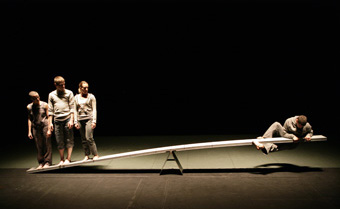
Lucy Guerin Inc, Structure and Sadness
photo Jeff Busby
Lucy Guerin Inc, Structure and Sadness
lucy guerin inc: structure and sadness
Midway through Structure and Sadness, Lucy Guerin does something very bold and it unleashes great emotion. Having created an abstract world of construction and its tensions in both the bodies of her dancers and in the creation they have just finished building, she suddenly literalises it. A woman in black listens to the radio as she washes dishes at an imagined sink. She sings along to a pop song, Crimson and Clover, which switches between tinny radio sound and full amplification, as if we are moving in and out of her head. Behind her, two other women also in black set up a wailing chorus to the song while balanced on a pliant bridge. The music is interrupted by a news broadcast and women and audience are plunged into the facticity of the 1970 collapse of Melbourne’s Westgate Bridge. Pop becomes a grieving cry, the long black dresses evoke the funereal dress of many cultures (and in the look and movement not a little of the potency of a Martha Graham dance drama). The woman sways, nearly falling, the male dancers in grey, heads hanging low, appear as if among the dead (35 men were killed). The dead weight of the men literally bears down on the women.
Structure and Sadness concludes with a long, consoling, almost courtly dance between the dead and the living, commencing palm to palm in a movement motif we’ve seen from almost the beginning of the work, in a duet where bodies test each other for weight, tension and pliability. In the first part the dancers move on to build a structure from tiny components and then larger and larger ones—into a veritable house of cards. They also balance unevenly on a large seesawing plank under which a living body lies, as if testing for endurance. This image returns in the show’s coda: four of the dancers become inert bodies with the plank laid across them. Another dancer crosses pushing down on those below, reminding us that this bridge rests on the bodies of the dead.
Structure and Sadness is a major Australian dance work (certainly punching at greater weight than its “About an Hour” festival programming) with the courage to think big and ambitiously about work, death and the traps of human ingenuity. The totality of its choreographic and theatrical vision encompasses adventurous design by Bluebottle and media (Michaela French) built into the very body of the work, the dancers, and a musical score that works through and with tension, building on the twang and buzz of wires stretched and relaxed, distorted and at the end resolving to a comforting lyrical guitar played nevertheless over a fast still twanging pulse. Perhaps there’s room for some tightening of the work in the first half and perhaps a closer view is needed for the audience of the initially small work of the dancers as they build, but Structure and Sadness deserves a long and successful life with its frank countenancing of death and grieving.
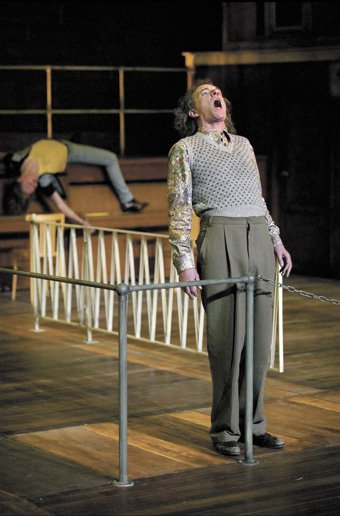
Graham Valentine, Seemanslieder
photo Phile Deprez
Graham Valentine, Seemanslieder
zthollandia/ntgent: seemanslieder
In his appreciation of the work of Christoph Marthaler, the great Swiss theatre and opera director, Benedict Andrews wrote in RealTime 76 about how “his theatre slows time to a standstill”, creating “ a time between. A time of waiting, of remaindered thoughts, leftover people and once forgotten songs.” Seemanslieder, performed by Belgium-based NTGent and ZTHollandia in a Belgian-Dutch collaboration, epitomised the Marthaler vision.
Time, space and personality are all mutable in this world; songs, narrative fragments and monologues evoking very different periods and attitudes to the sea in a small coastal community over hundreds of years. Tales of fishing, pirating, executions, drownings and yearnings, preaching and drunkenness (especially drunkenness), wives and mothers at home, men at sea, sons in fear of it, drift out into the auditorium from a stage populated by strange characters, familiar yet alien, like the drowned rising up to speak, so much of their business unfinished, wounds still open, lives drifting, memories floating, free associating, coming to the surface. There are also curious inversions—a woman sings an erotic song of seduction to another woman, a song a sailor longing for a woman would sing. Anna Viebrock and her fellow designers’ set looks totally lived in, replete with ceiling, incredibly solid, very real but oddly transcendent, phasing between terminus, ship’s deck, bar and the deep as men flip like fish across its floor. The timber wall at the back looks like an ageing dock or an old hulk from which a pipe pumps bilge.
In this floating world, amplifying the sense of it ghostliness, time frequently slows for song, solos and sotto voice choral works, folk songs, torch songs and lieder gloriously acquitted. Eruptions of farcical action intrude, sight gags out of burlesque, silly but relentlessy persistent—pratfalls, toupee jokes, a clever routine of being swept along by an umbrella in a windstorm. Sometimes the two modes merge: in a haunting rendition of a song from Ravel’s Sheherazade suite sung close to silent by the company, the drum kit player (in an unlikely accompaniment to glorious piano playing) crawls across the floor playing his sticks against it (this kind of crawling and rolling and crabbing one of the show’s swimming motifs), while a sailor taps out the beat on his rubber boot. The company all sing beautifully, their faces expressing reverie, indifference, boredom. One way or another the songs possess them.
Characterisations only slowly accumulate as you get to know these people, their quirks and obsessions like the tall Scot who looks like he’s about to sexually assault a woman (“I want…I want…I want!”) only to be rejected or assaulted in turn and then thank her for her company before disappearing into his room. Later, he surprises us with a long, grotesquely beautiful rendition of “Lowlands”, his wanting now illuminated in a very different way.
Despite death’s insistent presence in tales and songs, the universe of Seemanslieder is essentlally comic, and like most comedy rooted in hysteria and melancholia, a reminder of Marthaler’s Le Coq training. The ship’s barmaid, for example, is a kind of dramaturgical glue, serving the drinks, keeping the customers in order until she herself has too much, loses her shoes and, struggling to slip into them without using her hands, reveals herself to be quite a contortionist; her agony has all the pathos, obsessiveness and vulnerability of a drunk. This is the comedy of recurrent accidents, helpless compulsion and incapacity, which always require skill to play, everything predicated on the worst possible chain of cause and effect. It’s a world of farce—of two toilet doors through which people constantly disappear, get trapped, vomit into or or use to conceal shipboard liaisons. And of slapstick. Or the surreal—the useless bicycle that descends from above. It’s the comedy of escape from pain through alcohol or morose religiosity in hymns that pray for Jesus’ unlikely succour.
Compared with Marthaler’s Stunde Null (London International Festival of Theatre, 1997), the director’s grimly comic account of the conversion of Nazis into democratic politicians, and the only other work of his we’ve seen, Seemanslieder is a delirious reverie, an adroit cut and paste of the songs, tales and anxieties of European sea-going cultures of other times and no time in particular into an absorbing totality with its own sad comic logic.
gate theatre beckett season
In Beckett’s Eh Joe, Charles Dance (substituting for Michael Gambon) in dressing gown in a small dim room, closes the curtains over windows, cupboard and door and sits in profile to the audience. His face appears, gigantic and slowly growing, on the scrim between us, every detail of his face writ large as a female voice begins its litany of accusations—in his head, or filtering through the floorboards, in the air between us. Dance distributes the changes in his expression sparely, initially with glowering intensity and then a weakening into vulnerability as the truth, or whatever it is it, hits home and a tear falls at the end of the half hour performance. If Krapp worries at his own earlier recorded and often forgotten utterances, at least the voice is his own. Joe is like a man haunted and rendered speechless, or is the voice his own ventriloquism, the only way he can admit his doubts and crimes? Directed by Atom Egoyan, the screen device with its double view of Dance, apart and face-to-face with us, worked strongly both emotionally and as an easily accommodated theatre-cinema hybrid.
By contrast, Ralph Fienne’s performance of the novella First Love adapted for the stage was a pretty straightforward piece of telling, but I’ll Go On with Barry McGovern, a master Beckett performer, was a venture for actor and audience deep into the writer’s concerns about life, death and especially language. The selections (made with Beckett’s approval) ranged from passages of relatively broad situational humour from Molloy and Malone Dies to The Unnameable’s nightmare of our entrapment by words—never quite any speaker’s own and here delivered at terrifying pace, the essential poetry of the prose awesomely intact. In the earlier, garrulous excerpts McGovern is garbed in long black coat he reveals to be lined with The Times, while in The Unnameable he is almost naked, laid out it would seem in a mortuary.
The Beckett series was, of course, a festival hit, even though no substantial master work was included, rather an adaptation, selections and the eerie Eh Joe, and some notable star actors. Three short works on separate nights, although I’ll Go On was relatively more generous. Luxury theatre. Since the Beckett film series associated with The Gate (out of which Egoyan’s Eh Joe came) and the centenary of 2006, and perhaps something to do with the nature of the times (there was a noticeably high turnout of politicians), Beckett has regained an audience. But this series was more than a sideshow for a missing main event: Dance was courageous and subtle and McGovern’s performance was a revelatory reminder of the powerhouse that Beckett is: inherently theatrical, deeply Irish and with a glorious love-hate passion for the word.
maly drama theatre of st petersburg: uncle vanya
The Sydney audience, still bubbling with post Christmas and New Year cheer, had some difficulty settling down to this almost exhausting dose of Russian ennui. The actors play it and live it for what it is, and in very real time. Characters are just as likely to think before they speak as erupt into action. Entrances can be languorous, characters placing themselves precisely across the large stage or in small tight clusters before engaging, or moving almost farcically fast through the many doors that frame the low-walled set. As with Venia himself, so Chekov’s Uncle Vanya requires patience, which is richly rewarded.
One of the greatest pleasures of this Uncle Vanya was to be able to hear it in Russian (as it was too with the guttural, watery western-European languages of Seemanslieder), read the surtitles (good ones and the pace mostly manageable) and not infrequently register subtleties of interpretation (if still behind the Russians in the audience). To see Chekhov spoken in Russian is a double pleasure, witnessing words delivered from time to time with large gestures and intense facial expressions that yet never yielded to melodrama. There are likewise surprising moments of physical intimacy: Elena and her husband professor at odds but entwined. This heightened sense of familiarity and intimacy makes the potential for tragedy all the more felt, and the acuity of Chekhov’s quietly comic vision of lives desiring but resisting change all the more sad. As director Lev Dodin, in Sydney with his company, has argued, for all their sense of loss, failure and ennui, the characters “take up the struggle for life with vigour….here everyone wants to live.” As much as they complain, they still make a go of looking for love or, like the doctor, to saving a depleted, neglected environment. In this respect the play’s observations about feminism, environmentalism and the challenges of rural life feel contemporary in a production that, unusually for the Maly Theatre, is conventionally presented.
However, as well as the careful choreographing of the action (‘blocking’ cannot do it justice), there are aspects of the production that subtly counter the traditional costuming. Suspended over the stage on a metal grid are three huge haystacks (“chasing dreams while the hay rots”). In the last scene of the play as Vanya and Sonya work at their desks, having committed to the farm forever, the stacks are slowly lowered around them. Elsewhere a single set of french windows provides a motif for temporary relief and escape, rain pouring down them and, when opened, releasing a very loud post shower plip plop which underscores the action like a demented metronome for a very long time. The playing too was fascinating in its blend of understatement and passion, sometimes declarative—delivered to the audience without overtly acknowledging our presence—sometimes interior, always intimate and at its best in the socially uncomfortable Vanya (Sergey Kuryshev)—obsessed, distracted, out of kilter.
meryl tankard & taikoz: kaidan, a ghost story
Kaidan is a work of great beauty if little else. It is exhaustingly Japanese in style, from the story to its music (by Ian Cleworth for Taikoz, Riley Lee on shakuhachi) and its kabuki and bunraku influenced staging and movement. Looking like a fashion cross between Sofia Coppola’s Marie Antoinette and an upper class Japanese matron, a woman (a perfectly cast Sarah-Jane Howard) rids herself of a mirror not realising that it’s tantamount to throwing out her soul, with dire consequences for herself and her community. The storyline is fuzzy in the $8 program, if you bothered to get one, and even less tangible on stage. What begins with a narrative flourish or two becomes increasingly opaque.
Regis Lansac’s projections commence with a widescreen black and white misty riverside scene through which we glimpse the woman’s ghost (before she takes sudden flight in one of the show’s aerial routines) and progress through a series of exquisite, richy coloured natural images of ever changing proportions, presented Rorschach-style. In themselves these are beautiful but in the end add to a superfluity of effect. The treatment of the woman as a bunraku puppet lacks the precision of the original form (and of Theatre du Soleil’s Flood Drummers), nor is it a sustained device. The woman’s final mad dance is well executed by Howard with the requisite passion, but as elsewhere the choreography seems indeterminate.
circa: the space between
The Space Between is an exquisite physical theatre miniature focused on a series of mutating physical relationships in duos and trios with occasional solos. Bodies tangle, wrestle, caress and mutually manipulate each other well beyond the range of normal touch, but tell us much about ourselves. The show is built on close observation and fine detail and not on spectacle, comedy or sex or even conventional routines. The gravity that has to be overcome in this physical theatre is the weight of human dependency and the desire to intensify or to escape it. Every possible permutation of entanglement is entered into and every ounce of concentration is devoted to keeping that relationship balanced—always a tense, tentative affair but the drive is to do it again and again. Circa don’t rush, they enter these states slowly therefore often face more tortuous demands than usual on muscles and the sense of balance. This stress reaches a critical intensity in a late scene where all three bodies clamber up and over each other in a fluid knotting and unknotting of arms and legs.
While occasionally scenes appear perfunctory or oddly placed, and the musical selection is taxingly various (a through-composed score please!), The Space Between is a work which often demands and rewards careful attention, revealing how little real, unoccupied space there is between human bodies.
adt: devolution
Never act with children or animals. You could be tempted to add ‘or dance with robots’ after seeing Devolution. But somehow the fascinating anthropomorphic machines that so demand our attention here share a world with the humans they, and likewise we, watch with curiosity, and who are, in Devolution’s most alarming scene, becoming like them. The first bodies we see are Gina Czarnecki’s naked human apparitions floating hugely before us on a downstage scrim, twisting and turning against each other in a fluid cluster, and then in more and more clusters. multiplying into a universe of these organisms. They then fade to the live action of Devolution—leather-clad ferals peopling the stage with furious energy in brief virtuosic turns, sudden damage free Euro-crash clashes and, most striking, a recurrent creature-like clustering—heads appearing at odd angles, limbs rippling out like tentacles. Devolution offers little of the comforts of individualism.
What we witness is an ecosystem at work where humans and machines co-exist—there’s no obvious conflict, no working relationship. If the humans here once invented these robots they certainly have no control over them now and make no such attempt. They simply occupy a space with a kind of ritualistic fervour observed by the curious machine giants who appear to scan the humans, even bend down and peer at their couplings and tusslings or, in smaller versions, scurry between them like insects.
The robots too dance, in their way: the giant ‘scanner” running on a grid above reshapes its component parts with surprising variety; a row of tall robots across the back of the space undulate with a kind of showgirl finesse; two peering giants each clomp about on their four feet; a worm-like creature unfolds from above and sways about inspecting its domain. All have bright headlight eyes, some have heads that swivel, but there are no limbs that could reach out to, touch or manipulate a human body: their evolution presumably has not required it. The humans are evolving too, into machines (or have they been unwillingly co-opted?)—with horrendous long, mechanical tendrils that whip out from chests and backs. If human and tendril appear to be one organism, the issue of agency however is never clear—which part is in control? Moreover these new humans look like dangerous loners.
In an intensely dramatic passage of near contact, robots and humans move dangerously close to each other before returning to their respective stillnesses and clusterings. How long their ecological mutualism will last is an open question—the merging has begun and the meaning of the final projected image of one cluster of humans disappearing into the distance is clear enough. Obviously, director and choreographer Garry Stewart worries that what we are setting in train with technological development is regressive, a de-evolution, a departure from what it means to be human. However, with roboticist Louis-Philippe Demers, he does it with passion, precision and an escalating inventiveness that, ironically, pushes the robot cause forward with a kind of Robocop, Terminator, Mad Max fascination. It’s a reminder, too, that the work’s form is itself somewhat regressive, looking back to older forms of sci-fi, most recently reinvigorated by the Steam Punk genre evoked here in the heavy duty industrial sound score and the wonderful hydraulics of the robots. In his choreography Stewart textures his trademark high speed dance acrobatics with quivering balletic touches, suggesting finer human things too face loss. The work will tour Europe this year.
lou reed: berlin
Except for cultists, Berlin is not an album that many people, even some Lou Reed fans, seem to know. This sell-out concert version, doubtless destined for CD and DVD, will change that. It was a joyful discovery of a grim song cycle about the decline and death of a female junkie and mother in Berlin that the 1970s found unpalatable. The spare lyrics and stark compositions that foreground Reed as performance poet narrator, the shockingly disinterested observer of disaster, still hit home, the original Bob Ezrin orchestrations updated with a pervasive minimalist pulse but always with the capacity to pull back just to the voice and a lone guitar. The remarkable Steve Hunter, who appeared on the original album, shared lead playing with a very able Reed in a strong band plus a chorus (from the Australian Youth Choir) led by Antony and Sharon Jones, and three brass and three string players, these add-ons all dressed in pastel blue and placed beneath a trademark Julian Schnabel wallpaper cut and paste and a real, suspended lounge with a single strip of white paint banded across it. Less than convincing video projections of someone playing the album’s subject mingled with the imagery. The real power of Berlin was simply in the music, performed with commitment and precision but never departing from the rawness that makes it work. It sounded a lot better to me than the original. Its frankness still shocks.
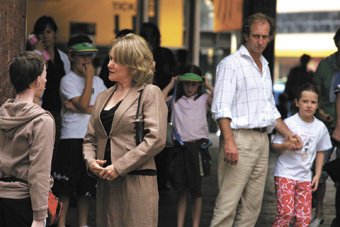
Simon Laherty & Genevieve Morris, Small Metal Objects
photo Prudence Upton
Simon Laherty & Genevieve Morris, Small Metal Objects
back to back
In the 2007 Sydney Festival Geelong’s Back to Back Theatre’s Small Metal Objects was a standout amidst standouts. Like Seemanslieder, like Structure and Sadness, Eh Joe and Uncle Vanya, Small Metal Objects took its audience into a very different time and a very different place. As with those others, the production requires a certain surrender, a giving of yourself to the time world of the subjects, here to the slow, thoughtful exchanges between two drug dealers Steve and Gary (Simon Laherty, Allan V Watt). Steve is deep in thought, paralysed with anxiety about his sexuality and his friend’s health. This state is pitched against the cajoling and panic of their bourgeois customers (Jim Russell, Genevive Morris). Other time worlds drift or hurry by as people pass or enter the Circular Quay terminal, and our head-phoned surveillance superiority makes for its own uneasy sense of displacement in this simply scripted but complexly conceived and subtly produced and finely performed work.
the big picture
Inching towards the Melbourne International Art Festival’s current pre-eminence (and likewise eschewing ballets, operas and symphonies) the 2007 Sydney Festival at last showed that it could offer more than two or three exceptional works in a program. What’s more, Sydney audiences went for it with record box office takings. And politicians past and present, mostly federal, were out in force—Whitlam, Turnbull, Coonan, Hawke, Debus and more. Let’s hope the Minister for Water made it to Seemanslieder.
A vital addition to the festival was The CarriageWorks, the new contemporary performing arts centre in Redfern which opened the festival and was in turn opened by it. Temporary seating problems aside, the venue proved remarkably attractive, the vast foyer a great meeting place. Its presence and its performance spaces also signal a great opportunity for the Sydney Festival to do what Melbourne has done ever since the Robyn Archer directorship—celebrate the art of the city, particularly Sydney’s contemporary performance and dance.
–
Les Ballets C De La B and Akram Khan Company, Zero Degrees, dancers Akram Khan, Sidi Larbi Cherkaoui, composer Nitin Sawhney, sculptor Antony Gormley, musicians Tim Blake, Coordt Linke, Faheem Mazhar, Alies Christina Sluiter, dramaturg Guy Cools; The CarriageWorks, Redfern, Sydney, Jan 5-8
Telophaza, Batsheva Dance Company; choreographer Ohad Naharin; costume design Rakefet Levi; dramaturgy, sound design Ohad Fishof, Capitol Theatre, Jan 6-10
The Holy Body Tattoo, Our Brief Eternity, choreography, concept and direction Noam Gagnon, Dana Gringas, performers Susan Elliott, Noam Gagnon, Dana Gingras, Music Jean-Yves Thériault, film direction William Morrison; Playhouse, Sydney Opera House, Jan 8-12
Lucy Guerin Inc, Structure and Sadness, choreographer Lucy Guerin, dancers Fiona Cameron, Antony Hamilton, Lina Limosani, Alisdair Macindoe, Kirstie McCracken, Byron Perry, composer Gerald Mair, motion graphics Michaela French, set and lighting design Bluebottle (Ben Cobham, Andrew Livingston); Drama Theatre, Sydney Opera House, Jan 9-12
NTGent, ZTHollandia, Seemanslieder, director Christoph Marthaler, musical dramaturgy and singing coach Christoph Homberger, design Anna Viebrock, Duri Vischoff, Frieda Schneider, costumes Sarah Schittek; Syndey Theatre, Jan 10-13
Gate Theatre Dublin, Samuel Beckett Series: First Love, director Michael Colgan, performer Ralph Fiennes; Eh Joe, director Atom Egoyan, performer Charles Dance, voice Penelope Wilton; I’ll Go On, director Colm O’Briain, performer Barry McGovern; Parade Theatre, NIDA, Jan 10-22
Maly Drama Theatre of St Petersburg, Uncle Vanya, writer Anton Chekhov, director Lev Dodin, designer David Borosky; Sydney Theatre, Jan 22-27
Kaidan, A Ghost Story, direction, choreography and design Meryl Tankard, musical direction Ian Cleworth, illuminations Regis Lansac, music Taikoz, Riley Lee; Drama Theatre, Sydney Opera House, Jan 18-27
Circa, The Space Between, direction, concept, lighting Yaron Lifschitz, performers Darcy grant, James Kingsford-Smith, Chelsea McGuffin; The Playhouse, Sydney Opera House, Jan 23-27
Australian Dance Theatre, Devolution, direction Garry Stewart, robotics Louis-Philippe Demers, projections Gina Czarnecki, costumes Georg Meyer-Wiel; CarriageWorks Bay 17, Redfern, Sydney, 24-27. See also RT72, p32
Berlin, music and lyrics Lou Reid, music producers Bob Ezrin, Hal Wilner, direction & design Julian Schnabel; State Theatre, Syndney, Jan 18-20
Back to Back Theatre, Small Metal Objects, directed and devised by Bruce Gladwin, performers Simon Laherty, Allan V Wall, Jim Russell, Genevieve Morris, sound design Hugh Covill, Customs House forecourt, Circular Quay, Sydney, Jan 8-25
2007 Sydney Festival, www.sydneyfestival.org.au
RealTime issue #77 Feb-March 2007 pg. 39
© Keith Gallasch & Virginia Baxter; for permission to reproduce apply to realtime@realtimearts.net
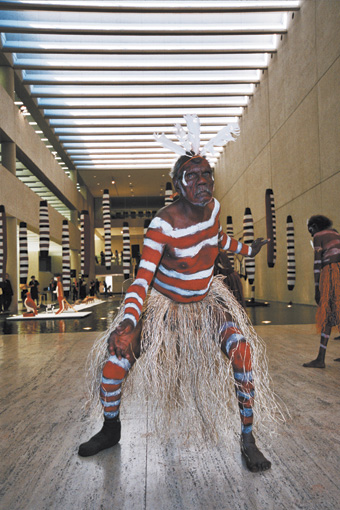
Arthur Pambegan, Jr., Aurukun Dancers
ALWAYS ONE OF AUSTRALIA’S MOST EAGERLY ANTICIPATED MAJOR VISUAL ARTS EVENTS BECAUSE OF ITS UNIQUE CULTURAL AMBIT AND THE PROFUSION OF UNFAMILIAR COLOUR, STYLE AND POLITICS THAT COME WITH IT, THE ASIA PACIFIC TRIENNIAL OF CONTEMPORARY ART (APT) WAS DOUBLY WELCOMED IN ITS FIFTH INCARNATION.
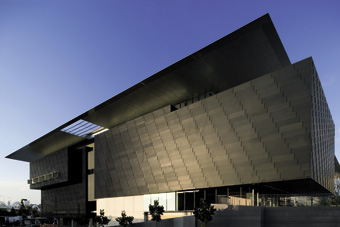
Gallery of Modern Art
The occasion for joyous and epic celebration was the opening of the magnificent five-level grand pavilion-like Gallery of Modern Art (GoMA). The superb architecture by Kerry and Lindsay Clare of Sydney firm Architectus speaks for itself with its grand halls, incredibly high ceilings, a multitude of intimate spaces, ultra-comfortable steeply raked cinemas, views within and out over the river, and a plenitude of natural light. For the artworks it is the most accommodating of Australia’s major galleries, uncluttered and offering, for example, a whole wall in APT5 to one magical work by Anish Kapoor. The wall height alone in the major spaces offers artists and curators some wonderful opportunities.
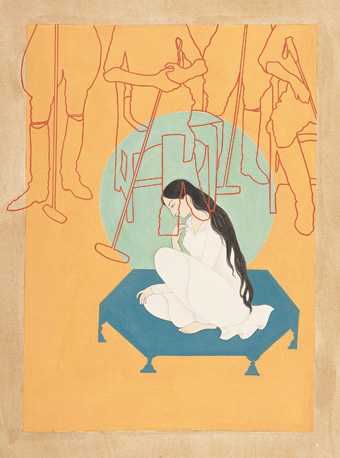
Nusra Latif Qureshi, Justified behavioural sketch 2002
It’s a mere 150-metre walk to the Queensland Art Gallery, taking you past more impressive architecture in the form of the new Queensland State Library, a facility blessed with state of the art screen and computer facilities, luxuriously furnished and very welcoming. The QAG maintains its charm with a touch of refurbishment including a new wide glass entrance facing GoMA. QAG will now focus on art up until the 1970s.
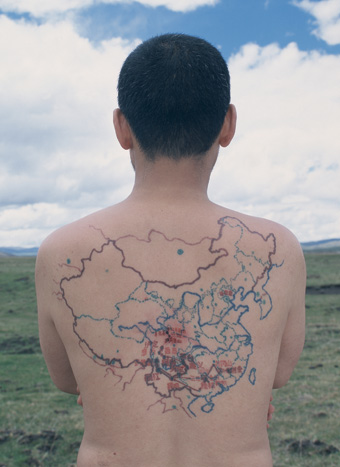
Qin Ga, The miniature long march (detail) 2002-05
courtesy The Long March Project,
Qin Ga, The miniature long march (detail) 2002-05
APT5 features 37 artists and two large scale collaborations (Long March Project, China; Pacific Textiles Project). The Long March Project is an APT5 centrepiece, a profoundly fascinating re-tracing of Mao’s 1934-5 journey undertaken by a number Chinese artists, a selection represented here, with works created at key sites (www.longmarchspace.com). Performance artist Qin Ga’s Miniature Long March was tattooed on his back as the journey unfolded. You are welcomed to the project by Wang Henhai’s two huge grey statues of Mao, side by side: Mao as Communist Party Chairman, Mao as Emperor of China. There are no illusions in the Long March project although plenty are played with. Zhou Xiaohu’s Utopian Theatre, an engrossing large scale fantasia of rallies and media surveillance with a mass of clay figurines (the artist is also an animator), sound score and video imagery evokes societies both democratic and totalitarian. There is much else to admire in the Long March Project drawing on traditional art practices with thoroughly contemporary energy and insight.
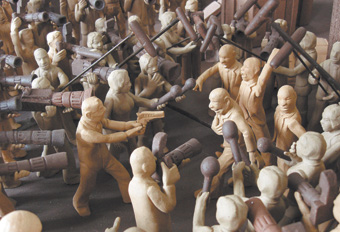
Zhou Xiaohu, Utopian theatre (detail) 2006
courtesy The Long March Project, Beijing
Zhou Xiaohu, Utopian theatre (detail) 2006
Throughout APT5 there is ample evidence of art realised through meticulous craft, delicacy and great labour from the Pacific Textile Art Project to Sangeeta Sandrasegar’s (Australia) exquisite wall-based, shadow throwing fine cut-outs of hands or her images of feet with their erotic contemporary detailing, or Nusra Latif Qureshi’s (Pakistan, lives in Melbourne) subtly ironic Mughal miniatures, Fiona Hall’s American paper money birds’ nests, Anish Kapoor’s (UK) deeply immersive wall sculpture, Justine Cooper’s eerie Saved by Science installation or Eko Nugroho’s rebellious surreal humanoids (a giant one looms over you in GoMA’s main entrance). And many more besides. APT5 is a rich visual feast with some performative elements if not quite as extensive as in previous APTs. QAG and APT have always provided well for children and APT5 is no exception.
APT5, GoMA and QAG are generous and accessible. The planning and deployment of the new building is considered and visionary, recognising the mutual needs of artists and audiences. The opening was a wonderful celebration of this. In RealTime 78 we’ll publish a full review of APT5. RT
The 5th Asia-Pacific Triennial of Contemporary Art, Queensland Art Gallery and Gallery of Modern Art, Dec 2, 2006-May 27, 2007; www.asiapacifictriennial.com
RealTime issue #77 Feb-March 2007 pg. 8
© RealTime ; for permission to reproduce apply to realtime@realtimearts.net
IN MARCH TASMANIA WILL ONCE AGAIN WELCOME ARTISTS AND COMPANIES FROM ISLANDS OF ALL SIZES AND OTHER REMOTE AND NOT SO REMOTE PLACES TO TEN DAYS ON THE ISLAND, ONE OF AUSTRALIA’S, AND THE WORLD’S, MOST IDIOSYNCRATIC ARTS FESTIVALS.
<img src="http://www.realtime.org.au/wp-content/uploads/art/2/276_kg_tendays_comp.jpg" alt="Bikini Islanders receiving gifts of chocolate
from US military personnel as a “sweetener”
to their forced evacuation in 1946, ©Smithsonian Institute;
Linda Mancini as a contestant in the “Bikini “>
Bikini Islanders receiving gifts of chocolate
from US military personnel as a “sweetener”
to their forced evacuation in 1946, ©Smithsonian Institute;
Linda Mancini as a contestant in the “Bikini
© the artist
Bikini Islanders receiving gifts of chocolate
from US military personnel as a “sweetener”
to their forced evacuation in 1946, ©Smithsonian Institute;
Linda Mancini as a contestant in the “Bikini
They’re coming from Cape Verde, Sardinia, Ireland, Newfoundland, Manhattan, New Zealand, Japan, Taiwan, Canary Islands, Denmark and the Torres Strait. Here’s a good-looking selection from the large program of acclaimed visiting works and new creations from local artists. RealTime will also be there with an intensive review writing workshop, so watch out for responses to these and other works as they go online at www.realtimearts.net.
the corn exchange, dublin by lamplight
In their first visit to Australia, this award-winning company, described as “a renegade version of Commedia dell’Arte”, present theatre magic and tough politics in the Dublin of 1904.
benjamin bagby, beowulf
In the bardic tradition, accompanying himself on six-string lyre and reciting in Old English (with Moden English surtitles), Bagby delivers a big chunk of the beautifully grim, 1000 year-old epic about the battle between a warrior and a monster.
gruppe 38, the little match girl
Denmark’s award-winning children’s theatre company perform the four-hanky children’s tale featuring three performers and innovative deployment of gadgets, projections, music and paper.
dream masons
In RealTime 72 p40, Sue Moss interviewed the makers of this new work at the first stage of their coming together. Dream Masons transforms the façade of the Salamanca Arts Centre into a theatrical spectacle in a work about survival replete with 100 Tasmanian performers, musicians, artists and technicians. Created by Jim Lasko (Chicago), Jessica Wilson (Hobart) and Joey Ruigrok Van Der Werven (Sydney).
is theatre, queen of the snakepit
Fourth generation Flinders Islander, Cheryl Wheatley performs a theatrical collage of island life in “a portrayal of longing, endurance, strength and solitude staged cabaret style in the island’s infamous ladies lounge, the Snakepit.” Deviser-performer Cheryl Wheatley, writer Finegan Kruckemeyer, director Tania Bosak, designer Greg Methé.
linda mancini, bikini
Manhattan Bessie Award-winning performance artist Linda Mancini’s one-woman play juxtaposes the destruction of the mid-Pacific Bikini Atoll by US A-bombs in 1946 with the French creation of bikini swimwear. The impact on islanders and women, respectively, is played out with slapstick and black humour.
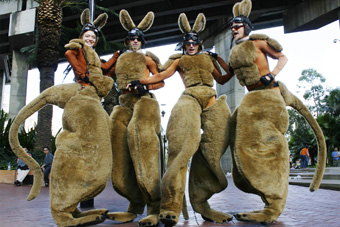
Roo’d, Icarus Performance Troupe
icarus, roo’d
Leaping two metres in a single bound, these giant kangaroos evoke at once a prehistoric Australia and a genetically engineered future, old rural toughness and urban brashness. “Always ‘Roo’d’ but never offensive”, they promise.
hsiao hsi yuan puppet theatre
For connoisseurs of traditional puppetry, in this case with its roots in the spectacle of Peking Opera, this will be a must: the puppets perform routines usually only within the abilities of the humans they mimic.
the spectre of the rose
A return season of local performer and writer Robert Jarman’s much-lauded account of the Genet autiobiographical novel directed by Franz Docherty.
back to back, small metal objects
A not-to-be-missed, never-to-be-forgotten experience from Geelong’s Back to Back played out in the street by performers and passersby in a stark tale of affection and corruption [see p39].
ihos music theatre: a thousand doors, a thousand windows
Inspired by WH Auden’s Twelve Songs, this is contemplative multimedia music theatre for soprano (Xenia Hanusiak), projections (Cazerine Barry) and a score by Constantine Koukias, staged in the beautiful early stone barn at the newly remodelled Rosny historic site.
ricky maynard, portrait of a distant land
Based on his Indigenous family background, leading Australian photographer Ricky Maynard’s new work responds to landscapes and oral histories and will appear on billboards around Tasmania.
leigh hobba: tasmanian landscapes in video and sound
Video, performance, installation and sound artist Leigh Hobba is celebrated at the Tasmanian Museum & Art Gallery in the first major survey of his work and focusing on his response to the island, 1980-2007. The exhibition includes Blues, a collaborative performance with dancer Wendy Morrow. Curator Craig Judd.
tasdance: mercy: a dance for the forgotten
In the festival’s first international co-commission, Mercy explores imprisonment and death in Tasmania’s convict past and in repressive regimes around the world. The choreography and conceptual design is by New Zealand innovator Raewyn Hill.
For more theatre, music, visual arts and special events for the mind and not least the gourmand within, go to www.tendaysontheisland.com
RealTime will be reporting each day of the festival. Go to the features section for more.
Ten Days on the Island, March 23-April 1
RealTime issue #77 Feb-March 2007 pg. 14
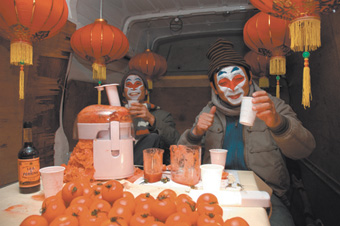
Mad for Real (Cai Yuan & JJ Xi)
photo James Champion
Mad for Real (Cai Yuan & JJ Xi)
GIVEN THE SENSATIONALIST REPORTING OF SOME OF THE MORE EXTREME EMANATIONS OF CONTEMPORARY PERFORMATIVE CHINESE ART (SUCH AS ZHU YU’S PURPORTED BANQUET OF FOETAL BODY PARTS), A FULL-SCALE FESTIVAL OF CHINESE LIVE ART CALLED VITAL ALWAYS CARRIED WITH IT THE VEILED POSSIBILITY OF AN OUTPOURING OF VISCERA AND BODILY FLUIDS. BUT IN THE EVENT, VITAL 06 AT MANCHESTER’S CHINESE ARTS CENTRE FOUND A POWERFUL PULSE WITHOUT RECOURSE TO BLOODLETTING.
Hong Kong artist Leung Po Shan set a contemplative tone in her opening durational performance, Hammering-In-Time. Illuminated by a single candle, a broken tree branch in the centre of the small studio space cast its looming shadow across the walls. In the gently flickering half-light, the diminutive figure of the artist, in a diaphanous gossamer skirt, attempted to nail down the shadow. Following the edges of the silhouette, Leung Po marked out the outline of the tree shadow in a trail of copper tacks, pursuing the shape with the aid of a ladder where the shadow crept over her head until it spilled out of reach across the ceiling.
Hour after hour, she tap-tap-tapped with a dainty hammer, the meditative rhythm interrupted only by the occasional plink of a tack slipping through her fingers to the wooden floor. Post-performance, the course of the shadow survived as a raised dotted line branching across the white walls in an installation viewable throughout the festival. The intangibility of light and shade had been temporarily translated into palpable metal. However, the broken outline hinted at the incompleteness of the picture: a metaphor for everything that is un-pin-downable in live art. From a lived moment, rich with human breath, flame-warmed in the wavering light and a room vibrating as echo dissolved into echo, all that remained was a scantly delineated after-image.
Gamine and slight-framed, with cropped hair, Leung Po also goes by the name of Anthony, thereby injecting a little gender ambiguity into her next multi-sensory performance, an intimate one-on-one interaction called Itchy Scratchy.
The pungent smell of eucalyptus and wintergreen seeps down the corridor. A glass bottle of Chinese White Flower Oil is slipped into my hand with the invitation to enter the studio and rub the embrocation into the artist’s body. Anthony Leung Po kneels naked, on a small wooden platform, staring straight ahead at the incoming visitor. The furled bloom of a white rose pokes out from her silent lips.
A mirror offers both a reflection of the artist’s slender back, and the incomer’s own awkward gaze. Feeling exceptionally ungainly and over-clothed, I drip a few drops of oil onto my palms and try to decide how and where to start anointing this boyish body. Tentative massage of a smooth brown thigh evokes an immediate response as the artist unfurls gracefully, bending to follow the touch, revealing toes tied together with red ribbon. A metronome ticks insistently by her side as a reminder of the present passing moment. I conclude my session too hurriedly, and sense too late that I’ve made the wrong choices, and haven’t allowed this encounter to play to its full flirtatious, sinuous, potential—damn, I’m feeling irritated with myself now. As Anthony takes the rose from her mouth and pins it to my jacket, I realise I’ve misinterpreted the performance title. Itchy Scratchy isn’t the action of the white flower oil on bared skin: it’s the tantalizing mental discomfiture of laying your hands on that proffered body, and all the niggling anxieties it incites.
VITAL interspersed new commissioned live work with a number of documentary presentations, showcasing artists from mainland China and across the diaspora. Patty Chang (USA) introduced films of herself sucking her reflection from a water-covered mirror and travelling to China to reconstruct a plywood and sponge cake Shangri-La. A weather-beaten He Yung Chang (China) reminisced about his days spent incarcerating himself inside concrete. Ying Mei Duan (China/Germany) hid behind a cupboard door whilst screening an intriguing set of performances: accident-prone in gawky dresses and over-sized glasses, sleepwalking, or stranded on top of a high wall, wriggling tummy-down like a stranded insect.
Marcus Young (USA), serene and monkish in pale floor-length robe, and carrying a huge sky blue umbrella, passed daily along Manchester’s busiest shopping streets, gliding at a snail’s pace and smiling beatifically amidst the urban bustle. Lisa Cheung (Hong Kong/UK) created a performative installation, filling the darkened gallery with a confusion of shadows. Kinetic lamps, part child’s nightlight, part lighthouse, flashed rippling texts around the walls—“water sinking…sinking water”. The familiarity of the words began to sink in—these were the last desperate phone messages of the 23 illegal Chinese immigrants recently drowned in the winter darkness while picking cockles in nearby Morecambe Bay.
Exuding menace, in the red and white face paint of legendary Chinese troublemaker the Monkey King, artist duo Mad for Real (Cai Yuan and JJ Xi) invited passersby to join them in the back of a white van. Armed with a juicing machine and a mountain of tomatoes, the pair slammed the van doors locked and held their human cargo hostage until enough tomatoes had been pulped and drunk. Just a few uncomfortable, airless minutes in which to contemplate the unimaginable horrors of an illegally trafficked journey to the UK.
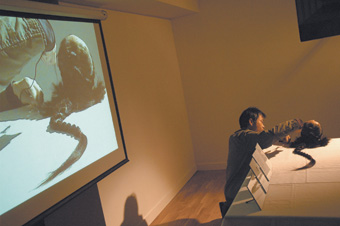
He Cheng Yao, Auction of Very Personal Possessions, bidder Cai Yuan
photos James Champion
He Cheng Yao, Auction of Very Personal Possessions, bidder Cai Yuan
He Cheng Yao (China) provided VITAL’s finale with an “auction of very personal possessions.” The nature of the lots on offer remained a mystery even as we queued to register for a numbered bidding card. A shiver of unease crept up on the crowd, jostled and crushed at the back of the room, peering round shoulders and under elbows, as we gradually made out the viewing table and the artist herself, utterly still, kneeling beside it. The event’s organiser, Sarah Champion, took to the podium as auctioneer and lit a tiny birthday candle. We would be bidding on He Cheng Yao’s hair, and the winner would be the last bid received as the flame went out.
A live video feed projected onto a big screen kept in view the ever-shrinking candle and He Cheng Yao with her head tilted uncomfortably backwards and her gaze tilted up, her hair braided into a long black plait stretched out behind her along the white tablecloth.
The severance of hair, whether involuntary or self-imposed is always a potent symbol, simultaneously evoking subjugation and sacrifice, modernity and emancipation. Here was a 10-year personal-history, 112cm of hair, offered willingly for sale, yet in a scenario that evoked an execution. At this time of meteoric escalation in the economic value of contemporary Chinese art, we were invited to question the role of the artist in the art marketplace. Auctions usually unite art objects and buyers without the inconvenient intrusion of artists. No need to think about the unpalatable lives that give rise to the works. He Cheng Yao’s performances are slow-growing and deeply personal. Her work has consistently drawn on intimate, often painful biographical experiences; they do not emerge lightly, and are not performed without emotional consequence. Was her hair just another decorative commodity?
While the ethical considerations of buying part of someone else’s body began to percolate through the room, along with questions about racial and gender power relationships and all the cultural and historical implications of hair-shearing…the first bidder was already marking out his territory with an assertively high offer. Participation in the sale had been swept imperiously out of most people’s reach. Heads craned to spot the big-money investor, and discovered artists Cai Yuan and JJ Xi bidding determinedly until emerging victorious to the tune of £325.
The Chinese-born, British-based duo have made a habit of intervening in other artists’ work since 1999: holding a pillow fight on Tracey Emin’s bed and pissing on Duchamp’s urinal. Was this to be another artistic hijacking?
Perhaps the high bidder was expecting simply to snip off the pigtail and hold it aloft triumphant, for Cai looked uncharacteristically gobsmacked to discover that, like Shylock, he was required to claim the entirety of his prize clean to the scalp. For ten long minutes, He Cheng Yao stared unflinchingly into the eyes of her new collector as he struggled to scissor his investment free. So whose was the crowning glory?
VITAL 06, Chinese Arts Centre, Manchester, UK, Nov 2-5 2006. VITAL 07 takes place October 2007. www.vitalfestival.org
RealTime issue #77 Feb-March 2007 pg. 4
© Judith Palmer; for permission to reproduce apply to realtime@realtimearts.net
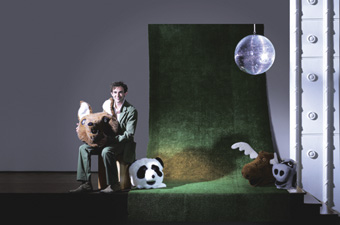
Michael Kantor
photo Garth Oriander
Michael Kantor
“When we stand at the edge of the sea, or lift a child high against the sky, or look deep into the eyes of another—with love or sadness or just pure fascination—we are giving ourselves leave to experience what is outside of time. This is precisely the gift of theatre. To give us the extended moment to know what we think and what we feel. It gives us leave to know the beautiful, the disturbing, the unspeakable strangeness of our selves.”
Michael Kantor, Introduction, Malthouse Season One ‘07
Artistic director Michael Kantor is in his third year with the company he and Stephen Armstrong transformed from Playbox into Malthouse. We met in Sydney to discuss the company’s first 2007 season and in particular how the company works, the kinds of theatre it embraces—from plays to intimate performative installations, music theatre and dance—and the aesthetic and political challenges for theatre as concepts of form, of ‘mainstream’ and aesthetics undergo significant change.
malthouse at work
While I’m technically the Artistic Director and Stephen Armstrong is technically the Executive Producer, we work alongside Catherine Jones who’s our Associate Producer and Maryanne Lynch, our Dramaturg in Residence. We’re all very involved in the programming. We can all bring things to the table to be considered. If one of us has seen a show that is interesting because of the particular artists in it or its writing, we quickly attempt to all see it to keep the discussion going. Sometimes this is hard when a lot of the stuff is interstate. But we think it’s important that there’s not a single voice or a single command system. So we work very collaboratively on each season. Of course, the lead-time means that many projects are decided a good 18 months ahead of their premieres. Then it becomes incumbent, particularly on Maryanne and myself, once something has been conceived or a project may have been commissioned, to see it through and to give as much feedback and follow through and help as possible.
Because of our limited resources we can’t really afford to commission a lot. We can’t do that kind of seeding, that ‘well-let’s-just-see’ kind of process, which I’d love to do because I think that allows for a different type of liberty for artists. But I’m finding that what we can do best is support work coming out of the Melbourne independent theatre scene, for those artists to grow into larger theatre spaces because if they don’t get the experience through Malthouse, they won’t get it at all. Then we’ll be in an awful position in 10 or 15 years where there will be no artists who have the training to conceive and understand what it means to put a large show on in a large space. So we like to give opportunities to those artists but also to expose audiences to work which I think is leading the theatre into a new and exciting territory.
whose theatre?
I had to make a choice quite early on. Was this going to be the Michael Kantor Theatre Company, which was an option. The board were quite willing for me to do that. In that guise it would have been four shows a year from Michael Kantor and collaborators, with two or three other things. But I thought, with a lot of consultation, that would be an inappropriate use of this resource—this fabulous theatre building that is really important in the ecology of Melbourne theatre [as] a crossover point for artists to be able to merge with what one may call the mainstream. But the mainstream in itself is indefinable now. It’s changed. So, it’s really about achieving a point of professionalism for artists that leads to greater visions, greater dreams being reached on stage and greater audiences for that work. While the Melbourne independent scene is booming, it’s booming to small audiences. Shows sell out to 60 people a night. And that’s great but we need those artists to be exposed and creating work that can attract 200 people and then 300 and ultimately 500, and fill the Merlyn. Now that’s a struggle for anyone, I might say, at the moment. But it has to be like that because it’s not actually sustainable on a small level—not if those artists want to work all their lives in the theatre.
There are about three or four new commissions a year. There’s no time-line for when they’ll be realised although there’s a broad belief that if it’s taking more than two years to get to the stage there might be something wrong and we’d better think about it. In some cases, a work may be quite well formed. It just needs the injection of rehearsal time, which can be short actually. Some shows have had ‘boutique’ seasons in Melbourne’s smaller spaces, so we invest to bring them to a level and scale that can work in the theatre we’re proposing for them. And hopefully this way we allow those artists to further develop the work and refine it and see it complete, or as complete as theatre can ever be. A lot of these works are small; a lot are solos. Some are four-handers. It’s been rare that we’ve been able to invest in anything larger than that. I dream of a day in which it is possible that a great Chekhov production or a new work created by a group of artists in a warehouse can be taken up, professionalised and attract 500 people a night. Be it a Chekhov or a new work, I don’t have a big hang-up about how many shows are ‘new’, how many are ‘reinventions.’
Right now The Tower is the most likely venue for our support for independents, for financial reasons, although in our first season for 2007 we have The Pitch, Peter Houghton’s very funny solo in the Beckett for the Comedy Festival. It’ll do very well and it can work in that theatre. And Uncle Semolina and Friends will perform OT in the Beckett too. Nowadays there are more options for independent artists through FULL TILT at the Arts Centre, Arts House at North Melbourne Town Hall and what we’re doing at Malthouse.
the director directs
In my first year here I did three plays, the next year I did two. This year I’m only going to direct one. But I have plans for about seven in 2008! But that can’t happen. I think three would be the maximum and they can’t all be large. That’s to do with our finances but also to make sure that I’m accessible and not just in a rehearsal room all the time. Artists find conversations, even if they don’t lead to work with us, are important. We like to keep the door open. We have a process where anyone can submit anything as long as they’ve had a professional engagement of some sort and they can describe their work in two pages.
the german connection
One of our dreams for 2008 is a new work by writer Marius von Mayenburg and director Benedict Andrews [Andrews directed von Mayenburg’s Eldorado for Malthouse in 2006, RT 74, p42]. It’s dependent on a certain amount of funding which is currently beyond us, but we’re very hopeful. We’re simply calling it “The Secret Project” at the moment. Benedict and Marius spent a few weeks last year working on it with a great group of actors. We hope to extend and develop that process over this year. I’ll be able to say more in about a month. But I’m very keen to continue our collaboration with Benedict Andrews: he’s a fabulous director and it’s very important that Melbourne gets past its, “Oh, that’s just some Sydney director” parochialism—it means nothing. He’s just a fabulous director.
open to all the senses
Theatre can work so well as a simple voice under a spotlight in a darkened room, but it’s not the only form and it’s not the form that gets me closest to my subconscious, which is where I want to go. I always worry about the writer’s preoccupation with the word and its central focus in theatre. It can be. But it’s not the only way. I believe that theatre needs to be open to all the senses especially through potent visual imagery. The backhand response can be that such work is overproduced or ‘all style, no substance.’ To me that’s discounting the potency of the image in the first place. As if it had only ever meant to be there as wallpaper for the actors.
catharsis optional
There’s an assumption that every strong piece of theatre will take you on an emotional journey that will be cathartic. It’s a rear-guard action that Melbourne keeps throwing up at me: ‘Where’s the catharsis? Where’s my big, you know, my tearjerking moment?’ Theatre is about rhythms, that’s where a director’s vision or voice or collaborative process with others can be so distinctive. Benedict Andrews has a completely different sense of stage time to me. So do Barrie Kosky and Neil Armfield. I’m always beguiled by it. Mine’s very short, I should say. It’s like bang, bang, bang. Whereas I’m so impressed by the kind of control that can come from slowing time down and allowing that space of dream to open up for an audience. Robert Wilson does it—not always but sometimes fantastically.
outside ourselves
I’m not a great lover of theatre that reminds me of who I am, really. I prefer to be shocked, to imagine that I’m a little bit like something else. A lot of theatre has traditionally, particularly in Australia, attempted to show us ourselves simply, confirming our sense of ourselves. And I’m not convinced we need any more confirmation of ourselves as content and calm, fair and balanced, when clearly we’re not.
one day an ensemble
A company can have so many different ways of being. And there’s a great other model, which is the ensemble model. Ultimately, if I can’t achieve it at the Malthouse, one day that’s what I want. I want to work with an ensemble of actors and creative collaborators on a body of work. Barrie Kosky and Tom Wright’s The Lost Echo (RT 76, p36) would not have happened without the Sydney Theatre Company’s Actors Company. They needed to have worked together in the six months leading up to the work with Kosky for it to get anywhere close to where it got, which was a great distance. You would never expect a string quartet to play a concert without having rehearsed together for nine months. And like finely tuned instruments, actors need that. They feed off working together. In the meantime and for the first time at Malthouse we’ve added to the number of artists working daily with the company by having designer Anna Tregloan and lighting designer Paul Jackson as artists in residence. They’ll work on shows and get to understand the budgeting process and all of the rigour that needs to take place to make a theatre company work. They’re people who might one day want to run a company.
<img src="http://www.realtime.org.au/wp-content/uploads/art/2/280_kg_malt_black.jpg" alt="Black, Anna Tregloan, collage
with text excerpts from the Black Dahlia”>
Black, Anna Tregloan, collage
with text excerpts from the Black Dahlia
courtesy of the artist
Black, Anna Tregloan, collage
with text excerpts from the Black Dahlia
first 07 season
Like all our seasons, I hope there’s something old, something new, something borrowed, something blue. There’s a sense of bricolage about it. You’re not going to see six like-minded events.There is no unifying theme, but all these projects seem to sit perfectly together—they’re wry, they’re whimsical, all quite quirky in spirit—some of them unsettlingly so. Deep inside, all plays are united by a sense of paranoia and a fear of death. They’re also strongly fuelled by a libidinous urge, that’s theatre—the theatre that I like.
It felt like a strong, simple, bold first choice to open the season with Tom Healey directing Melissa Reeves’ The Spook, about Australia and Communism in the 50s. It cried out to be performed in Melbourne, and while ASIO is out there recruiting ‘spooks’ right now. It’s an interesting moment, a merging of our paranoia about terrorism simultaneously with paranoia about the dangerous words of the artist. Up in the Tower Anna Tregloan’s making a performative installation piece, Black, around the very gruesome Black Dahlia story told by James Elroy. She’s exploring themes around the female body in relationship to glamour and the hard boiled detective narrative but all fused in Anna’s special way with fragments of text. For me she’s designed The Odyssey and The Ham Funeral—big plays—but her mind is much more active than that and she’s simultaneously been doing durational installation works (RT 57, p40). Black runs for three hours but you can come and go, watch and read. The performers include Caroline Lee and Moira Finucane and the lighting is by Paul Jackson.
Ionesco’s Exit the King is the big show in the season. Three years ago I read it with Geoffrey Rush and we both agreed it was fantastic and he said he’d actually read it with Neil Armfield so a conversation developed and now it’s a co-production with Company B with a great cast: Bille Brown, Julie Forsyth, Gillian Jones and David Woods who’s from Ridiculusmus, the fantastic English avant-garde comedy group. We follow up with OT (as in Old Testament). Uncle Semolina (& Friends) is a wonderfully inventive and intriguing group who did a series of works initially in a shopfront and have worked a lot with puppets, dolls and toys but doing elaborate, unsettling, big, mythic stories with them. That grew into a piece called Gilgamesh, which was very successful and is going to The Barbican in London. We commissioned OT from them last year. Christian Leavesley and Phil Rolfe have devised a piece that has a little tribe of Israel, a very jealous God (performed by Peter Snow) and it’s performed on a very simple, strange set. What I love about their work is the enthralling sense of miniature. There’s also Chunky Move’s Tense Dave in a return season—it was one of the favourite shows I’ve worked on as a director.
inspirations
In the third year of the company I always think we can do better. We’ve planted a lot of seeds and they’re growing. Some need a lot of watering. Some of them will be beautiful and some will wither. That’s what keeps me going, the conversations that surround the creation of a work of theatre. But I also get a thrill like no other when a performance works. And particularly when you’ve been involved in helping collaborate with a group of artists to get it there. I’ve got three kids—six, nine and eleven. They keep you going because there are times in life when work just has to stop. There’s just no chance of that conversation continuing when really there’s something much more interesting taking place on a trampoline. That’s really good for me.
* * *
Michael Kantor’s enthusiasm for innovative Melbourne theatre and the Malthouse vision is palpable, energetic and eloquent (a trait he shares with the likewise lanky and indefatigable Stephen Armstrong). Long may Malthouse seed and grow.
Malthouse, www.malthousetheatre.com.au
RealTime issue #77 Feb-March 2007 pg. 10
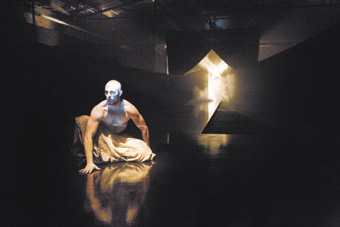
Alan Knoepfler, The Damask Drum
photo Kat Soutar
Alan Knoepfler, The Damask Drum
LIMINAL THEATRE’S THE DAMASK DRUM IS THE SECOND OF DIRECTOR ROBERT DRAFFIN’S INVESTIGATIONS INTO THE WORKS AND WORLD OF JAPANESE WRITER YUKIO MISHIMA. HERE, DRAFFIN AND HIS COLLABORATORS HAVE CREATED A NIGHTMARE FROM WHICH I DIDN’T WANT TO WAKE: A VISION WITH AN EXCORIATING EMOTIONAL BLEAKNESS VERGING ON THE UNBEARABLE, BUT REALISED IN SUCH AN ASTONISHINGLY ORIGINAL AND COMPLETE WAY THAT I COULDN’T HELP BUT BE TRANSFIXED.
Mishima’s story, adapted from a Noh play by one of the form’s originators (Zeami), is of a narrative simplicity that belies the deeper emotional resonances it eventually generates. A man, Iwakichi, is tricked by a cruel woman who gives him a drum and tells him that, should he beat it loudly enough that she hears it from her bedroom, she will be his. The drum’s skin, he discovers, is made of damask, and no matter how hard he beats it no sound can be produced. Despairing, he kills himself but the weight of his anger and desire transforms him into a demon, the literalisation of the woman’s crime, haunting her for all eternity.
It is through the stunning precision of both production and performance that The Damask Drum sounds so loudly for its audience. Light is tangibly, if sparingly employed to both illuminate and limit our senses. Beginning in near total darkness the imposing figure of Alan Knoepfler, a naked and muscular torso emerging from a cloud of billowing skirts, slowly seems to coalesce before us. A pale wraith writhing, seething, spitting his story and gripped by forces beyond our ken, he holds our focus with an almost alarming vocal and physical confidence. The unfolding tragedy he relates is scored by Jethro Woodward’s effects-laden live guitar, like a heavy and mordant Neil Young on a very bad trip, and elliptical and uncertain snatches of grainy film drifting across suspended panels.
When the object of the ill-fated Iwakichi’s desires finally joins him in his half-death, she comes as the kind of oni or spirit entirely appropriate to Japanese mythology, her kimono eventually expanding to cover most of the visible playing space, an ogrish empress who has become, very literally, her victim’s world. But his haunting subsumes her, too, and the endless dance of death and yearning between the two makes for unforgettable theatre.
requiem for the 20th century
The scale of ambition behind Theatre @ Risk’s Requiem for the 20th Century is either its triumph or its unmaking, depending on where you stand. In a sense, any project which seeks to survey and represent an entire century (or even, in this case, only its first half) is a monumental folly. But I found in this case a work whose internal logic seemed aware of its own insufficiency, and which utilised this as a source of motive power.
There are two competing narrative forces driving the work. The first is a love story in the classic realist mode: Cassandra and Red, kept apart by history’s vicissitudes, personal failings and tragic misunderstandings, chart a course that ends in a small moment of reunion by telephone across the oceans.
Against this narrative, driven as it is by the logic of conventional drama, is the historiographic stream of the work, which seems to work against it. Requiem doesn’t engage in capital-H history as an exercise in sense-making, producing a narrative development to very real events matching the fictional drama. Instead, it offers history as iconic moments with little, well, point. Figures from Archduke Franz Ferdinand to Walter Benjamin, along with Brecht, Hitler, Rasputin, Dali, Nellie Melba and many others crowd in only to disappear as quickly. It’s history as catalogue, not story. They’re shown, but not explained. They’re often cartoonish or badly drawn. Which, to me, seems an aesthetically appropriate choice.
History-making, as any half-alert Australian is aware, is an ideological practice, and in choosing a kind of picaresque, even carnivalesque approach to history, Requiem problematises such official histories without denying the possibility of historical understanding. It’s a deeply dissatisfying work, in this way, setting itself a task it cannot achieve; and this is exactly its strength.
apolitical dance
Not Yet It’s Difficult’s most recent work seems diametrically opposite to Requiem. Where the latter work is a taxonomy of historical detail that revolves around a hollow centre, NYID’s Apolitical Dance is abstracted to the extreme. It purports to examine the effects of conservative power on real bodies, but it does so in a purely physical, decontextualised manner. The performers are bodies without identity, in a space without location or time. They are beaten or electrocuted, they march drills, they dance to moronic music, they abuse themselves and each other. But unlike earlier NYID productions, the work doesn’t add up to more than the sum of its parts.
Some elements seem recycled from earlier works—the extended sequences in which performers throw one another head-first into large padded panels was employed to far greater effect in the company’s exquisite Blowback from 2005. Where that piece was a complex and imaginatively assured meditation operating on numerous ontological levels, Apolitical Dance seems rarely to connect itself to anything beyond the moment of performance. Or it does so in a disappointingly restricted way. I found the final sequence, in which a game of Aussie Rules football is enacted while a Nazi anthem provides a musical backdrop, almost laughable. Perhaps, given the work’s title, this is all intended: movement as an ironic retreat from politics. Then again, given the company’s history of highly sophisticated and engaging work, I expected a little more. (See also Christopher Scanlon, “Lost in Translation “, p43.)
for samuel beckett
I’ve long been a bit of a skeptic when it comes to productions of Beckett; not that I dispute the mastery of his rich and very entertaining writing, but it seems his legacy has often been so strong as to offer a hindrance to new, more relevant forms of theatre. The milieu of Beckett’s postwar Europe provided the fundament for a mode of writing which commented on the world in new and urgent ways, but that Beckettian silence and all it entails seems less appropriate now that it has become canonical. I’m all for messy, polyphonic theatre, which says too much rather than too little, which forges through postmodern chaos rather than looking back to the cresting wave of High Modernism which is Beckett.
Eleventh Hour Theatre’s For Samuel Beckett is as fine a production as I’ve seen. The bulk of the evening is a performance of Endgame, preceded by a series of texts which either inform or were informed by Beckett’s developing aesthetic (a reading from Joyce’s Ulysses; a Bach violin solo; a Buster Keaton film he penned entitled One Week). But these contextualisations don’t really add to the evening in a vital, necessary way. Interesting, but more along the lines of Further Reading or a disc of DVD extras. It’s a relief that the ensuing Endgame is of such an impressively high calibre. The cast, especially Peter Houghton as Hamm, are all able to draw out the subtlest connotations of the writing. Best of all is the way directors William Henderson and Anne Thompson have keyed up the comedy in Beckett’s writing, which is often dependent on finding a rhythm much snappier than that usually effected by those distracted by the pauses.
Eleventh Hour have forged an outstanding reputation for keen-eyed adaptations of classics, and with the exception of the seemingly extraneous additions bookending the evening, this Endgame had me thinking that perhaps there might still be many reasons to pay Beckett that occasional visit.
The Damask Drum, text Yukio Mishima and Zeami, adaptation, direction Robert Draffin, sound design Jethro Woodward, performers Alan Knoepfler, Mary Sitarenos, film Ivanka Sokol, Liminal Theatre, Abbotsford, Melbourne, Nov 15-26; Theatre @ Risk, Requiem for the 20th Century, Volume 1, writer Tee O’Neill, director Chris Bendall, set & costume design Isla Shaw, sound design Kelly Ryall, lighting design Richard Vabre, musical director Victor Bizzotto, New Ballroom, Trades Hall, Melbourne, Nov 17-Dec 3; Not Yet It’s Difficult, Apolitical Dance, direction David Pledger, Arts House, Meat Market, North Melbourne, Nov 28 – 2 Dec 2; For Samuel Beckett: Endgame, writer Samuel Beckett, directors William Henderson, Anne Thompson, Theatre, Fitzroy, Nov 25-Dec 9, 2006
RealTime issue #77 Feb-March 2007 pg. 41
© John Bailey; for permission to reproduce apply to realtime@realtimearts.net
<img src="http://www.realtime.org.au/wp-content/uploads/art/2/283_reck_matasaburo.jpg" alt="Yusuke Mori, Yoshinao Kobayashi,
Masayuki Sato, Hidekatsu Yamamura,
Chiaki Kato, Matasaburo”>
Yusuke Mori, Yoshinao Kobayashi,
Masayuki Sato, Hidekatsu Yamamura,
Chiaki Kato, Matasaburo
photo Anton Honda
Yusuke Mori, Yoshinao Kobayashi,
Masayuki Sato, Hidekatsu Yamamura,
Chiaki Kato, Matasaburo
THE FIRST SIGNS OF A DANGEROUS DRAMATURGY IN SHINJUKU RYOZANPAKU’S MATASABURO—ANGEL OF THE WIND EMERGE WITH THE APPEARANCE OF SEVERAL KAMIKAZE PILOTS SITTING IN A CLASSROOM AT A FLIGHT INSTRUCTION SCHOOL. THIS SILENT MILITARY PRESENCE AND THE SUGGESTED FUSION OF CONTEMPORARY JAPANESE SOCIETY WITH THE WARTIME RUPTURES OF ITS RECENT PAST IS REMINISCENT OF THE PLATOON IN POLISH AUTEUR TADEUSZ KANTOR’S WIELOPOLE WIELOPOLE. BUT PLAYWRIGHT KARA JURO (CREATOR OF JAPAN’S RADICAL RED TENT THEATRE) AND DIRECTOR KIM SUJIN ARE LESS INTERESTED IN THE INTIMACY OF THE PERSONAL-POLITICAL AND MORE INCLINED TOWARDS CONVEYING THE KALEIDOSCOPIC PATHOS OF CONTEMPORARY JAPAN’S EAST-WEST SCHIZOPHRENIA. EXPRESSED VIA A COMPLICATED NARRATIVE It THREATENS TO BRING THE PERFORMANCE CRASHING TO THE GROUND.
The Shinjuku Ryozanpaku ensemble embodies ‘Angura Engeki’ (underground theatre). Its twin characteristics of ‘kerenmi’ and ‘kabuku’ (adventurous directing and acting designed to attract attention) propel the action forward through a vertiginous array of vaudevillian scenes. A character named the Night Man ritually slaughters others with a chicken and three performers dressed as vultures (their anuses decorated with plastic daisies) brown-eye the audience before sequentially taking symbolic ‘dumps’ centre stage.
Matasaburo is scatological, scatterbrained and spatially dispersed, using the entire stage and the space behind the audience in its purple tent. But it is also a serious and disciplined performance, all the more beguiling because it is directed and performed in such a manner that makes it appear a sham, if not shambolic. But always lurking beneath the apparent madness on stage is a clear directorial hand fully aware of the subtle meanings embedded within Kara’s text: post-World War 2 Japan, a dynastic society haunted by the memory of atomic obliteration; a society defeated and colonised, only to emerge as an East-West economic ‘wonder child’ until recent more anxious times. In Japan, like so much of the West, all seems lost once again.
This tragedy is revealed via a tale of a former mental patient, minus an ear, and a cross-dressing woman descending into an Orphean underworld in search of a trainee pilot who has stolen an aeroplane and subsequently disappeared. The plot suggests a question essential to Japanese and Australian culture: do we feel inexplicably guilty because we lack a clear sense of identity as the consequence of a befuddled and secretive history?
But playwrighting is only part of what is realised as a visual tour de force. The performers propel Matasaburo—Angel of the Wind onto a transcendental plane. They sweat, scream, dance and sing. They hurl their bodies through the space, wearing heavy costumes in 35 degree heat. They slash throats and spurt blood in a 360 degree arch, and do this with a lack of inhibition made compelling because it is disguised as raw and chaotic. The visual language of Matasaburo inundates and disassembles the senses, but at the show’s end reconstitutes them in a powerful image. The rear wall of the tent collapses, revealing a full-scale Japanese war plane and the Rising Sun, suggested by stunning lighting, with the entire spectacle backdropped by evening traffic on Melbourne’s Exhibition Street. You are witnessing an event that will linger in the mind for an eternity.
Finally, its propeller spinning, the turbocharged engine humming thunderously, the warplane is hoisted out of frame by an unseen mobile crane. Yes, it actually appears to fly away into the distance! The performers, composed, beaming, choosing not to bow, re-enter the space receiving adulation from the audience. In the end it is we who are humbled by the utter virtuosity of this astonishing ensemble.
Matasuburo—Angel of the Wind, writer Kara Juro, director Kim Sujin, performers Shijuku Ryozanpaku Ensemble, lighting designer Tsugo Izumi, choreographer Taeko Okawa, composers Yoshio Anbo, Takashi Onuki, costumes Yuka Kondo, set design Satoshi Otsuka, Melbourne producer Matt Crosby, Soupad; 2006 Australia-Japan Year of Exchange; Birrarung Marr, Melbourne Dec 21 – 23, 2006 www.soupad.com/ryozanpaku.html
RealTime issue #77 Feb-March 2007 pg. 42
“IF YOU CHANGE THE GOVERNMENT, YOU CHANGE THE COUNTRY”, PAUL KEATING DECLARED IN THE LEAD UP TO THE 1996 FEDERAL ELECTION. KEATING OVERESTIMATED THE ROLE OF THE GOVERNMENT IN DETERMINING THE CULTURAL CLIMATE; IT WOULD HAVE BEEN MORE ACCURATE TO SAY THAT THE COUNTRY HAD ALREADY SHIFTED AND KEATING AND HIS ADVISORS WERE SLOW IN REGISTERING IT.
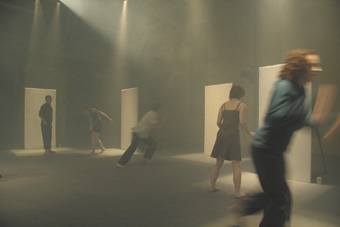
Apolitical Dance, NYID
Not Yet It’s Difficult’s Apolitical Dance addresses the impact of such changes, exploring how 10 years of neo-conservative government, along with contemporary social and cultural conditions, have changed our minds and manifested in our bodies.
Five dancers move slowly through a thick fog, four encircling a fifth and central figure. In the distance, the sounds of football commentary waft through the fog. It’s reminiscent of Saturday afternoons in suburbia.
These familiar sounds soon give way to the five bodies convulsing as if pregnant with Ridley Scott’s Alien, readying for its unholy birth and suggesting that neo-conservatism is an alien entity, lodged in the host body politic.
The performers move into increasingly alienated and individualised states, launching their bodies with mounting violence against walls to the strains of The Seekers. The juxtaposition of innocent music and violent movement evokes the unsettling ear-cutting scene in Reservoir Dogs, where Stealer Wheels’ “Stuck in the Middle with You” provides a bizarre soundtrack to mutilation. Contemporary life here is anomic and traumatic.
But there is another, perhaps more widespread experience of conservatism that embraces it as pleasurable. For many, as the electoral success of Howard’s Government testifies, these changes are experienced not as traumatic but, on the contrary, as comforting as a pair of old slippers or an episode of Dancing with the Stars.
The roots of this conservatism, moreover, are indigenous to the body politic itself, rather than some imported, alien ideology that has implanted itself in the host culture.
Apolitical Dance never really ventures down this path, only hinting at the pleasures of conservatism through a momentary dip into high camp as the dancers perform to a German folk tune. However, camp suggests a knowing, playful attitude towards its subject, which can be a way of engaging with the unfamiliar while simultaneously holding it at a distance.
In other ways too, the performance shied away from the contemporary conditions of conservatism, opting instead for unpersuasive parallels between contemporary social and cultural life with conservative forms of the past.
The playful Leni Riefenstahl-style climax, in which the performers strike a series of heroic poses in mock glorification of the athletic body before exiting into a blaze of lights, was a good example. A more promising approach might have been to explore the particular relationship of sport and authoritarian politics in contemporary culture, rather than a rather obvious reference to fascist propaganda of the 1930s. The reversion to stereotypes of authoritarianism blunted the potential force of Apolitical Dance’s commentary.
This is not to question the integrity or the urgency of the work. Indeed Apolitical Dance seeks to grapple seriously with contemporary issues, taking inspiration from the works of anthropologist Ghassan Hage, Nikos Papastergiadis, the author of Stasiland, Anna Funder and Samuel Beckett’s The Lost Ones
The challenge of working with such a diversity of influences and styles is how to translate them into a performance work. These influences were sometimes lost in translation from the page (or the stage) to the bodies of the performers, the vocabulary of movement and gesture straining to articulate the influences, or interrogate them on a fairly equal footing. Contorted bodies, writhing and struggling out of their skin, lacked the nuance to fully realise the potential insights offered by such influences. The problem was particularly acute for a work concerned with the way ideas manifest themselves in bodies: movement and gesture tended to be relegated to the backseat, far behind the intellect.
Apolitical Dance is nevertheless an ambitious work, with a welcome sense of urgency about contemporary political and cultural conditions. However, it too is produced under the same conditions which it seeks to address, developed in a crushingly brief three weeks—perhaps a statement about how a decade of conservative government manifests itself in the body.
Not Yet It’s Difficult, Apolitical Dance, director David Pledger, dramaturg Peter Eckersall, performers Sara Black, Martin Hansen, Todd MacDonald, Carlee Mellow, Ingrid Weisfelt; Arts House, Meat Market, North Melbourne, Nov 28-Dec 2, 2006
See also John Bailey’s response on page 41.
RealTime issue #77 Feb-March 2007 pg. 42
© Christopher Scanlon; for permission to reproduce apply to realtime@realtimearts.net
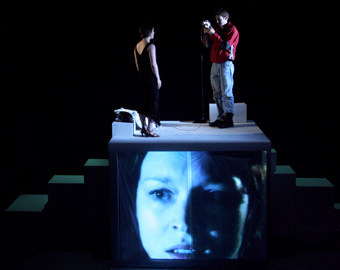
Antje Guenter, Nathan O’Keefe, Norway.Today
photo Nic Mollison
Antje Guenter, Nathan O’Keefe, Norway.Today
NORWAY.TODAY PREMIERED IN DÜSSELDORF IN 2000. THIS ENGLISH LANGUAGE PRODUCTION, DIRECTED BY JUSTIN MCGUINNESS FOR imaGEN AT BAKEHOUSE THEATRE IN ADELAIDE, RETRACES THE PLAY’S SCRIPTING OF NET-MEDIATED ROMANCE. IN THE OPENING SCENE, A YOUNG EUROPEAN WOMAN NAMED JULIE ANNOUNCES TO AN INTERNET CHAT ROOM THAT SHE INTENDS TO COMMIT SUICIDE.
Norway.Today is by Prague-born playwright Igor Bauersima. With actors Pascal Ulli, Alexander Seibt and Ingrid Sattes, Bauersima founded a theatre company called Off Off Bühne in Zürich in 1993. For a decade, they worked at producing ‘Filmtheater’, blending video screening and live performance for a new generation of theatregoers reared on the intimate realism of screen drama.
In the Adelaide production, seated at one side of the stage, Julie (Antje Guenther) speaks what she types and her face is projected onto a screen centrestage. As audience members, we are ‘lurkers’—the internet term for those in a chat room who read but don’t type. Julie is ambivalent about our presence; she turns at one point to address us directly: “Please don’t be upset if I just behave as if you’re not here.”
A young man responds. August (Nathan O’Keefe) has been lurking in the chat room on the other side of the stage—indeed, on the other side of the world because, in this production, August lives in Adelaide. Like Julie, August wants to commit suicide too. And like the summer romance conjured by the cute coupling of their names, they flirt as they chat and swap photos, plan to meet and then suicide together, in a secret location.
A swift video montage from Nic Mollison uses the global imaging resources of Google Earth to transport the couple to an icy cliff top in Scandinavia, overlooking a fjord. The actors climb a white box set, its front face serving as both the cliff and a surface for projections. There are some farcical moments on the cliff top. Each character, at different points, slips on the ice and almost falls over the edge. But it’s never quite the right time to jump.
Despite its initial appeal to the culture of the net generation, the play’s romance narrative is recognisably ensconced in two grand European philosophical traditions: as their relationship develops, the romanticism of sex in the wilderness triumphs over the existentialism of net-induced alienation. Perhaps in multilingual Switzerland and in the European Union this dialogue between (German) romanticism and (French) existentialism would sustain an intellectual tension.
In this production, the talk of suicide seems really just a cypher: deep and meaningful disclosures are a young person’s way of getting close. Why else would an eager Aussie backpacker fly across the world to hook up with a sophisticated European woman? When the couple see the Northern Lights and manage to capture that spectral display with their video cam, suicide slips down the agenda, readily displaced by sex.
As the suicidal Julie, Guenther is cheerful, smart and bossy. Her character tells us several times that when it comes to suicide she is very serious and completely sane. As the hapless August, O’Keefe is often breathless and easily outsmarted. August is talkative as a character and O’Keefe’s words sometimes run ahead of the character’s thoughts. Guenther, by contrast, speaks with precision and with her character’s determination and control. There is easy humour in this inverted portrayal of gender relations: the slightly older woman is rational and commanding, the somewhat younger man emotional and easily swayed.
There is also humour drawn out of their attempts to each record on video a suicide note for their families. But each time one of them records a message and reviews the take, it seems fake, too staged, too unreal. August records a speech that seems authentic, until he reveals that he is quoting from a self-help book. As their attempts on video multiply the singularity of suicide, the playwright revels in the irony of performance: “That was a fake”, complains August. “But it looked real”, counters Julie.
We may learn from this—from the dependence of their actions upon the tools of domestic media production—something of the difficulty of dying in the age of digital replication. And from this production, which was unremarkably effective in its smooth enrolling of video mediation within its live theatricality, we may learn that what was once an experiment in performance innovation is now so fluent in its conventions that it can deliver classic European romance with charm.
Image: Antje Guenter, Nathan O’Keefe, Norway.Today, photo Nic Mollison
imaGEN, Norway.Today, writer Igor Bauersima, translator Marlene Norst (commission, Goethe Institut Sydney), director-designer Justin McGuinness, performers Antje Guenther, Nathan O’Keefe, lighting designer Nic Mollison, sound designer Peter Nielsen; Bakehouse, Adelaide, Nov 4-18
Norway.Today is touring through Critical Stages (www.criticalstages.com.au) 2008-9. Directed by Glenn Terry working with a national advisory panel and supported by Arts NSW and the Theatre Board of the Australia Council, Critical Stages organises and manages tours of independent theatre productions that have achieved successful initial seasons.
RealTime issue #77 Feb-March 2007 pg. 43
© Jonathan Bollen; for permission to reproduce apply to realtime@realtimearts.net
<img src="http://www.realtime.org.au/wp-content/uploads/art/2/286_kg_adfestcentre.jpg" alt="Lara Tumak, Amelia Best, Roderick Cairns,
Katherine Tonkin, Austin Castiglione,
Grant Cartwright, Jet of Blood, InSpace”>
Lara Tumak, Amelia Best, Roderick Cairns,
Katherine Tonkin, Austin Castiglione,
Grant Cartwright, Jet of Blood, InSpace
photo Ponch Hawkes
Lara Tumak, Amelia Best, Roderick Cairns,
Katherine Tonkin, Austin Castiglione,
Grant Cartwright, Jet of Blood, InSpace
THE SYDNEY OPERA HOUSE’S STUDIO, DRAMA THEATRE AND PLAYHOUSE SPACES ARE INCREASINGLY SITES FOR THE UNEXPECTED, THE POPULAR AND THE CHALLENGING IN THE ARTS. MELBOURNE’S ARTS CENTRE IS NOW PROMISING SOME OF THE SAME WITH ITS FULL TILT PROGRAM. IN RECENT YEARS THE ADELAIDE FESTIVAL CENTRE’S INSPACE PROGRAM HAS FROM TIME TO TIME SUPPORTED EMERGENT AND INNOVATIVE ADELAIDE PERFORMANCE, BUT NOW THE WHOLE CENTRE LOOKS SET FOR MUCH NEEDED AND ADVENTUROUS PROGRAMMING THAT COULD ALTOGETHER REVITALISE IT.
The Centre has enjoyed some wonderful times in the 70s and 80s but outside the biennial Adelaide Festival, the annual Cabaret Festival and now Wagner’s Ring Cycle (which led to the rejuvenation and substantial improvement of one of Australia’s few great large scale theatre spaces) it had fallen into cultural torpor, its theatres in the dark for up to 40% a year. The new CEO, Douglas Gautier is determined to wake the slumbering giant into new life. We asked Gautier about his memories of the Adelaide Festival Centre when he worked there as an actor in the 1970s. Wagner’s Ring boomed from his adjoining office.
1970s
I remember it as it was when I first came here as a young actor when George Ogilvie was directing the State Theatre Company. Anthony Steel was running the place. He had the joint title the way I do; he ran the place artistically and administratively. I think that’s important. I remember lots of wonderful things happening here, musically and in theatre and dance. I remember people being around a lot, and Come Out and all those sorts of things. There were lots of ideas, lots of “mulch.” There was excitement and engagement—people coming here locally, nationally, internationally. There was a good sense of aspiration and a wonderful set of venues. And I still think we do have them, but it’s more about what goes in it than the buildings themselves. So, I remember that and I always counted myself fortunate to be part of it. It gave me great confidence when I started to look at other things elsewhere. I went from here to the UK to work with the BBC as a music and arts producer. I found some interesting things there but I also found a lot of it quite boring in contrast to some of the things I’d seen here in Adelaide. The mix here was good. Justin Macdonell was doing his stuff with New Opera and Myer Fredman; Wal Cherry was ‘going crazy’ up the hill at Flinders University; Robyn Archer was here doing stuff with Wal; George Ogilvie with Rodney Fisher and Helmut Bakaitis … all of that was a really good mix and there was a political commitment to it.
leading with programming
When I was tapped on the shoulder for this job, I said, well look, as far as I’m concerned, the best arts centres in the world are the ones that are program-led. If you look at BAM or the Barbican, Sydney Opera House and others we could name—the Kennedy Centre—there’s no question what the driving prerogative is. It’s programming and the centre itself has strong curatorial control, it works with home companies but it has a very large say in the programming that it does. Without that, you don’t have anything. You become like a garage or a hall for hire. So you’ve got to have a program as a start. And from that will come audience development, box office, sponsorship, the fusion, the yeast, all of that… Without it, you’re gone.
the content
On the one hand, it comes from the home companies. There’s a very strong commitment to have the State Theatre Company in here. It’s their home. State Opera do studio productions. All of that is with us, and their Ring Cycle. The Adelaide Symphony Orchestra plays here more and more, especially for the big works. The Town Hall is fine for Mozart or whatever but if you’re going to do Mahler or Missa Solemnis or some of the big stuff, Brahms’ German Requiem, Elgar symphonies, this is where it ought to be. Increasingly, we’re doing that. I want to bring ADT and Leigh Warren back in here, Windmill and some of the small and medium companies. The home companies are important. But, at the same time, it seemed to me that we needed to have some real curatorial say about our own destiny. [Gautier exits momentarily to turn down the Wagner.]
seasons
So, we have looked at doing three genre seasons. One is Pivotal: World’s Best Dance. Essentially what we’re doing with that program is joining the dots. Australian Ballet is here (The Nutcracker), ADT (Devolution) and Leigh Warren (Wanderlust). So what else can we put in between? We’re bringing Sydney Dance Company’s Grand and Cloud Gate’s Cursive, from Taiwan (see p38). I had all three parts of Cursive in my Hong Kong Arts Festival program this year. This is the first part. It’s an extraordinary work about the company’s founder, Lin Hwai-Min, taking Chinese calligraphy and ‘moving’ it. It’s had a 30-year gestation and it is just astounding. Quantum Leap is in there too, the Australian Choreographic Centre’s youth ensemble from Canberra.
We want to make the program quite eclectic. It’s got to have some solid backbone for audiences we know we can count on for dance. But what we’re saying to that audience is, look you’ll come along to the Australian Ballet, why not try some other things? And we’re also trying to cross-market to our theatre audience by saying, “Dance covers myriad forms—take a look at what’s there.”
We also wanted to look at international theatre. In our CentreStage program we’re hosting A Midsummer Night’s Dream by Yohangza Theatre Company from Korea. You couldn’t get a ticket for it last year at Edinburgh. There’s a wonderful resurgence in Korean performing arts. We’re also doing Krishnan’s Dairy from New Zealand by a wonderful Indian family who live in New Zealand. It interweaves a story of the Taj Mahal with that of a New Zealand dairy. We’re bringing Theatre des Bouffes du Nord’s production of Athol Fugard’s Sizwe Banzi is Dead, directed by Peter Brook. We’re doing Hamlet with State Theatre, which they wouldn’t have been able to do normally—you know what the deal is these days, no cast greater than six or whatever, And, of course, we’re presenting Snugglepot and Cuddlepie with Windmill.
On the music front we have the Sunday Spectrum series in the Artspace gallery—all crossover music; some of it is classical. I feel pretty strongly that we’ve got to get music into the mix. Womadelaide is a good example. But Womadelaide only happens four days of the year. We think there’s a big audience there. We’ve just got to tap it through our trans:mission program with New York guitarist Kaki King, oud player Dhafer Youssef from Tunisia, the Soweto Gospel Choir, the great jazz pianist Herbie Hancock, and sitar player Pubayan Chatterjee.
desination adelaide
Then there’s a whole summer program. For the last four or five years I’ve been coming back from Asia and sitting on the Tourist Board here and find the place dark over summer and Christmas. I hate that! Sitting on that Tourist Board I was thinking about how you brand—terrible phrase—a destination. I still believe the strong points of difference for Adelaide are probably wine and the arts. It’s also that sort of second city thing, like Chicago, or Edinburgh or Kyoto or Barcelona. That’s the thing we ought to really seriously go for. And if you’re going to do that, you’ve got to find points of difference. You have to make sure that the work is really first rate. You’ve got to have some ideas, which make for national leadership.
the asian connection
One of these ideas is the Ozasia Festival. Look, Australia and Asia are having all sorts of dialogue in terms of business and politics and what have you. Interestingly, I think in the visual arts there is some organised interaction, for example in Brisbane [in the Asia Pacific Triennial, see p8-9]. You can see it in the acquisitions policy instituted at the National Gallery in Canberra, first with Myer and then Ron Radford. But I couldn’t see any systematic approach to it in terms of showcasing and contrasting as far as the performing arts are concerned.
What I’m most interested in is where Australian and Asian artists collaborate and the work of Asian-Australian artists like William Yang, Lindy Lee…ADT, Leigh Warren and Flinders Drama Centre have had connections with Korea and Japan. We want to explore that systematically. Ozasia will happen in October with the Lunar Autumn Festival right smack in the middle of it. So we’re going to do a massive lantern festival that anybody can participate in.
guitar, guitar
Then we’ll have the Adelaide International Guitar Festival in November-December. The guitar is to the 20th and 21st centuries what the piano was to the 19th…The guitar has made its way into just about every kind of music; West Africans have made it their own and the Cubans. The idea started from discussions with David Spelman and his New York Guitar Festival (www.newyorkguitarfestival.org)—we’re going to bring all the festival’s artists out and add all the fine guitar players in Australia in a program ranging from classical guitar and orchestra to a final night tribute to Jimi Hendrix out here on the lawns with lots of musicians interpreting his work, and who are not necessarily rock ‘n roll players at all. We’ll have a battle of the bands. It’ll be a two-week festival: 20% content imported, the rest Australian.
inspace
The final piece of the jigsaw is InSpace, which we’re ramping up several notches. Why are we doing that? Well, I walked the city for the first couple of months and looked at all the other places where performance is happening in this city. And, with all due respect to those venues, I just don’t think there is an alternative performing arts centre in the way there is in Sydney or Melbourne, There isn’t one with any real firepower. So I said to Nick Skibinski, who runs InSpace, look, why don’t we take The Space here and rethink it and make it possible for the best of those small and medium-sized companies and individual artists whom we think should be seen by a wider audience and make sure that they have a home. There should be some kind of consistency, an audience thinking if I want to see some cutting edge work, something a bit different, something that’s going to really smack me between the eyes, I know if I go down to The Space most nights, there’ll be something on. So that’s what we’re going to do.
hong kong festival
It was a wonderful experience being Executive Director of the Hong Kong Arts Festival [Gautier was appointed 2002]. I’ve been associated with it since the late 70s when I first went to Hong Kong [to work for Radio Television Hong Kong; later as Director of Corporate Affairs for STAR Television; and then Deputy Executive Director of the Hong Kong Tourist Board] and I’d directed opera for it and some music theatre works in the late 70s and early 80s. I served on the program committee and subsequently the board. The festival has done some fabulous things: commissioned an opera from Tan Dun (Marco Polo); Chinese composers like Bright Sheng had their first major performances at that festival. While I was there we formed an Asian Arts Festival Association. The executive board was Shanghai Festival, ourselves and Singapore Festival and most of the festivals around the region, a crucible for commissioning new work. We commissioned work from China National Theatre which, despite its name, is probably one of the most interesting young companies in China today. That work ended up playing in Singapore, Hong Kong, Beijing and Shanghai. Choreographers and composers from Korea, Thailand, Singapore, India, China and Japan came to work together. And the Hong Kong Festival was very much in the thick of that. The most interesting thing about the performing arts in Asia is that there is great confidence in their cultures because they’re all so deep-seated.
Adelaide Festival Centre, www.adelaidefestivalcentre.com.au
RealTime issue #77 Feb-March 2007 pg. 47
© RealTime ; for permission to reproduce apply to realtime@realtimearts.net

Murray McKeich, pzombie
From pre-cinema visual entertainments to the first Second Life performance art group, RealTime 77 celebrates media arts, a far-reaching field of not always screen-based and increasingly interactive works that are fast disappearing old meanings of ‘audience’, to create an arts experience that is insistently more immersive and mobile, and arts users who mutate into active participants. The new media arts domain of the Australian media arts field, although still vigorously infecting all forms and practices with its innovations, has been battered in recent years by the ill winds of artform envy, category debates, funding losses, reduction in institutional support and a consequent lessening of visibility. The ‘new’ has been struck off the new media arts label, leaving us with a looser, less troublesome, if often meaningless moniker. And yet, while some new media artists have fallen by the way, overwhelmed by costs, scared off by funding detours or exhausted by the sheer duration of working technology into form, many Australian artists and media arts organisations keep doggedly at it, as this edition of RealTime extensively illustrates. Media arts as a totality looks healthy—the history of alternative cinema is being re-explored and old devices and techniques reactivated and refashioned; video art continues to make the most of its second coming: and multimedia performance is thriving. In general, media arts (if not net art, wearables, mobiles, interactives, sound art) are ever more present in art galleries even if often problematically placed and resourced. While not a survey, our media arts feature is indicative nonetheless of the extent and the continuing inventiveness of media arts, old and new.
image: Murray McKeich, pzombie, see page 26
RealTime issue #77 Feb-March 2007 pg. 1
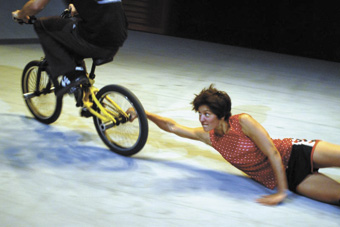
Alexandra Harrison, Paradise City
photo Heidrun Löhr
Alexandra Harrison, Paradise City
IN BRANCH NEBULA’S PARADISE CITY, AN INTENSELY ABSORBING, LYRICAL, NIGHTLIFE STREET CULTURE FANTASIA, A YOUNG MALE TEASES HIS SKATE BOARD INTO AROUSAL. BATHED IN BLUE MOONLIGHT, OTHER FIGURES GRADUALLY ENTER, KEEPING THEIR DISTANCE, CIRCLING SLOWLY UNTIL, LIKE SOME EMERGENT LIFE FORM THEY BECOME ONE, AN ORGANIC BLEND OF SKATEBOARDER, BMX-BIKER, B-BOY, DANCER AND A RISK-TAKING ACROBAT FURIOUSLY SWEEPING AROUND THE PERFORMANCE SPACE.
The whole then quietly dissolves into a series of virtuosic solos, individuals filling in very real time in which slowness is as great a challenge as speed. The bike rider (Simon O’Brien) in near zero motion lifting his bike and himself into slow turning one-wheel stands. The skateboarder (Michael Mulhall) accelerates, riding the ramps at either end of the stage diagonal, hanging above them in long split seconds of suspension.
The board and the bike are prostheses with which their owners are utterly at one, while the vehicles of the dancers’ (Kathryn Puie and Anthony “Lamaroc” Lawang) are their bodies, every walking step fine tuned into subtle moves, precise articulations and sensual ripplings—life is dance. They all intersect and the mood grows playful and then risky as the trickster (Alexandra Harrison) instigates a series of interruptions—leaping onto the moving bike, letting it run her over—and takeovers. Her talent lies in plundering from others the tools of their talent, cruelty delivered with a wry grin as she orchestrates the almost surgical removal of board and then bike from their owners whose deprived bodies, frighteningly limp, slide slowly down ramps, emptied of life and meaning. She likewise removes and wears the clothes of a melancholy singer (Inga Liljestrom) leaving her only her voice and perhaps offering something else as suggested by the langorous mood of the pair’s final moments on the ramp.
<img src="http://www.realtime.org.au/wp-content/uploads/art/2/290_kg_paradise2.jpg" alt="Inge Liljestrom, Kathryn Puie, Michael Mulhall,
Anthony “Lamaroc” Lawang, Paradise City”>
Inge Liljestrom, Kathryn Puie, Michael Mulhall,
Anthony “Lamaroc” Lawang, Paradise City
photo Heidrun Löhr
Inge Liljestrom, Kathryn Puie, Michael Mulhall,
Anthony “Lamaroc” Lawang, Paradise City
Life returns, individuals kick into action, reclaim the tools of their being and their lone, ego-less virtuosities until the street gradually empties in a kind of entropy, the energy of the night wound down in a wave of defeats and little resurgences that mean nothing compared with what has been. Begin again. Branch Nebula’s Lee Wilson and Mirabelle Wouters have created a work of poetic intensity out of everyday play, dance and physical theatre, making the most of oscillations between stillness and action and, above all and magically, of the strange time-space in between. It’s not a big picture work, more a moody, romantic portrayal of a small, intense cosmos. Characterisation is minimal, the bodies do the speaking, though Alexandra Harrison’s devilry benefits from pleasure visibly felt, and Bob Scott’s sound score is satisfyingly enveloping. The ‘paradise’ of the title is at first glance ironic but, despite their occasional falls from grace, this street in this city is mostly heaven for its denizens and for those who espy them. More and more audiences should be invited into this strange paradise.
the whistling man
PACT’s imPACT ensemble production for 2006 bristled with young confidence—strong collective playing, a stark, demanding political vision and a thoroughly integrated design. The effect, economically achieved, was of entering the huge white cube of a conference centre replete with lectern, mike, big screen and mysterious logo, with elaborate media operations boothed to one side. In the squared seating layout came the gradual realisation that people mingled with in the foyer and now sitting next to us were performers, suddenly very edgy citizens not at all happy with, deranged even, by the state corporation merger being sold them in words aptly borrowed from PM Howard. Formalities are constantly interrupted by people who insist on dancing, dropping their trousers, making embarrassing confessions or deviant political commentaries. Audience members are sometimes asked to give up their seats as crowd control swings into action and dissidents are relocated by an apparently benign but increasingly brutal organiser.
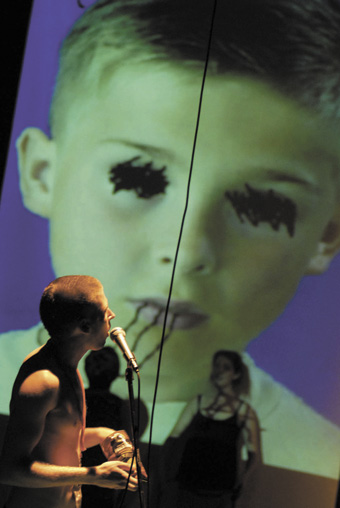
PACT, Whistling Man
photo Heidrun Löhr
PACT, Whistling Man
What played out well in The Whistling Man was a suspenseful sense of impending chaos and the ever increasing vulnerability of those who object to an indiscriminate and irrational application of power, responding with their own apparent madnesses. Bizarre moments of uniformity erupt—sudden line dancing. Abstracted, pixelated faces on the screens gradually form the recognisable shapes of those around us heightening our sense of identification but also the paranoia induced by surveillance, including the spotlight that picks us out from time to time. Where The Whistling Man took us in the end I’m not sure, a climactic rebellion or a collapse into all-dancing dysfunctionality? Had the state’s induced madness destroyed it? Although the overall escalation of intensity was keenly felt, the framing of the corporate gig/conference/rally seemed, its desperately growing oppressiveness aside, to lose its shape and meaning. Perhaps that was the point but it left the performance without the charged political dynamic it initiated. Nonetheless, The Whistling Man had many strengths, not least a much more contemporary multimedia design than usual for PACT, one thoroughly pertinent to the performance’s concerns.
Branch Nebula, Paradise City, co-creator, director Lee Wilson, co-creator, designer Mirabelle Wouters, Sydney Opera House commission, produced by Performing Lines; The Studio, Sydney Opera House, Nov 30-Dec 10, 2006, www.branchnebula.com
PACT Youth Theatre, The Whistling Man, performers 2006 imPACT Ensemble, media designers Spat+Loogie, Teik Kim Pok, sound designer James Brown, set designer Kenzie McKenzie, design mentor Imogen Ross, lighting designer Clytie Smith, movement consultant Chris Ryan, director Regina Heilmann, dramaturgy Bryoni Trezise; PACT Theatre, Sydney, Nov 29-Dec 10, 2006
RealTime issue #77 Feb-March 2007 pg. 44
© Keith Gallasch; for permission to reproduce apply to realtime@realtimearts.net
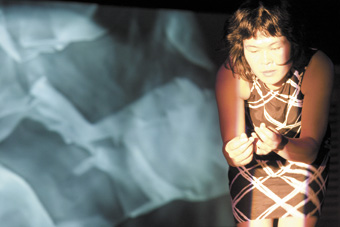
Yumi Umiumare, Impro-lab
photo Mayu Kanamori
Yumi Umiumare, Impro-lab
ALTHOUGH MUSICAL IMPROVISATION CONTINUES TO BE A STRONG PRESENCE IN SYDNEY, THE PHYSICAL AND VOCAL WORK THAT HAD ITS HOME IN THE DEPARTED OMEO STUDIOS IN RECENT YEARS IS NOW LESS VISIBLE. THEREFORE THE IMPORTANCE OF IMPRO-LAB, WHICH FUSES MUSICAL, PHYSICAL AND MEDIA IMPROVISATIONS CANNOT BE UNDERRATED, NOT LEAST FOR ITS INTERNATIONAL CONNECTIONS EMBODIED IN THIS MOST RECENT OUTING WITH THE REMARKABLE VOICE OF VISITING JAPANESE VOCALIST AMI YOSHIDA AND THE SINE WAVE SOUNDS OF SAMPLER ARTIST SACHIKO M.
With these artists, Jim Denley (wind instruments), Chris Abrahams (keyboards) and Amanda Stewart (voice) completed the often dense if subtly realised aural dimension of the second of the Impro-Lab evenings at the Studio. The quiet presence of video artist Samuel James, sitting on the floor of the performance space with cameras, yielded some high impact imagery on two large screens.
Training his camera on small details of the space and slowly manipulating focus and intensity, James created transfixingly radiant abstract images that appeared to have organic lives of their own. They became doubly potent when performers entered their aura: Tess De Quincey locked into a scarily intense quivering, Tony Yap into tight sinuous revolutions, Yumi Umiumare richly expressive against James’ film noirish transformation of the Studio wall slatting into venetian blind-like shadows.
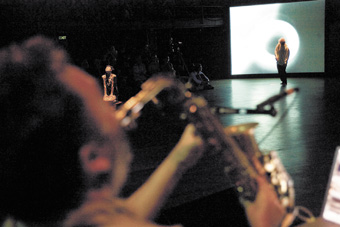
Jim Denley, Yumi Umiumare, Tess de Quincey, Impro-lab
photos Mayu Kanamori
Jim Denley, Yumi Umiumare, Tess de Quincey, Impro-lab
In the bravest flight of the night, Umiumare, like a figure straight out of Magritte, danced at length with a boot placed on her head. Of course, improvisation is by nature a hit and miss affair: the night’s two performances had their fine moments, mostly appreciated in the detail rather than as a large scale collaborative venture, with some occasional turn-taking tentativeness evident. Yoshida aside, whose croakings and squealings emanate alarmingly as if from a body possessed or diseased, the musicians were in danger of appearing to be playing an accompanying role. Jim Denley nonetheless provided a rich and vivid continuo. Although greedy for something more palpable from Abrahams and Stewart, I was nourished by many moments in the performances and was particularlytaken with the successful integration of live video.
live cinema
I asked Sam James to describe his approach to working on Impro-Lab. He wrote that he used three live cameras attached to a vision mixer which could mix between any two found images. He “wanted to keep it all analogue” to be authentic to the environment and to the improvisation: “Because of the difficulty or the vulnerability of using three lenses with different qualities and without effects there was a truthfulness to the space and the performance.” James prefers doing what he calls “live cinema” instead of working with a laptop and pre-recorded imagery, where he sees an “artificial impression of realtime image creation.”
James clearly enjoys the spontaneity of his approach: “With the live camera, as something happens the camera operator’s response is immediate and sometimes impulsive, and often much of the strain of the work is controlling the immensity of the outcome. It’s a very sensitive medium to use for live projection…there’s a visceral response with camera movement, control of focus, exposure and zoom to the immediate sound and physical environment…I see what’s there with each of the cameras and the images begin to feed off each other, creating a kind of transcendence, of the sum of the space.” James is determined to continue working this way after a year of part-time development of the approach and working with experienced improvisors.
Improvisation sometimes seems to come out of nowhere. However, at its best it’s the expression of relationships between artists who have worked together for extended periods and are highly reponsive to each other. Impro-Lab came of out of such contact with an intensive program of laboratories and residencies held in Japan and Australia in 2006 involving Asialink’s Neon Rise program, Perth Institute of Contemporary Arts and Critical Path in Sydney.
DeQuincey Co and Machine for Making Sense, Impro-Lab: Transparencies, dancers Tess de Quincey, Peter Fraser, Yumi Umiumare, Tony Yap, musicians Chris Abrahams, Sachiko M, Jim Demley, Ami Yoshida, Amanda Stewart, video Samuel James, lighting Clytie Smith; Australia-Japan Year of Exchange; The Studio, Sydney Opera House, Nov 25
RealTime issue #77 Feb-March 2007 pg. 45
© Keith Gallasch; for permission to reproduce apply to realtime@realtimearts.net
<img src="http://www.realtime.org.au/wp-content/uploads/art/2/294_inhouse_claire_sean.jpg" alt="Primary Producers, Sean Cordeiro and Claire Healy’s
oyster shucking picnic
“>
Primary Producers, Sean Cordeiro and Claire Healy’s
oyster shucking picnic
courtesy of the artists
Primary Producers, Sean Cordeiro and Claire Healy’s
oyster shucking picnic
ON FEBRUARY 25 PERFORMANCE SPACE BEGINS A NEW LIFE, SINGING ITSELF INTO BEING IN ITS NEW HOME AT CARRIAGEWORKS WITH A FREE PROGRAM, “A CHORAL HOUSEWARMING TO CALL IN THE NEXT ERA.” THE WELCOMING WILL MAKE THE MOST OF THE NEW SPACE, INCLUDING THE MASSIVE MAIN FOYER WITH ITS HIGH BALCONIES AND MACHINE RELICS FROM ITS RAILWAY DAYS.
The opening performance season is a strong one featuring William Yang’s latest work, China, acrobat’s Smaller, Poorer, Cheaper (RT 76, p42) and Martin del Amo’s new work, Never Been This Far Away From Home. The visual arts program likewise promises much with new works by installationists par excellence Sean Cordeiro & Claire Healy (a site-specific work onsite at CarriageWorks) and media artist Denis Beaubois.
martin del amo
Of German and Spanish heritage and trained in Japanese dancing arts of Butoh and Body Weather, Martin Del Amo has become a key figure in the Sydney dance scene. He was part of the 2006 Breathing Space tour of the UK and recently returned to the UK to perform again at Arnolfini in Bristol. Any del Amo work is bound to impress with its blend of intimate direct address and compulsively expressive dance propelled by an autobiographical impulse. For Amanda Card, writing about the dancer for Performance Space, he summarised his recent works: “My three earlier solo pieces investigated the direct physical and psychological impact of certain forces…In Unsealed (2004) I explored the destructive potential of loneliness. The threat of physical extinction was a theme in Under Attack (2005) and the relationship between trauma and obsession was key in Can’t Hardly Breathe (2006).”
We asked del Amo to reflect on the motivation for his new work. He wrote back, “Early in 2006, when starting to think about ideas for a new solo show, I found myself in the UK. It was very cold while it was very hot here. I was missing out on Sydney summer and I wasn’t happy about that. Feeling rather melancholy and slightly homesick, I went into a Virgin Megastore in Manchester. The song that was playing when I entered was extremely insistent and impossible to ignore as it repeated over and over: “Oh my God, I can’t believe it—I’ve never been this far away from home.” (Later I learned the song was Kaiser Chiefs’ “Oh My God.”) …Somehow the line not only reflected what I was feeling at that moment but also seemed to encapsulate the thematic territory I wanted to explore in my new show. My personal circumstances in the last five years (relocating from Berlin to Sydney, touring nationally and internationally) have heightened my awareness of notions of ‘home’, not only as a geographical location but also as an emotional and psychological state.”
The opposite to home is the unknown. But, what, wonders del Amo, is unknown these days: “All the blank spots that once existed on maps have been filled.” However, “Outer space, the ocean floor and underground are the new frontiers. And then of course there has also been the advent of what might prove to be the ultimate, uncharted territory—cyberspace, an incomprehensibly vast, inexhaustible playground for all intrepid adventurers and tireless explorers.”
Venturing into the unknown, says del Amo, “almost always means …one is soon faced by situations and conditions previously unimagined and unexpected. New rules apply, and formerly trusted survival strategies are no longer valid. What happens then?”
Just what unknowns del Amo and his audience will face in Never Been… remain to be seen, but the artist gives us some clues: “Spoken texts featured in the show include musings on the impenetrability of borders both real and imagined, a story about a mysterious white room in which objects appear according to rules unknown to the storyteller, and advice on how to escape from crocodiles.”
The other dimension to this unknown is, of course, making and showing the work. Del Amo commented to Amanda Card that “The very act of making a solo takes you ‘far away from home’, out of your comfort zone. Each new work and each performance must establish a relationship with a new place or a new audience…A solo work is the most direct and undiluted way of making work. The contract between a solo artist and their audience is very clear. …(You) are asking your audience for their undivided attention, but this attention has to be earned.”
For Never Been This Far Away From Home, Martin del Amo will be joined by regular collaborators Gail Priest (composer and live musician), Clytie Smith (lighting designer) and Virginia Boyle (costume designer) with Branch Nebula’s Mirabelle Wouters joining the team as set designer.
and much more…
Sydney rock oysters are still one of the city’s great pleasures although these days harvested far away. The first settlers found on arrival mountainous middens of shells left from hundreds of years of Aboriginal feasting, the lime from which soon became the mortar that long cemented the growing city’s buildings. Sean Cordeiro and Claire Healy will, with helpers at a picnic at CarriageWorks on February 24, begin to shuck into shape a sculpture evoking this history in their new work, Primary Producers. It’s the first in a series of site-specific works curated by Performance Space Associate Director Sally Breen. There’s certainly a lot of site at CarriageWorks to get specific about in the future.
In Denis Beaubois’ The Terminal Vision Project the artist screens images from a small wireless camera dropped from a tall building: “The work explores the links between remote viewing and physical reality (passive consumption and experience).” Beaubois’ previous creations have included witty and insightful takes on surveillance as in his In the Event of Amnesia.
In his latest work China photographer-performer William Yang, born and raised in Australia, visits his cultural homeland, narrating the encounter to a score for erhu played live by Nicholas Ng. Smaller, Poorer, Cheaper offers a rare opportunity for Sydneysiders to see the famed acrobat with their highly skilled, stripped back performativity. The launch of media arts DVD label, demux, plus the first of a series of short works showings, Night Time #1, along with a number of residencies signals a fully functioning Performance Space, home at last.
The first Performance Space program at CarriageWorks provides a brisk, strong start to a new beginning with inventive, accessible works. This will doubtless be a period of adjustment: for artists and PS audiences one of new comforts, the opportunity to really focus on the work and also to reach out to many newcomers. RT
Performance Space, www.performancespace.com.au
RealTime issue #77 Feb-March 2007 pg. 13
IN THE MANY WARS OF THE LAST HUNDRED YEARS—FROM WORLD WARS TO COLD WARS TO CULTURE WARS TO WARS ON REFUGEES, ON TERROR AND IRAQ—HOW HAS PERFORMANCE RESPONDED TO INTERNATIONAL AND CIVIL CONFLICTS? WHEN WAR USES THE TERM ‘THEATRE’ TO DESCRIBE ITS AREA OF OPERATIONS AND EFFECT, HOW MIGHT THEATRE EXAMINE THE FALLOUT OF WAR?
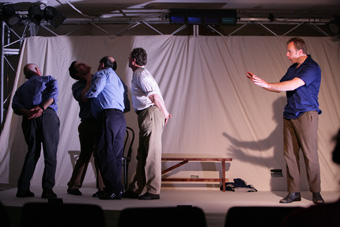
Chris Pitman and cast, Maralinga
photo Dawne Fahey
Chris Pitman and cast, Maralinga
Fallout, a day-length symposium investigating the intersections of theatre and war, aimed to analyse a range of performance practices operating within this territory, framed by questions of the ethical imperatives, political efficacy, logistical challenges and the aesthetic innovations of these practices.
Originally convened as an opportunity to reflect on Maralinga, a long-term interview-based verbatim theatre project by Paul Brown and collaborators, Fallout was expanded to draw together artists and scholars from Australia and the UK to discuss and debate a number of artistic projects in both countries that take war as their subject. These ranged from Australian works like Ngapartji Ngapartji, Through the Wire and The Wages of Spin, to the work of British companies such as Ice and Fire and The Exodus Project, sound artist Louise Wilson’s atmospheric audio interventions into abandoned military research sites in Scotland and the work of the Manchester University-based research project In Place of War, now in its third year.
“That Maralinga should be classed as a war zone struck me in the face”, said Paul Brown in his introductory remarks, but that it made sense as a “Cold War zone.” Far away, on the fringe of its former Empire and thanks to meek Australian compliance, Britain was able to flex its nuclear muscles, to demonstrate that it too was a force to be reckoned with in the new world order. Maralinga, recently shown as a work-in-progress at the Ettalong Beach War Memorial Club on the NSW Central Coast, confronts official blanket secrecy and denial by seeking unofficial, often anecdotal accounts from ordinary soldiers in extraordinary circumstances. The play distills interviews with a large number of British and Australian servicemen who worked on the tests between 1952 and 1967, most often young men off for the adventure of a lifetime, who had no notion of what they would be exposed to, and whose primary function in many cases seemed to be as guinea pigs—to discover not only the health effects of the tests, but also how soldiers might psychologically cope with and begin to normalise the atomic battlefield of the future. Fallout convenor James Arvanitakis remarked of Maralinga that it was an act of “highlighting broken bodies, and how they broke.” Not being the bearers of stories of glory and triumph, atomic test veterans have faced painfully extended battles with military and government authorities that continue to deny claims for compensation, partly on the basis that the soldiers were not deemed to have served in a war.
James Thompson, Alison Jeffers and Jenny Hughes discussed the work of In Place of War, appearing live from Manchester via video streaming. The project examines performances that occur within war zones, triggered by Thompson’s experience of working in war-torn Sri Lanka, where anthropological literature declared that no performance was occurring, despite this clearly not being the case. Much of the work of In Place of War examines performance being created by and for survivors of civil strife, both within the war zones themselves and in countries of refuge such as the UK. There were obvious links here with the recent explosion of refugee-themed ‘verbatim’ or ‘documentary’ theatre in Australia, explored elegantly by Caroline Wake. While Alison Jeffers’ paper focused on the performances that refugees themselves must produce in order to be recognised by state authorities as legitimate refugees, Wake focused on the ways in which refugee witnessing has been redeployed in recent examples of Australian theatre. As Paul Brown noted cautiously, “truth surrounds verbatim, but it would be a mistake to think that verbatim theatre is any more truthful than any other form of theatre.”
2006 marked the fiftieth anniversary of the Maralinga tests. As the United States agrees to provide India with nuclear technology, covers munitions with radioactive ‘depleted uranium’, and begins developing a new range of ‘safe’ battlefield nukes and while Australia scrambles to satisfy China’s appetite for uranium and actively courts nuclear power as a ‘realistic’ and ‘clean’ answer to global warming, it is difficult to ignore the spectre of the Maralinga tests and the death, dislocation, and destruction they produced. As such, forums like Fallout act as both timely reminders of buried histories of injustice and as opportunities to gather critical mass to resist such atrocities recurring.
Fallout: A Symposium of Politics and Performance, convenor James Arvanitakis, School of Media, Film and Theatre, University of New South Wales, Nov 22 2006; Maralinga. www.nucleartheatre.org; In Place of War, www.inplaceofwar.net
RealTime issue #77 Feb-March 2007 pg. 46
© David Williams; for permission to reproduce apply to realtime@realtimearts.net
CHOREOGRAPHER/DANCER EMIO GRECO AND DIRECTOR/DRAMATURG PIETER C SCHOLTEN HAVE A CREATIVE CHARTER THAT LOOKS TO THE BODY AS THE PRIMARY SOURCE FOR DRAMATURGICAL CONTENT. DOUBLE POINTS: ONE & TWO IN THE SYDNEY OPERA HOUSE’S ADVENTURES IN THE DARK PROGRAM WAS INDEED AN EXCITING EXAMPLE OF DANCING BODIES TAKING CENTRESTAGE, AND IT WAS SURPRISINGLY NOVEL TO SEE A MAJOR DANCE PERFORMANCE IN SYDNEY THAT CONCENTRATED ITS FOCUS ON CHOREOGRAPHY. MINIMAL DESIGN ELEMENTS, WITH THE EXCEPTION OF STRIKING SCORES AND KNOCK OUT LIGHTING DESIGN, PROVIDED JUST THE RIGHT SUPPORT FOR GRECO’S SOLO AND A DUET BY SUZAN TUNCA AND VINCENT COLOMES.
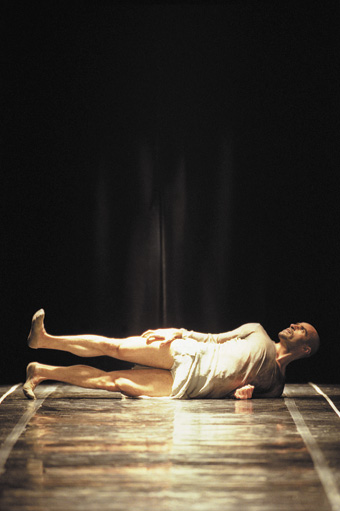
Emio Greco, Double Points: One
photo courtesy Sydney Opera House
Emio Greco, Double Points: One
The medium-sized stage space of the Playhouse, with wings open, was modelled by light and finely articulated dance, the direct address of the performance fiercely established by the first solo. Greco appears upstage at the end of a corridor of light, like a straight stretch of highway connecting dancer and audience. The pathway is marked off with white lines so that the dancer’s movement outside this, when it inevitably comes, is somehow shocking as if he is moving into a void. Pools of light travel down the corridor to Greco who plays with the light, thrusting an arm to be seen.
The score, Ravel’s Bolero, doubles the visual thrust of the stage design. Greco’s slow build is hypnotic, the slithering and contained movement centring in the pelvis then with ballet arms and legs that can’t quite find the position, deep and somehow threatening second plies and rushes forward to the audience. I can’t help recalling Sylvie Guillem’s ridiculous performance to the same score at another Sydney festival with choreography by Maurice Bejart and the Australian Ballet male corps circling the ballerina high on a rostrum and thrusting their pelvises to the beat. The sexual intensity of Greco’s performance is both central and undermined; the end of the Bolero score is suspended as silence interrupts the climax and the sound of violent fireworks fills the space.
After the final, delayed notes of Bolero, Greco leaves the light to sit on a chair in a dark corner and Tunca enters at the back, loitering, facing upstage and off-centre. A sumptuous amber swimming pool of light forms, shifting and pulsing in dramatic contrast with the formal and ‘masculine’ lighting of the first state, the hard corridor rippling up and down the stage. The lighting prepares the space for a complete change in choreographic mood. Tunca balances on one leg, shifting the other around in the air. Greco cuts wildly across the stage, ‘upstaging’ her in the most blatant way, then leaves. Another male dancer, Colomes, enters and the duet begins.
The two dancers move together with the precision of birds in flight and this metaphor is cemented by bird-like gestures and calls in the score. The twitching, erratic, intimate movements shift into frenetic phrasing or mad spectacles—arms swinging around like synchronised motors. Then they seem suspended together downstage, as if the air has been sucked up and out of them. But there is constant movement in any of these states and the unison is breathtaking given the general fever pitch of their delivery and the physical differences between the two (Tunca towers over Colomes).
These works are some eight years old and yet seem so incredibly fresh, combining an intensely passionate delivery with wonderfully precise form. It has been a long time since I have seen a dance performance conjure such a rich world of invisible desires, forces and impulses, with so few exterior cues and such genuine physical bravado. Here’s hoping the Adventures in the Dark in dance continue.
Emio Greco | PC, Double Points: One & Two, choreography, direction, lighting, set and sound concept Emio Greco and Pieter C Scholten, dancers Emio Greco, Suzan Tunca, Vincent Colomes; Playhouse, Sydney Opera House Nov 21-Dec 2, 2006 www.emiogrecopc.nl/public
RealTime issue #77 Feb-March 2007 pg. 37
© Erin Brannigan; for permission to reproduce apply to realtime@realtimearts.net
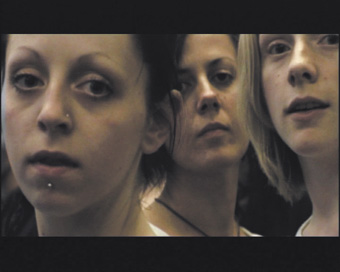
You Made Me Love You
A TREND TOWARDS THE CONCEPTUAL AND THE INFLUENCE OF PRACTICES ASSOCIATED WITH THE VISUAL RATHER THAN THE PERFORMING ARTS WAS EVIDENT THROUGHOUT DANCE ON SCREEN, THE PLACE’S FESTIVAL OF SCREEN-BASED MOVEMENT, MIRRORING A SHIFT WITHIN THE SCREENDANCE WORLD AS A WHOLE.
The festival’s core programme of International Screenings was co-curated by Videoworks manager Gitta Wigro and Sarah Wood, with the latter having moved to screendance from a background in programming moving image works by visual artists.
As the festival last appeared in 2004, the two-year hiatus provided the opportunity for the screendance community in Britain to see how the form has progressed by reflecting on the range of activity on offer at this year’s event.
The six day programme of events opened with a masterclass screening, showcasing work created in a single week under the guidance of director Katrina McPherson, winner of the IMZ Dance Award, Monaco. McPherson emphasised the creative potential inherent within an improvisationally slanted approach and the desirability of placing movement content at the heart of dance work created for the screen. These thematic concerns were particularly well served in the ambitious layering of movement material and dialogue in Jemima Hoadley’s Red/White (2006). McPherson’s own work was also present throughout the week in the form of the ultra high concept Move-Me booth, co-originated with Simon Fildes, and co-produced by Ricochet Dance Productions, where anyone brave enough to venture inside could create their own recorded interpretations of choreography by, among others, Rafael Bonachela; Deborah Hay and Stephen Petronio.
Away from the main screening space, engagement with the conceptual was strongly in evidence as a strand of festival programming with installations in the form of choreographer/director Heather Eddington’s precision editing projected against Nyanda Yekway’s stark white sculptural environment in Curious, and Mark Dean’s Goin’ Back (The Birds/The Byrds x 32 +1, UK, 1997). In this hypnotically minimalist reworking of a close-up from Hitchcock’s The Birds, Tippi Hedren’s horror-stricken face moves continuously forwards then backwards from a barely perceptible rocking breath rhythm to an anguished semaphore of self-protective arm waving. Another striking convergence of the choreographic and the conceptual was evident in 365 Days—Reijo Kela’s video diary of 1999. The eponymous Finnish director/choreographer recorded his physical journey through the frame for (almost) each day of the year, playfully exploring and developing a movement vocabulary of hopping, rolling and running through a variety of locations and settings, involving a range of good-natured, if somewhat bemused, bystanders.
The festival’s Living Room area provided a library facility to view all submitted works, catch up with familiar faces and watch the One Minute Wanders program, with each piece rising to the challenge of time constraint to deliver a series of small marvels. Claudia Kappenberg’s Long Wave (UK, 2006) made use of archival footage projected on to the single female performer’s naked back. The simplicity and economy of the idea allowed access to an intimate world of texturally layered and body-based memory and association, with the undulatory movement of the figure echoing the journey of a giant sphere as it hugged the curve of a hip and rolled along the length of the spine. Mavin Khoo (UK, 2006), directed by Hazuan Hashim and Phil Maxwell and choreographed by Khoo himself, made strong use of a range of compositional elements. With the lone performer in silhouette against a riverscape location, the framing emphasised the verticals of the moving figure and the skyline set against the constant horizontal of the river and interweaving the peal of city bells with the ethereality of a counter tenor’s voice. In Caps (France, 2006), directed by David Olivari and choreographed by Karl Paquemar, a trick of perspective is played on the viewer. A seemingly flat, graffiti-covered surface is revealed as a space housing concealed entrances and exits and a frame-within-a-frame as two men enter, playing out an intense encounter using the movement language of supported fall and recovery with sudden shifts of positioning and dynamics visible against the outer and inner edges of the screen space.
Within the festival’s International Screenings, the trend towards the conceptual was particularly apparent in Miranda Pennell’s You Made Me Love You (UK 2005) in which a group of teenage performers are filmed as a sea of faces, filling the frame, locked on to and following the single take, studio set, stop-start journey of the camera like a shoal of particularly attentive fish. The piece’s minimalist movement vocabulary of walking, stopping, turning and swaying is suggested mainly by the sound of moving feet and sudden silences as the striving to maintain an unbroken relationship of performer gaze to camera/viewer becomes the central focus of the work.
Catherine Maximoff’s interpretation of Russell Maliphant’s choreography in Voyage (France, 2006) demonstrated that the particular skills necessary to translate stage-based dance work to screen require to be categorised as a specific choreographic practice in their own right. The work achieves a balance between the use of wide shots to reveal the whole body, thus recreating the live viewing perspective, interspersed with more intimate closeups, providing a sense of quietude and interiority. Sequences are filmed from alternating perspectives, contrasting front and back views, and music with ambient sound. A contact duet is filmed from above, intercut with extreme closeups of near abstracted torsos and arms, punctuated by the sound of the dancers’ breath.
In Match (Ireland, 2006), directed by Dearbhla Walsh and choreographed by Fearghus O’Conchuir, the camera functions almost as an extra performer, transforming an intensely physical contact duet into a trio by the extent of its choreographic engagement. Location is also used to strong effect, as Ireland’s (deserted) national stadium provides an epic spatial arena and a charged cultural context for a male-to-male encounter exploring combat and competitiveness, with moments of tenderness and physical intimacy ultimately transcended by the will to win. The camera work mixes aerial shots with extreme close-ups, capturing an interlocked grappling of arms from beneath and following the trajectory of a movement arc with as much physical intensity as the performers themselves.
The festival concluded with Next Up, curated by Wigro and IMZ winner Rachel Davies, presenting a new generation of screendance practitioners and where conceptually driven work again left the strongest impression. Maya Deren wrote that reverse motion can be used to convey the impression of “an undoing of time”, and in Jan Steinum’s Highway of Love (Norway, 2006), a patterned tracery of footprints visible on a flat, snow-covered rooftop were gradually and magically erased by the backwards journey of a single male performer wearing red patent thigh boots and little else, carefully cradling a dance partner in the form of a blow-up doll. In Philippa Thomas’ Electric Desert (UK 2006) the superimposition of motion-blurred Las Vegas neon over black and white footage of a young male transvestite created a memorable and otherworldly visual landscape. Manipulating a Loïe Fuller-like outfit of billowing white sheets, the central figure’s face, revealed in extreme close-up, appeared to follow the progress of the coloured lights, and the absence of sound served to place the work outside of a conventional linear timeframe, drawing the viewer into a heightened experience of visuality.
Bill Viola wrote of the shift in popular perception accompanying the realisation that “the twentieth-century artist is not necessarily someone who draws well, but someone who thinks well.” Dance On Screen 2006 provided ample evidence that in the 21st century the screen can function as a site of expression for dance film practitioners who think well too.
Dance on Screen Film Festival, The Place Videoworks, London, Oct 30-Nov 5
www.danceonscreen.org.uk
RealTime issue #77 Feb-March 2007 pg. 35
© Chirstinn Whyte; for permission to reproduce apply to realtime@realtimearts.net
IN NOVEMBER OF 2006, I FOUND MYSELF IN AN EXTRAORDINARY PLACE. I WAS STANDING ON A DUSTY MOUNTAINSIDE IN NORTH WEST ARGENTINA, AND I WAS PRACTISING LOOKING. THERE WAS A HUGE VIEW AHEAD OF ME: LAYER UPON LAYER OF MOUNTAINS, THE FURTHEST PEAK CAPPED WITH SNOW. I WAS TINY, LIKE A SPECK OF DUST. THE SKY WAS FALLING AND AS I LOOKED, I FELT I WAS RISING AND NOTHING MATTERED. AND EVERYTHING MATTERED.
I could feel the wind on my skin, and hear the silence, and taste the salty tears that were suddenly running down my face. This was one moment in a month-long screen dance research period. I’ll rewind a bit and tell you how I got there.
Exactly one year earlier, I had visited the Festival Internacional de Videodanza de Buenos Aires, to teach a workshop and to present my work. On arriving back in the UK, I was offered the opportunity to return to Argentina on an Arts Council of England international research fellowship. The fellowship was supported by two organizations—South East Dance Agency based in Brighton, England (my home town), and VideoDanza BA in Argentina. They decided to extend the project by offering research time to two Argentinean artists, filmmaker Alejandro Areal Velez and choreographer Sophia Mazza, who both worked on separate research projects. We all came together to share our experiences during the 2006 Videodanza festival in Buenos Aires (Nov 28-Dec 3). These discussions were mentored by Brighton-based screen dance artist Magali Charrier.
At the outset I was asked to write a statement of intent regarding the parameters of the research and it seemed vital that I should engage with something in Argentina that I could not have access to in the UK. Coming from the cluttered and crowded environment of South East England, I proposed going to the huge, open, empty spaces of Argentina. I wanted to explore the possibility that my own creativity could be affected by unfamiliar textures, colours and scale, and that my own sense of real space and time, and recorded space and time, could be influenced by the geographical space that I work in. This was the starting point from which I wanted to explore a sense of the macro and micro, in terms of landscape, body in landscape and movement in relation to distance. This is how I found myself on this incredible mountainside.
Silvina Szperling, director of the Videodanza Festival, found me two perfect travelling companions—photographer Alejo Schatzky and dancer/videomaker Paula Zacharias, and together we travelled through salt fields, across mountains, through forests of giant cacti, over vast plains and past enormous, crumbling glaciers.
Some of the research that I undertook investigated my physicality in relation to the environment, and how awareness of it could affect my camera practice. My interest in combining video and dance practice is informed by a physical curiosity. I had questions regarding vision and habits of looking. How long can I look before I look for something, before I make judgements based on taste and aesthetics? By paying attention to my looking, will I see more? Will I see differently?
Then I found myself searching for the work that was specific to each particular environment. Dance (in its formal and theatrical sense) can seem inappropriate when placed within a non-theatrical setting. Yet in some spaces, we would chance upon happy accidents, when Paula would move and the light and the heat and the dust and the camera settings would combine with that movement to create dances in which the lines between the body and its surrounding environment became porous.
The movement that I requested from Paula was based around quite practical tasks. For example, “Move the dust with your feet and hands”, and Paula would interpret as she saw fit. Now I have this material in an edit suite, I find that the answer to my questions to do with placing the dancing body in a landscape is to remove the body entirely, and just leave the dust mysteriously lifting and falling. I look at footage of Alejo swimming in a roadside pool. I made a choice to shoot it out of focus. It looks smudged and although it is clear that something is disturbing the landscape, it is impossible to identify exactly what landscape and what is disturbing it. Instead we see an abstract dance of colours and flecks of light.
It remains a puzzle to me—the invention and placing of dance in the landscape—yet I am interested in some of the footage that resulted from the attempt to solve the puzzle for myself. I hope that the footage will be showing up in some form at screen dance festivals in 2007.
On returning to Buenos Aires, it became clear that Alejandro, Sophia and I had all approached this question of research in very different ways. Alejandro had set up a video shoot in order to explore questions of “connection and disconnection” in human relationships. He will edit his footage into a 12 minute film. Sophia was working with filmmaker Cayetana Vidal to explore a narrative they had invented that was set in a swimming pool. We found ourselves discussing the nature of research. How do you know when you have stopped researching and started doing something else? When does that ‘something else’ become ‘production’?
Maybe in an ideal world we could all place our work in the context of research, all of the time, in order to give ourselves the safety net of failure. On the occasions that I have not named my work ‘research’ I can find myself disappointed by the outcome. I take fewer risks, because of my perceived need to succeed, and therefore the work can fail to surprise or delight me.
Our conversations spilled out into the public domain of the festival, as all three of us were asked to make presentations on the work that we had undertaken. I realised that it is rare to have showings of work in progress or discussions regarding research or process at screen dance events, although these are common within live dance contexts. In screen dance it can all seem set and final. Done and dusted.
The value of a trip such as this is clear—if art imitates life, then it is essential that artists have a life for their art to imitate.
If you engage with travel, you will arrive.
Ibn Arabi
To view an online blog from the artists and organisers of this project visit http://southeastdance-buenosaires.blogspot.com/
RealTime issue #77 Feb-March 2007 pg. 36
© Becky Edmunds; for permission to reproduce apply to realtime@realtimearts.net
Dear RealTime,
I just wanted to let you guys know that The Fromagerie will be closed after the end of February, and that The Old Flour Mill Building as it is will be no longer after March 15. We will be running a 3-night extravaganza March 1-3 to celebrate what the space was and mourn its passing. It’s called Past, Present, Future (one for each night).
Rosalind Crisp founded the space as Omeo Dance Studio in 1996, and after her move to Paris, The Fondue Set took over in late 2005 renaming it The Fromagerie. I think the closure will come as a big loss to the Sydney dance scene. The list of people who have worked in the space over those 10 years is massive. It has always served as a place where people can practice or perform works without curation or application forms. I suppose I'm also wondering about how the loss of a space like The Fromagerie impacts on the huge deal of the CarriageWorks.
The Fondue Set are going to attempt to look for another space, but we think it will be difficult to find somewhere so local, big and cheap and with a similarly lovely and supportive landlord. We will try! I was recently in Berlin (through a Goethe Institut Stipendium), where I attended a forum on studio spaces for dance in which people were lucky enough to be able to talk about an ideal. I came back full of enthusiasm for what our space could become, only to be faced with our eviction notice… This is the reality in Sydney! We will send on further information about Past, Present, Future very soon with open invitations for everyone who has ever performed there to be a part of it.
Jane Mckernan
for The Fondue Set, Sydney
RealTime issue #77 Feb-March 2007 pg. 36
© Jane Mckernan; for permission to reproduce apply to realtime@realtimearts.net
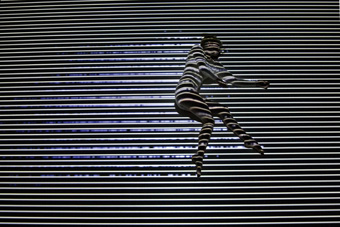
Kristy Ayre, Glow, Chunky Move
photo Rom Anthonis
Kristy Ayre, Glow, Chunky Move
“Utilising the latest in interactive video technologies a digital landscape is generated in real time in response to the dancer’s movement. The body’s gestures are extended by and in turn manipulate the video world that surrounds it, rendering no two performances exactly the same.” Chunky Move
Glow is an intimate, 26-minute virtuosic solo dance work that excited Melbourne critics and audiences with its magical ‘biotech’ evocation of the human body as an evolving creature. The work, created for Chunky Move by artistic director Gideon Obarzanek and German interactive software creator Frieder Weiss with music and sound design by Luke Smiles, offers audiences, looking down on the dancer, the chance to experience the very latest in the perceptual interplay between artist, technology and audience. Glow is part of The Studio’s program for the first half of 2007 which also includes Meow Meow, Unreasonable Adults, Yumi Umiumare and Antje Pfundtner.
–
Chunky Move, Glow, The Studio, Sydney Opera House, March 21-25
RealTime issue #77 Feb-March 2007 pg. 36
© RealTime; for permission to reproduce apply to realtime@realtimearts.net
AS I SIT IN MY BRIGHT-BOX, DAY-LIT ROOM, LOOKING OUT ON THE GREENERY OF THE GARDEN, I DO WHAT ALL REVIEWERS DO: REFLECT ON THE SPACE BETWEEN THE LIFE WE LIVE AND PERFORMANCES WE SEE. LIKE ALL THINGS OF SIGNIFICANCE, THE PIECE I’VE SEEN ALMOST BY CHANCE, BY A RARE ACT OF GRACE AT THE AUSTRALIAN CHOREOGRAPHIC CENTRE, QUESTIONS AND SEWS STITCHES BETWEEN ONE PLANE AND ANOTHER, BRIGHT-BOX TO BLACK, OUTSIDE TO INSIDE HOURS.
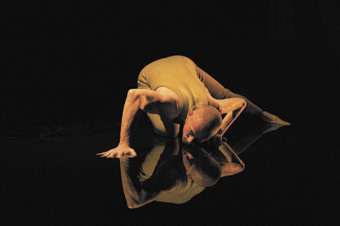
James Cunningham, Mirage
photo Suzon Fuks
James Cunningham, Mirage
I remember Mirage as an act of bravery, which begins with the challenge of remapping the scope of movement after serious injury. It ends as a gift—a message of potentials and transformations. A deep reflection on human re-creative capacity.
James Cunningham, a dancer who initially trained in Adelaide in the late 1980s, almost totally paralysed his left arm in a motorcycle accident in 1992. In many ways, Mirage is the culmination of his search to restore both self-identity and movement capability, but as a theatrical experience it amounts to much more than this narrative journey.
The company Igneous, formed in 1997 by the partnership of Cunningham and Suzon Fuks, a Belgian multi-disciplinary artist, has produced several major works and showings. Moving from their pivotal productions, Body In Question (1999) to Thanatonauts: Navigators of Death (2003-4) and Liquid Skin (2005), dance video works and international workshop collaborations, Mirage bears witness to an evolution and maturing of their practice, and the transformation of the idea of “the body” as a singular site and subject.
Body In Question housed the emotionally moving narratives of accident and recovery. Cunningham’s personal story was written like a diary on the video-screen. His manouevrings of a life-sized puppet, unfolding from his knapsack, seem now to be preliminary investigations into the way mind and body form and re-form through processes of mirroring, unfolding and re-patterning.
Mirage takes those ideas into a more abstracted realm that is paradoxically even more immediate for the viewer. This is the extraordinary contradiction of arts practice: the deepest re-patternings, interior to the body are individual yet also profoundly transcendent of personal story.
Alison Ross’s installation design houses a mirror-pool. Cunningham’s body and joints kiss water as his movements recount the journey from paralysis through mirroring back into movement. This is the principle of the mirror-box, a discovery of neurologist Vilayanur Ramachandran: through mirroring what still moves, the body can unparalyse. This restorative process both questions the “reality” of permanent injury, as well as the “reality” of the body. If an act of looking can re-move permanent paralysis, is the body’s self-identity thus also an illusion, a mirage? Glimmers in the water multiply the performer, but also catch the lookers looking. The meshed pyramid which Cunningham lifts and manoeuvres is a strange prop—a prophylaxis, rather, serving as screen for projected body-images, sometimes also a hiding-cave, also an MRI machine, but always more than any of these. Critically, the multiplied images reflect on another of Ramachandran’s discoveries: that the capacity to reach across sense-impressions (synaesthesia) is the very element that helps humans to evolve, to move beyond what is. This is where Mirage critically, joyfully perhaps, reflects on the deepest artistic and neurological recognitions.
There is thus a significant transformation of the dualistic self/other, puppet/dancer relationship of Body In Question to a triangular relationship between I/you/the transcendent or in-between. Sound artist Andrew Kettle points to hermetic traditions (specifically, the Tabula Smaragdina: “The Stone is One . . . out of one substance the Sages obtain our remedy”) and the significance of metaphysics to his compositional process. His contribution is “a tonal meditation on anatomical measurements of the dancer’s body transmuted through prayer.” No sound is literal, and yet one senses the bodily form out of which the composition has evolved. Visually, Morgan Randall’s lighting design allows the performer’s body to dissolve and re-solve. Alchemical re-making.
At its heart, this is a work that actually cares for and about the body, for and about the performer, but also the spectator/audience, and in a larger sense, the human condition, allowing for the fact that seeing, listening, witnessing, are themselves alchemical processes. I felt an exhilaration in watching this work.
And that rare experience: what it costs to watch, and think and be in watching, is rewarded by a message much larger than the performance.
Igneous, Mirage, dance performance and installation, directors Suzon Fuks, James Cunningham, performer, choreographer James Cunningham, video artist Suzon Fuks, set design Alison Ross, sound artist Andrew Kettle, lighting Morgan Randle; Australian Choreographic Centre, Canberra, Nov 16-18, 2006. www.igneous.org.au
RealTime issue #77 Feb-March 2007 pg. 37
© Zsuzsanna Soboslay; for permission to reproduce apply to realtime@realtimearts.net
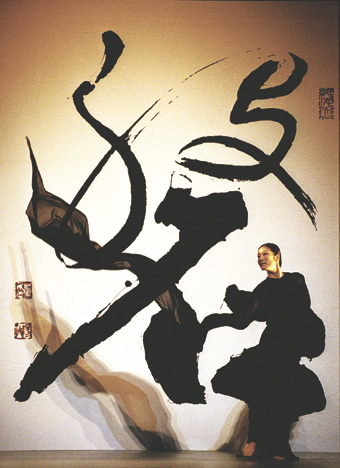
Cursive, Cloud Gate
photo Liu Chen-hsiang
Cursive, Cloud Gate
TWO TERMS EMERGE WITH PARTICULAR PROMINENCE WHEN TALKING TO CHOREOGRAPHER-DIRECTOR LIN HWAI-MIN ABOUT HIS TRILOGY DEALING WITH CHINESE CALLIGRAPHY, CURSIVE, CURSIVE II AND WILD CURSIVE. THESE ARE “BREATH” AND “SPACE.” THE EXPANSION AND CONTRACTION OF THE BODY AND OF SPACE, OF VESSELS FILLED WITH ENERGY AND EMOTION AS THEY SWELL TO THE POWER OF PROPULSIVE RHYTHMS OR MEDITATIVE PAUSES—THESE ARE THE THEMES OF LIN’S THREE-PART WORK WITH TAIWAN’S CLOUD GATE DANCE THEATRE.
Cloud Gate has toured the Australian festival circuit several times (Adelaide 1998, the Olympics 2000, Melbourne 2003 and Brisbane 2006) and is returning in 2007 to present Cursive (Adelaide Festival Centre) and Wild Cursive (Perth International Arts Festival). Lin’s conceptualisation of the trilogy is broadly Expressionistic. Rather than “imitate the shape” of various calligraphic characters using “gestures and movements”, Lin’s approach is based on “the essential thing which the aesthetics of Chinese calligraphy and movement share.” This essential, expressive character is to be found in a particular sense of energy and how this energy is channelled and manipulated—as in calligraphy and the physical training method of Tai-Chi Dao-Yin.
Calligraphy and much of Chinese courtly aesthetics developed in conjunction with the religious and philosophic systems of Daoism, Confucianism and Buddhism, in which calligraphy and landscape painting were designed to complement and encourage a meditative state comparable to that of Tai-Chi itself. Where Lin speaks of energy, he is referring to the Chinese concept of chi, in which the exchange of force between objects, individuals, spaces, and regions of the body must be in a harmonious state of dynamic flux for true beauty and mastery to be realised. Painting, writing and dancing become, in a sense, a form of meditation. The most visible manifestation of chi within the body is breath. As a result, much of Tai-Chi and Lin’s choreography revolves around different forms of embodiment produced through inhalation, exhalation and sustained breath—including the dancers’ vocalisations for the final, freest work in the trilogy, Wild Cursive. Lin notes that this piece is “about calligraphy, but perhaps in the end, it is even more about breathing. The whole stage is breathing.”
This model of the universe in a state of dynamic flux also influenced Western aesthetics. John Cage developed his approach to chance and silence after consulting the Daoist I Ching (The Book of Changes), a text which both Merce Cunningham and Lin drew upon for their dance. Lin’s reference to “the stage breathing” also allies his style to associated trends such as Performance Art and Actionism. In all of these forms, art became increasingly associated with a sense of process—with a form of cosmic evolution or immaterial, temporal development which could only be fully manifest through durational activities—rather than with a more contained concept of art such as that represented in a completed painting.
In language reminiscent of the Happenings of 1960s New York, Lin explains that “The set of Wild Cursive is like an installation. There are 10 reams of white paper. They take turns being lowered in or taken out.” Ink-dispensers are located above each sheet so that “the audience sees how the ink travels down the paper. It took almost 10 months to develop, because with ordinary rice-paper, with gravity, ink will take only 30 seconds to travel through 10 metres of paper. We had to create a special kind of paper which makes it harder for the water and ink to travel, so that it would produce these different kinds of shading. We also use different mixtures of water to make it come out light or black.” Just as the dancers’ sinuous, abstract movements create a dynamic interaction between the empty spaces on stage and those which the bodies occupy, so the falling ink produces a complicated interplay of positive and negative space. It is in this sense that “the whole stage is breathing.”
Lin notes that “in Chinese landscape painting, the blank space is just as important as the spaces occupied by the ink. So there are gaps or empty spaces between the movements, and empty spaces on stage”—just as there are aesthetically significant regions of white on the abstract, inked sheets hanging into the venue. Lin observes that Wild Cursive is particularly concerned with the calligraphic style of Kuang Chao or “what is considered the pinnacle of all forms of calligraphy, in which the writer does not have the mission of conveying a meaning through the characters. Instead, they are distorted into an individual expression. They are abstract, almost like a Jackson Pollock painting.” Like Pollock’s 1950s works, the choreography and the ink mediate between the charged void of the blank canvas, brimming with potential, versus powerful marks of personal expression.
Given Lin’s interest in creating evocative gaps between an affectively resonant stage space and equally emotive moving bodies, it is unsurprising that—like Cunningham—Lin draws on the aesthetics of John Cage. Cursive II is accompanied by Cage’s recordings, while Wild Cursive is performed to various sampled sounds (“ocean waves breaking onto a rocky beach, wind, cicadas, temple bells”) which Lin claims is “even more organic than Cage’s own music.” Many of Cage’s works include lengthy periods of near or total silence, as well as unusual timings and extended pauses. “The reason I chose Cage,” Lin explains, “is because of his energy. His breathing is so long. So we found a very comfortable stream in his music: long breathing. It goes on, and on and on. There is no metric form, as in 1,2,3, 1,2,3, that kind of rhythm. In the wait, you observe and you approach the music, just as you do in calligraphy—which is really an expression of how you feel. So we can draw things out. Cage’s music allowed us that space.”
Some critics have suggested that modern art should be read as reflecting an interplay between the so-called “unformed” and actual form itself, between a chaotic dissolution of art and an attempt to clearly delineate abstract shapes, lines, colours and aesthetic approaches (as proposed by the curators of the 1996 Pompidou exhibition Formless: A user’s guide). Given Lin’s interest in the dynamic relationship between those lines created by bodies and by brushstrokes and those empty spaces between these lines, one must ask if there is in fact a particular aesthetic form at play in these pieces, or if Lin’s choreography also dissolves into a kind of irresolvable haze of ink and paper akin to Pollock’s densest stains. Lin is however adamant that there is a recognisable form governing the trilogy. Viewing Cursive II, it is apparent that, for all of Lin’s interest in calligraphic abstraction and Tai-Chi, he remains committed to those classical forms which he was trained in—notably ballet and various styles of Asian courtly dance. While Lin Hwai-min is reluctant to describe his aesthetic in terms of such bodily shapes and poses as one finds in classical dance, he nevertheless concedes that his choreography is concerned with “the spiral. Even in ballet, while it’s very straightforward and direct, when you are lifting up an arm, the energy starts from a circular movement, and you come out with a spiral inside—just like a bullet comes out from a gun.” It is this sense of spiralling energy that underpins Lin’s aesthetic vision.
Cloud Gate Dance Theatre, Wild Cursive, His Majesty’s Theatre, Perth Festival Feb 19-21; Cloud Gate Dance Theatre, Cursive, Festival Theatre, Adelaide Festival Centre, Feb 13-14 www.cloudgate.org.tw
RealTime issue #77 Feb-March 2007 pg. 38
© Jonathan Marshall; for permission to reproduce apply to realtime@realtimearts.net
ash keating
<img src="http://www.realtime.org.au/wp-content/uploads/art/3/301_vb_ashkeating_.jpg" alt="Ash Keating, Work in Progress—
interception of PVC sticker waste, 2006 “>
Ash Keating, Work in Progress—
interception of PVC sticker waste, 2006
courtesy of the artist & Dianne Tanzer Gallery,
photograph Russell Kitchin
Ash Keating, Work in Progress—
interception of PVC sticker waste, 2006
Melbourne visual artist Ash Keating integrates his commitment to environmental issues with his art strategies. These vary from process-based projects, public art and performance to murals and installations. His stoush with Juliana Engberg early last year over the artist’s aesthetic “interception” of black and white sticker and vinyl text waste from ACCA’s Barbara Kruger exhibition (“an attempt to draw attention to the collusion of artists and art institutions in our environmental crisis”, according to Keating) chalked up some column inches. Grist for the mill for the artist who, as it turns out, recycles newsprint creatively too, finding a use (where no other can possibly exist) for copies of the Murdoch freebie, mX (30,000 of them) in yet another performative installation (250 Hours Work for One Person) in which he cut out the shapes of 6500 Australasian gannets from their pages to later release in a gallery.
The video of the performative removal of the ACCA waste—now officially a work in progress—has been exhibited on a monitor placed within the pile. Adding Commonwealth Games detritus to the mix, Keating later materialised as a performative waste creature within it. Documentation of this incarnation was exhibited in January in the Dark Portraiture exhibition at Perth’s Centre for Contemporary Photography’s curated by Kieran Stewart in an enterprising strategy to show the work of Melbourne artists in the first three years of their practice outside their state of origin.
Ash Keating recently joined 11 other Australian & New Zealand artists in Trans Versa at the Museo de Arte Contemporaneo in Santiago, Chile, as part of The South Project—a Craft Victoria based initiative. As well as releasing his newsprint gannets in the gallery he also collaborated with local artists in creating an installation protesting the proposed relocation of the Pascua Lama gold mine.
In his new work, Parched, Keating has painted a wall of water on the timber panels erected on the site of Melbourne’s Mockridge Fountain, de-activated due to current water restrictions. The artist intends to regularly revisit the site over the three months of its installation (Jan 6-March 31) to record the falling water levels by over-painting with lime paint, “evocative of the mud of drying dams” and reflecting the depletion of Victoria’s precious water reserves over the summer period.
“In a subtle, understated way Parched aims to remind us of our precarious relationship with nature. We may be able to paint water, but we can not conjure up the real thing.”

Rat Woman from Pavmodern is Added Value
photo Mary Lou Pavlovic
Rat Woman from Pavmodern is Added Value
mary lou pavlovic
Always interesting to receive a missive from Mary Lou Pavlovic announcing her latest guerilla artwork. Pavlovic has used billboards and skywriting and staged performances outside several of Melbourne’s leading art venues questioning the relationship between art and sport. In 2001 she famously recreated, amongst a series of ironic works, the execution bed of Timothy McVeigh and encased the structure in tiny, hand-painted balls to resemble hundreds and thousands. Having decided to include this work in a segment on the artist, ABCTV then took a swift detour and censored it. In retrospect, says Pavlovic, “I couldn’t believe when I got back to Australia after living ten years abroad what passed for serious political art in the commercial scene here. If it was genuinely confronting it didn’t get a look in (Andre Serrano at the NGV being closed down a good example.) But if it was aestheticised in some way—watered down—then middle-class people seemed to be genuinely moved because they could cope.” Pavlovic also organised the 2004 Jake Chapman Lecture tour after the National Gallery of Australia’s refusal to take the Sensation Exhibition in which Chapman’s work featured.
In January Pavlovic’s Pavmodern Museum launched its brand, taking a full-page advertisement in the January-March edition of Australian Art Collector magazine, the issue, which annually features “Fifty Most Collectable Australian Artists.”
“The work is an artist’s comment about outside systems that place value on artists and their work, on artworld hierarchies … dodgy art world politics…” Pavmodern Museum is an attempt to define a space where these sorts of issues can be raised. A museum without walls.” (Pavmodern press release)
Apparently, there has been an unprecedented demand for the Collector since investors got wind you could pick up a Pavlovic for $18.95. RT
RealTime issue #77 Feb-March 2007 pg. 52
© Virginia Baxter; for permission to reproduce apply to realtime@realtimearts.net



















 Feng Mengbo, The Invisible Words: A GPS Calligraphy Project, 2006,
Feng Mengbo, The Invisible Words: A GPS Calligraphy Project, 2006,










 Lantern of Fear, Gulielmo Jacobo ’s Gravesande,
Lantern of Fear, Gulielmo Jacobo ’s Gravesande,








































